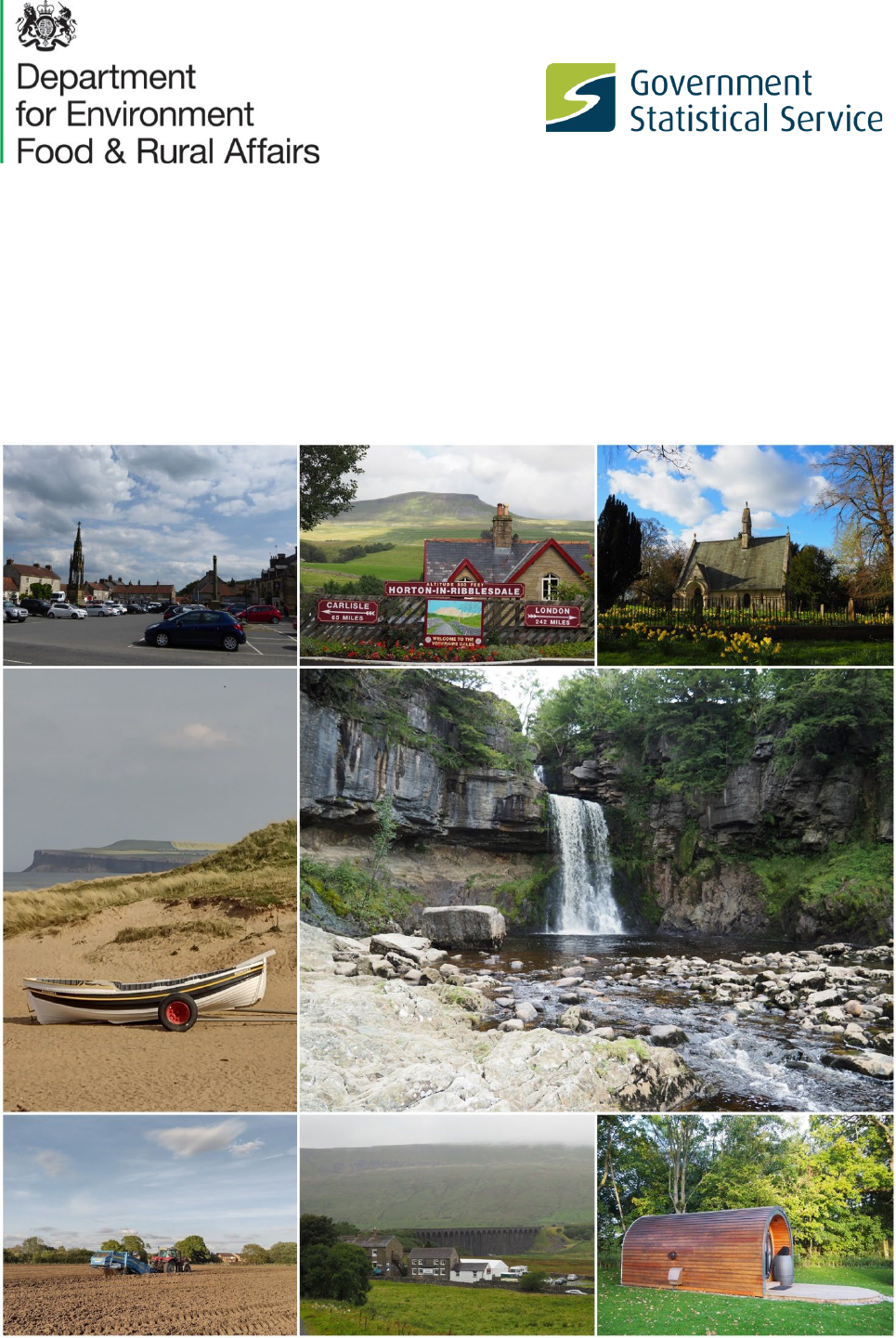
Digest of Rural England: 8 – Energy
1
Statistical Digest of Rural England:
8 - Energy
May 2024
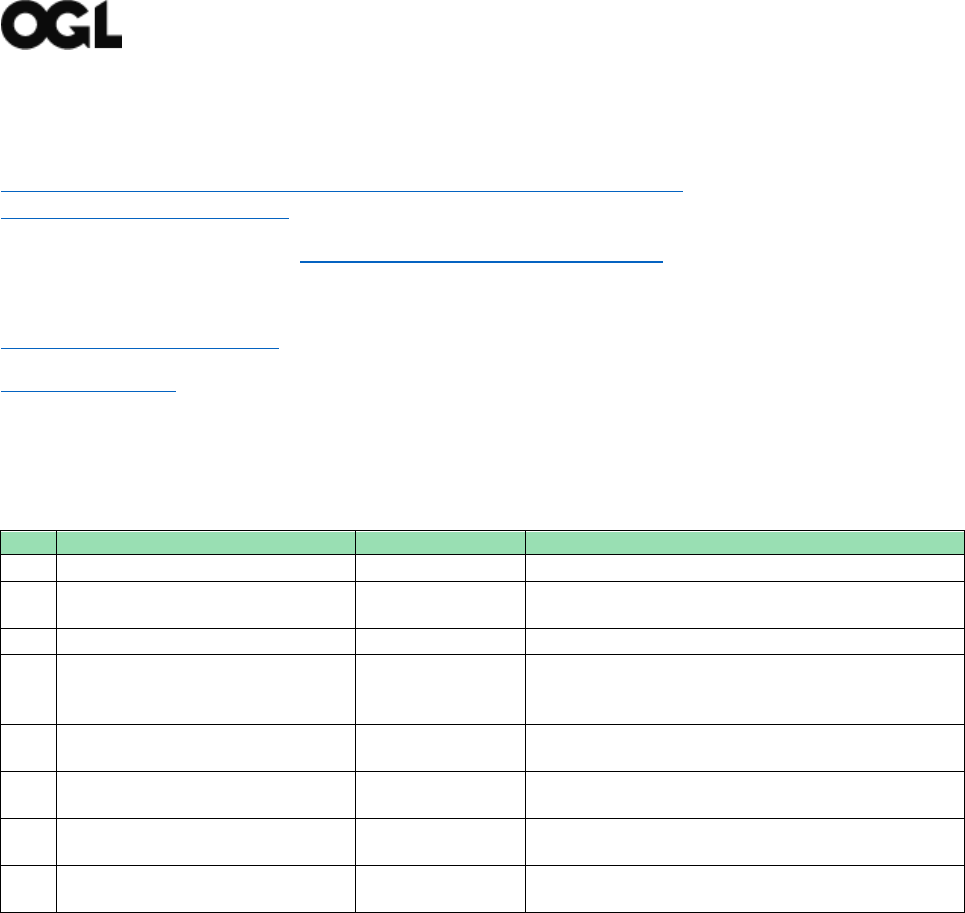
Digest of Rural England: 8 – Energy
2
© Crown copyright 2024
You may re-use this information (excluding logos) free of charge in any format or medium, under
the terms of the Open Government Licence v.3. To view this licence visit
www.nationalarchives.gov.uk/doc/open-government-licence/version/3/
or email
This publication is available at www.gov.uk/government/publications
Any enquiries regarding this publication should be sent to us at
rural.statistics@defra.gov.uk
www.gov.uk/defra
Cover photos
Ward 2011
Rural-Urban Classification
TL
Helmsley marketplace
Helmsley
Rural Village and Dispersed in a sparse setting
TC
Horton-in-Ribblesdale train
station with Penyghent behind
Penyghent Rural Village and Dispersed in a sparse setting
TR
St Giles Church, Skelton
Rural West York
Rural Town and Fringe
CL
Fishing Boat, Marske-by-the-
Sea with Hunt cliff in the
distance
St Germain's;
Saltburn
Rural Town and Fringe
CR
Thornton Force Waterfall,
Ingleton Waterfalls Trail
Ingleton and
Clapham
Rural Village and Dispersed in a sparse setting
BL
Farmer working the fields in
Knapton
Rural West York Rural Town and Fringe
BC
Remote pub at Ribblehead
viaduct
Ingleton and
Clapham
Rural Village and Dispersed in a sparse setting
BR
Glamping pod in the North
York Moors
Pickering East Rural Town and Fringe in a sparse setting
All cover photos provided by Martin Fowell.
Digest of Rural England: 8 – Energy
3
Contents
About the Statistical Digest of Rural England .................................................................................. 5
Official Statistics.............................................................................................................................. 6
Energy ............................................................................................................................................ 7
Fuel poverty - key findings ....................................................................................................... 8
Energy Performance Certificates: average Energy Efficiency Score - key findings................... 9
Energy Performance Certificates: achieving energy efficiency category C - key findings ....... 10
Energy costs - key findings .................................................................................................... 11
Energy consumption - key findings ........................................................................................ 12
A. Fuel poverty ...................................................................................................................... 13
Summary ............................................................................................................................... 13
Defining fuel poverty .............................................................................................................. 14
Fuel poor households ............................................................................................................ 16
Fuel poverty gap .................................................................................................................... 20
Fuel types used for central heating ........................................................................................ 23
Off the gas grid properties ...................................................................................................... 25
Fuel Poverty explanatory notes .............................................................................................. 29
B. Energy Performance Certificates: average Energy Efficiency Score .................................. 33
Summary ............................................................................................................................... 33
Energy Performance Certificates and ratings ......................................................................... 34
Average energy efficiency ...................................................................................................... 34
Average energy efficiency by housing age ............................................................................. 35
Average energy efficiency by housing type ............................................................................ 37
Average energy efficiency by tenure ...................................................................................... 40
Average energy efficiency distributions .................................................................................. 41
EPCs: average Energy Efficiency Score explanatory notes ................................................... 44
C. Energy Performance Certificates: achieving energy efficiency category C ......................... 46
Summary ............................................................................................................................... 46
Minimum energy efficiency of Category C and the link to fuel poverty .................................... 47
Progress towards achieving all homes having a minimum energy efficiency of Category C ... 47
Proportion of Category C properties by property age ............................................................. 48
Proportion of category C properties by property type and tenure ........................................... 52
EPCs: achieving energy efficiency Category C explanatory notes ......................................... 53
D. Energy Costs ..................................................................................................................... 55
Summary ............................................................................................................................... 55
Theoretical rather than actual energy costs ........................................................................... 56
Energy cost: New versus existing properties .......................................................................... 56
Energy cost: Housing type ..................................................................................................... 57
Digest of Rural England: 8 – Energy
4
Energy cost: Housing tenure .................................................................................................. 58
Energy Costs explanatory notes ............................................................................................ 59
E. Energy Consumption ......................................................................................................... 61
Summary ............................................................................................................................... 61
Energy consumption data ...................................................................................................... 62
Energy consumption: Electricity ............................................................................................. 62
Energy consumption: Gas ...................................................................................................... 64
Energy Consumption explanatory notes ................................................................................. 66
Appendix 1: The 8 thematic reports that make up the Statistical Digest of Rural England (and the
topics included within them) .......................................................................................................... 68
Appendix 2: Defining Rural areas .................................................................................................. 69

Digest of Rural England: 8 – Energy
5
About the Statistical Digest of Rural England
The Statistical Digest of Rural England (hereafter the Digest) is a collection of statistics on a range
of social and economic topics and provides broad comparisons between Rural and Urban areas by
settlement type. For more information on our classifications, including maps and diagrams
explaining the classification, see Appendix 2: Defining Rural areas.
The Digest has been restructured into thematic reports and incorporates the previously separate
publication the Rural Economic Bulletin.
The Digest consists of the following thematic reports:
1. Population
2. Housing
3. Health and Wellbeing
4. Communities and Households
5. Connectivity and Accessibility
6. Education, Qualifications and Training
7. Rural Economic Bulletin
8. Energy
In March 2024 the content relating to energy that was previously split across the Housing and
Communities and Households chapters has been consolidated into a new Energy report. Appendix
1, shows the sub-themes within each of the 8 Digest reports. Thematic reports will be updated
individually and not every report with be updated every month. The most recent updates for this
theme are shown in Table 1.
Please note: Energy Performance Certificates and Energy Cost and Consumption were initially
published as single sections and they were split when the new Energy report was created.
Table 1: Update monitor for Energy subsections
where “" indicates the topic has been updated, “" indicates the topic has not been updated,
and “New” indicates a new topic with analysis not previously included within the Digest.
Section April 2023 May 2023 August 2023 February 2024 May 2024
Fuel poverty
Energy Performance Certificates:
average Energy Efficiency Score
New
Energy Performance Certificates:
achieving energy efficiency
category C
New
Energy costs
New
Energy consumption
New

Digest of Rural England: 8 – Energy
6
Official Statistics
These statistics have been produced to the high professional standards set out in the Code of
Practice for Official Statistics, which sets out eight principles including meeting user needs,
impartiality and objectivity, integrity, sound methods and assured quality, frankness and
accessibility.
More information on the Official Statistics Code of Practice can be found at:
Code of Practice for
Statistics.
This publication has been compiled by the Rural Statistics Team within the Rural and Place Team
in Defra:
Stephen Hall
Sarah Harriss
Beth Kerwin
Martin Fowell
rural.statistics@defra.gov.uk
There is a 2011 Census version of the Digest which looks at the data from the 2011 Census and
where possible makes comparisons to the 2001 Census results.
This can be found at
https://www.gov.uk/government/statistics/2011-census-results-for-rural-
england
Analysis of the 2021 Census will follow the release of a 2021-based Rural-Urban Classification.
Digest of Rural England: 8 – Energy
7
Energy
This part of the Statistical Digest of Rural England focuses on Housing, and covers the following:
• fuel poverty (Section A)
• average Energy Efficiency Scores from Energy Performance Certificates (Section B)
• properties achieving energy efficiency category C (Section C)
• energy costs (Section D)
• energy consumption (Section E)
The key findings from this chapter are summarised with the following set of headline clouds:

Digest of Rural England: 8 – Energy
8
Fuel poverty - key findings
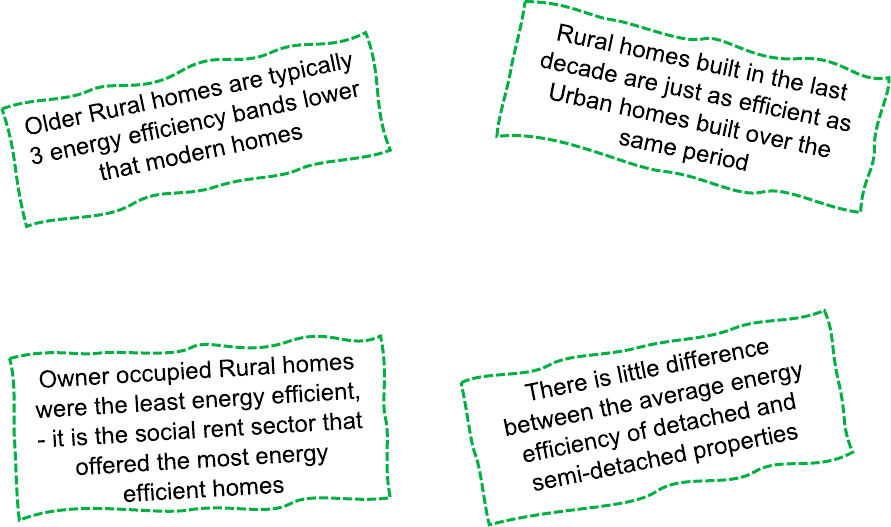
Digest of Rural England: 8 – Energy
9
Energy Performance Certificates: average Energy Efficiency Score - key
findings
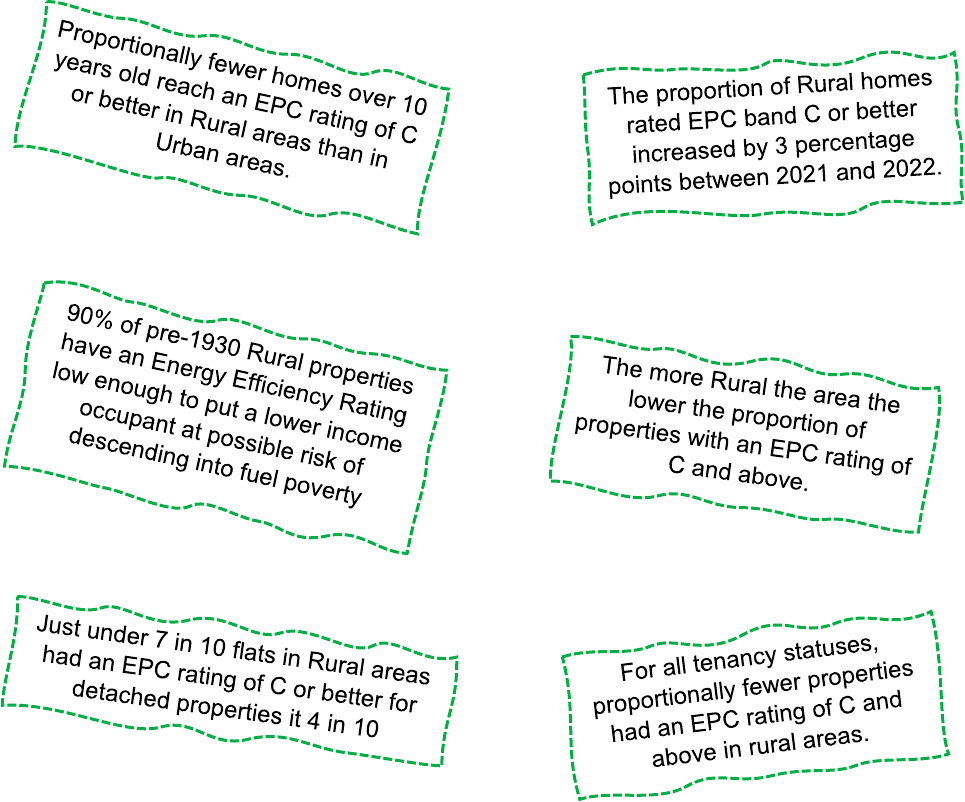
Digest of Rural England: 8 – Energy
10
Energy Performance Certificates: achieving energy efficiency category
C - key findings
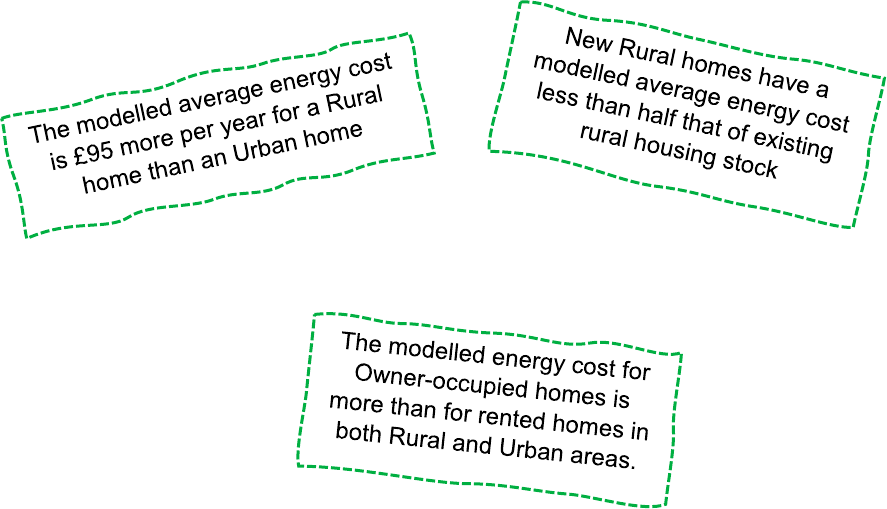
Digest of Rural England: 8 – Energy
11
Energy costs - key findings
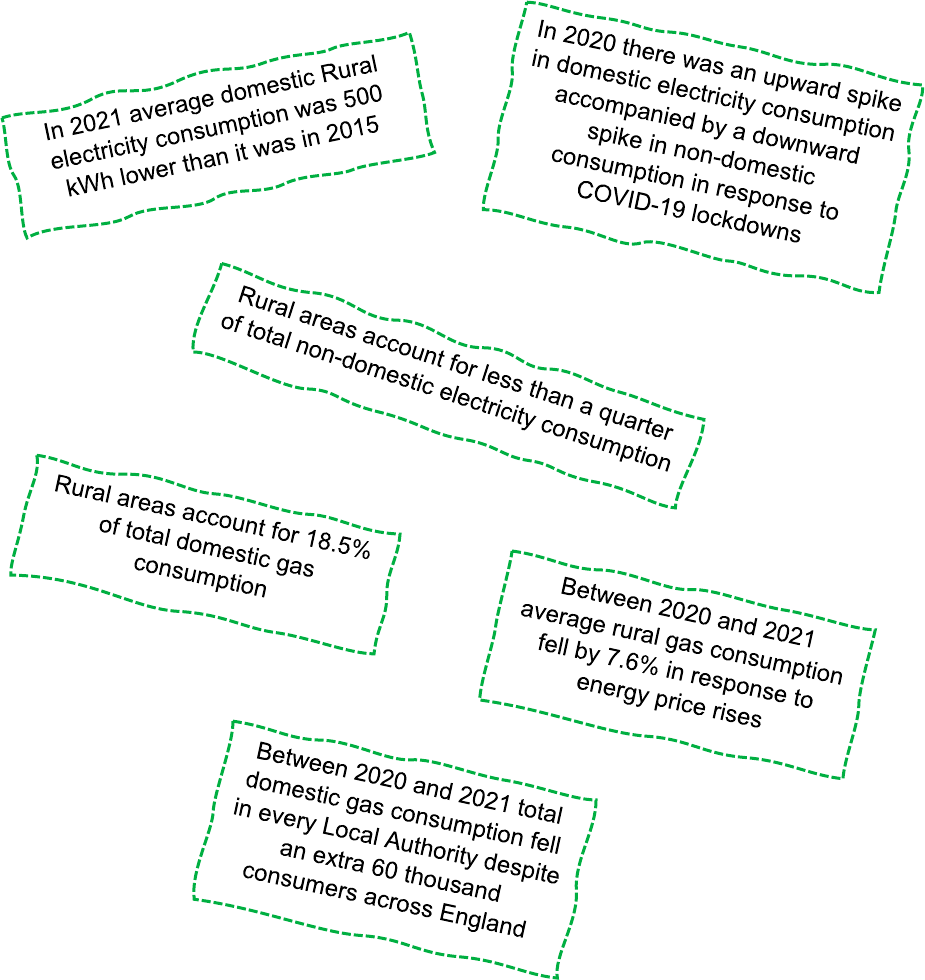
Digest of Rural England: 8 – Energy
12
Energy consumption - key findings
Digest of Rural England: 8 – Energy
13
A. Fuel poverty
There is a higher proportion of fuel poor households in Rural areas than in Urban areas and
the depth of the fuel poverty for these Rural households is greater, especially if their homes
are off the gas grid.
Summary
Households in fuel poverty are those living in a property with a Fuel Poverty Energy Efficiency
Rating of band D or below in a home that cannot be kept warm at reasonable cost without bringing
their residual income below the poverty threshold. There are 3 key elements (drivers) in
determining whether a household is fuel poor: (1) household income; (2) household energy
efficiency; and (3) fuel prices. The fuel poverty gap (£) is an estimate of the depth of fuel poverty,
and it can be either the reduction in fuel costs or the increase in household income needed for a
household to not be in fuel poverty.
In 2023, the proportion of fuel poor households was higher in Rural areas (13.9%) than in Urban
areas (12.8%). This corresponds to 590,000 households in Rural areas. In Rural areas the
proportion of fuel poor households in 2023 is 2.3 percentage points higher than in 2019 (the first
year under the current methodology). By contrast in Urban areas the proportion of fuel poor
households was 1.1 percentage points lower in 2023 than it was in 2019. So, over the last 5 years,
levels of fuel poverty have risen in Rural areas, but they have fallen in Urban areas.
Households in Rural areas had an average fuel poverty gap of £568 in 2023 - this is £186 more
than the average fuel poverty gap of £382 in Urban areas. Over the last 5 years, the average fuel
poverty gap for Rural households has increased from £413 (in 2019) to £568 (in 2023), which is an
increase of £155 (or 38%). For the 62,000 fuel poor Rural households living in the least energy
efficient houses, the average fuel poverty gap was more than £1,800, whereas in 2019, the
average fuel poverty gap for those households living in these houses with the poorest energy
efficiency rating was £1,200.
The most common way of heating a home is through mains gas central heating. In Predominantly
Rural areas only 72% used mains gas in 2023 compared to 83% in Predominantly Urban areas. Oil
played a greater part in the heating fuel picture in Predominantly Rural areas (10% of homes) than
in Predominantly Urban areas (0.4% of homes).
In Predominantly Rural areas one in four properties (24.5%) were off the gas grid in 2022
compared to 11.5% in Predominantly Urban areas. Around a quarter of Predominantly Rural Local
Authorities have at least 35% of domestic properties off the gas grid. In absolute terms, 1.4 million
properties in Predominantly Rural areas are off the gas grid and this value has been stable over
the 2015 to 2021 period. Overall, there is a greater proportion of off-grid households in fuel poverty
than on-grid households and over the last decade more progress has been made in moving on-grid
households out of fuel poverty than for off-grid households. The depth of the fuel poverty for those
who are fuel poor is also greater when the household is off-grid rather than on it. In 2023 the
average fuel poverty gap for off-grid households was around £800 compared to around £320 for
on-grid households.

Digest of Rural England: 8 – Energy
14
Defining fuel poverty
Fuel poverty or being fuel poor is where a household is living in a property with a Fuel Poverty
Energy Efficiency Rating (FPEER) of band D or below in a home that cannot be kept warm at
reasonable cost without bringing their residual income below the poverty threshold. As explained in
Note A-5., there are therefore three key elements (drivers) in determining whether a household is
fuel poor: (1) household income; (2) household energy efficiency; and (3) fuel prices. The 2014 fuel
poverty target for England set an objective to ensure that as many fuel poor households as
reasonably practicable achieved a minimum energy efficiency rating of band C by 2030 (Note A-1)
Low Income High Costs (LIHC) was the preferred metric for measuring fuel poor households from
2011 to 2018. Note A-2
explains how LIHC was defined. For data representative of 2019 onwards
(Note A-3) the Department for Energy Security and Net Zero (DESNZ) uses Low Income Low
Energy Efficiency (LILEE) as the preferred metric. Estimates for both metrics were produced for
2019 to allow a comparison.
Based on household income and the energy efficiency of their home, all households can be divided
into 4 groups (Figure A-1). If their property FPEER is of band D (Note A-4) or below (under the
solid horizontal line on Figure A-1) they are defined as Low Energy Efficiency (LEE) and if the
FPEER is C or above they are defined as High Energy Efficiency (HEE). When assessing fuel
poverty, the income used in the assessment is the income available after housing costs, tax and
national insurance. The income threshold for fuel poverty is shown as a “best fit” sloped dashed
line on Figure A-1. The line is sloped because the less energy efficient the home the greater the
impact of fuel costs on available income. Households to the left of the sloped line are defined Low
Income (LI) and those to the right of the line are defined as High Income (HI). The lower left group
therefore becomes Low Income Low Energy Efficiency (LILEE), these are the fuel poor
households. In 2023 13.0% of households in England were defined as fuel poor. Note A-5 provides
more details on the LILEE methodology.
The fuel poverty gap is an estimate of the depth of fuel poverty. The fuel poverty gap is the
reduction in fuel costs needed for a household to not be in fuel poverty. As shown in Figure A-2 a
household can escape fuel poverty by increasing the energy efficiency of their home to a FPEER
of at least Band C or by crossing the income threshold. Crossing the income threshold could be
achieved by increasing the absolute household income through things like gaining employment or
increasing their salary by getting a better paid job or government intervention.
Using the two example households in Figure A-2, one household is in a home that is very energy
inefficient, but their household income is close to the income threshold. For this type of household
reducing fuel costs or increasing income brings them out of fuel poverty more easily than by
increasing the efficiency of their home. The second illustrative household has very Low Income but
a more efficient home than the first example. For this household improving energy efficiency would
move them out of fuel poverty.
As shown in the Statistical Digest of Rural England:2 – Housing
, housing in Rural areas is more
likely to be detached and much less likely to be flats than in Urban areas. There is also a higher
proportion of Rural housing that is more than 100 years old (
Note A-6). In 2019 the Energy Savings
Trust stated that nearly 20% of homes in rural areas are in the very energy inefficient F and G
categories, compared to just 2.4% in urban areas (Note A-7). Figures from the DESNZ / BEIS 2022
Fuel Poverty Statistics suggest that this 20% is an overestimate. These 2023 figures show that
6.8% of Rural households are living in properties that are rated F or G compared to 1.4% of
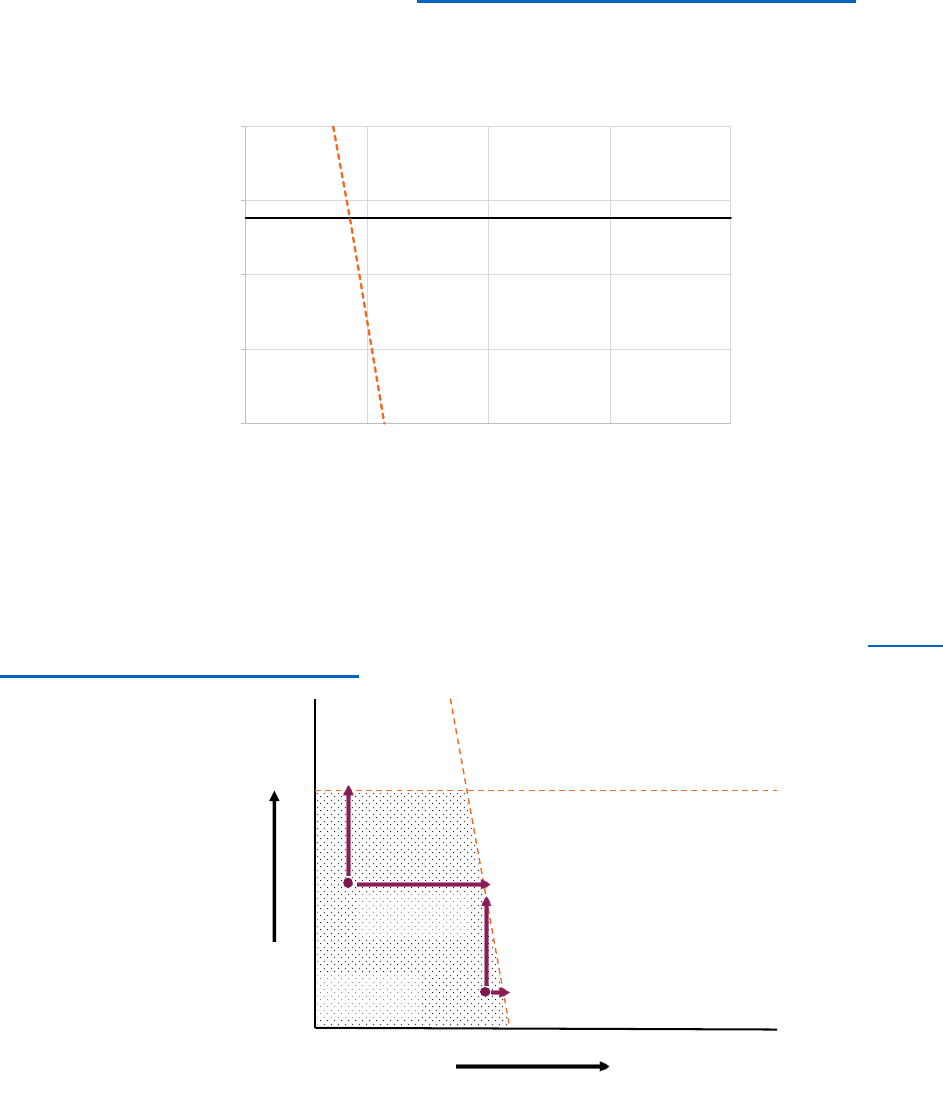
Digest of Rural England: 8 – Energy
15
households in Urban areas. More information on the energy efficiency of homes can be found in
the Energy Performance Certificates sections of this report (Section B and C).
In Predominantly Rural areas there is also a greater reliance on heating oil than in Predominantly
Urban areas - see the “Fuel types used for central heating” section. Unlike domestic gas prices,
there is no cap on domestic oil prices, so there is the potential for it to be more expensive to heat a
home with heating oil than gas.
Figure A-1: A schematic diagram to show how fuel poor households were defined in 2023
The numbers in percentages are the proportion of households in 2023 in each of the 4 groups.
This diagram is based on Figure 2.2 in the Annual fuel poverty statistics report: 2024
publication. FPEER on the Y-axes is Fuel Poverty Energy Efficiency Rating. LI and HI are High and
Low Income respectively. HEE and LEE are High and Low Energy Efficiency respectively.
Figure A-2: A schematic diagram representing the fuel poverty gap
The hatched area represents those households in fuel poverty and the arrows represent the
property energy efficiency or household income gains that 2 households (represented by the small
circles) would need to make to exit fuel poverty. This diagram is based on Figure 1 in the Annual
fuel poverty statistics report: 2023 publication.
0
25
50
75
100
0 20,000
40,000 60,000
80,000
FPEER
Income (£)
LILEE
(fuel poor)
13.0%
HILEE
36.4%
HIHEE
35.4%
LIHEE
15.2%
Energy Efficiency
Band C
Income threshold
Increasing
FPEER
Increasing household income
Energy Efficiency
Band C
Income threshold (£)
LILEE Fuel
Poverty
Fuel Poverty
Gap
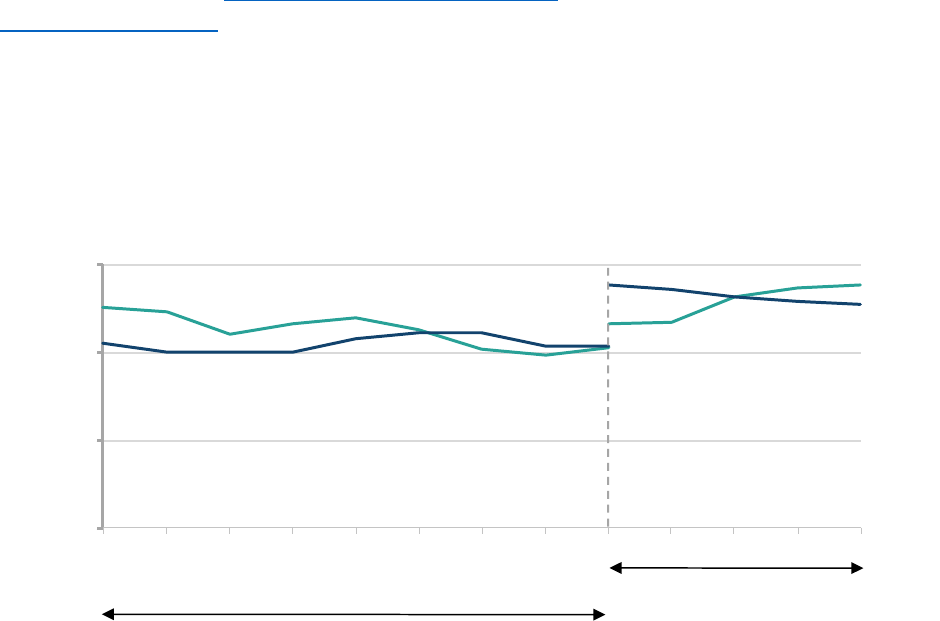
Digest of Rural England: 8 – Energy
16
Fuel poor households
There were 3.2 million fuel poor households in England in 2023 (see Figure A-1 for a definition of
fuel poor). In Rural areas there was 590 thousand fuel poor households and in Urban areas there
was 2.6 million fuel poor households. As Figure A-3 shows, historically between 2011 and 2015
fuel poverty was proportionately more prevalent in Rural areas than in Urban areas under the old
LIHC metric. In 2017 and 2018 fuel poverty was marginally more prevalent in Urban areas than in
Rural. In 2019 under LIHC there was 10% of households in fuel poverty in both Rural and Urban
areas.
The change of in methodology from LIHC to LILEE as the preferred metric resulted in increases of
1.3 percentage points in fuel poor Rural households and 3.4 percentage points in fuel poor Urban
households (Figure A-3). Unlike some other variables a consistent time series under the LILEE is
not included within the long-term fuel poverty trend tables
that are updated annually as part of the
Fuel Poverty Statistics publication (Note A-8).
Figure A-3: Line chart showing the proportion of fuel poor households (%) in Rural and
Urban areas (2011 to 2023).
Low Income High Costs (LIHC) was the preferred metric from 2011 to 2018 (Note A-2). From 2019
onwards Low Income Low Energy Efficiency (LILEE) became the preferred metric (Note A-5). The
series break for the change in methodology is shown by a dashed vertical line.
Under LILEE fuel poverty was more prevalent in Urban areas than in Rural in 2019 and 2020. In
2021 the proportion of Rural households in fuel poverty rose while falling in Urban areas and the
proportion of fuel poor households was 13.1% in both Rural and Urban areas. In both 2022 and
2023 the proportion of fuel poor households was higher in Rural areas than in Urban areas. In
2023 13.9% of Rural households were fuel poor compared to 12.8% of Urban households. This
means that in 2023 there were 590,000 fuel poor households in Rural areas.
Comparing 2023 to 2019 (the first year under LILEE), we see that the proportion of fuel poor
households in Rural areas in 2023 is 2.3 percentage points higher than in 2019. By contrast in
Urban areas the proportion of fuel poor households was 1.1 percentage points lower in 2023 than it
was in 2019. In other words, over the last 5 years, levels of fuel poverty have fallen in Urban areas,
but they have risen in Rural areas. Note that over the last 12 months the proportion of fuel poor in
Rural areas has gone up by 0.2 percentage points, while it has gone down by 0.2 percentage
points in Urban areas.
0
%
5%
10%
15
%
2011 2012 2013 2014 2015 2016 2017 2018 2019 2020 2021 2022 2023
LIHC m etric
LILEE metric
Urban
Rural
Methodological change
Rural
Urban
Digest of Rural England: 8 – Energy
17
DESNZ produces sub-regional fuel poverty data as Experimental Statistics (Note A-15). Estimates
at the sub-regional level are modelled using proxy indicators available for low level geographies
and should only be used to look at general trends and identify areas of particularly high or low fuel
poverty. They should not be used to identify detailed trends over time. In 2013, BEIS undertook an
internal review of the methodology used to produce sub-regional estimates of fuel poverty, in
conjunction with Office for National Statistics (ONS) Methodology Advisory Service. This review
found that estimates of fuel poverty were robust at Local Authority level, but not robust at lower
levels of geography. We are therefore introducing Rural and Urban maps of the proportion of
households in fuel poverty at Local Authority level (Figure A-4 and Figure A-5) to the Digest, but
will not be producing them at more detailed levels of geography. At the time of producing this
update DESNZ has not released any more recent sub-regional fuel poverty data, therefore Figure
A-4 and Figure A-5 have not been revised.
Within Rural areas (Figure A-4) the proportion of households classified as fuel poor is highest in
the Local Authorities along the England and Wales border. Local Authority boundaries changed in
April 2023 in both North Yorkshire and Cumbria. This has reduced the number of Local Authorities
in the North (Note A-16). Using these new boundaries, north of the Humber only three Local
Authorities have less than 14% of households in fuel poverty. In East Anglia there are
proportionally more households in fuel poverty in coastal Local Authorities than in those further
inland. Proportionally more households are in fuel poverty in the three Local Authorities making up
northern and western Devon than in other Local Authorities in South West England. Within the
East Midlands region there is proportionally more fuel poverty in Northern and Eastern Lincolnshire
and in much of Derbyshire than in southern parts of this region.
In summary, Figure A-4 shows Rural fuel poverty is above average in in Cumbria, Yorkshire,
Durham, Lincolnshire, coastal areas of East Anglia, along the England / Wales border and in north
west Devon and below average Rural fuel poverty in the Local Authorities of the South East region.
Figure A-5 shows the proportion of households classified as fuel poor in Urban Local Authorities. In
general terms, as for Rural areas, Local Authorities with below average fuel poverty tend to be in
the South East and those with above average fuel poverty tend to be in the North or the Midlands.
Notable exceptions in the South East are above average fuel poverty in parts of central London. In
the North East there is proportionally more fuel poverty on Teesside than in Tyne and Wear.
Within Yorkshire and the Humber, York has lower levels of fuel poverty than the Urban authorities
of South and West Yorkshire. In general, Local Authorities in the North West have lower levels of
fuel poverty than in Yorkshire and the Humber, particularly in the south and centre of the area.
However, there are still pockets of higher fuel poverty such as on Merseyside and in northern and
eastern parts of the area such as Blackpool and Burnley. Of the six Urban Local Authorities where
more than 20% of households are fuel poor, five are in the West Midlands.
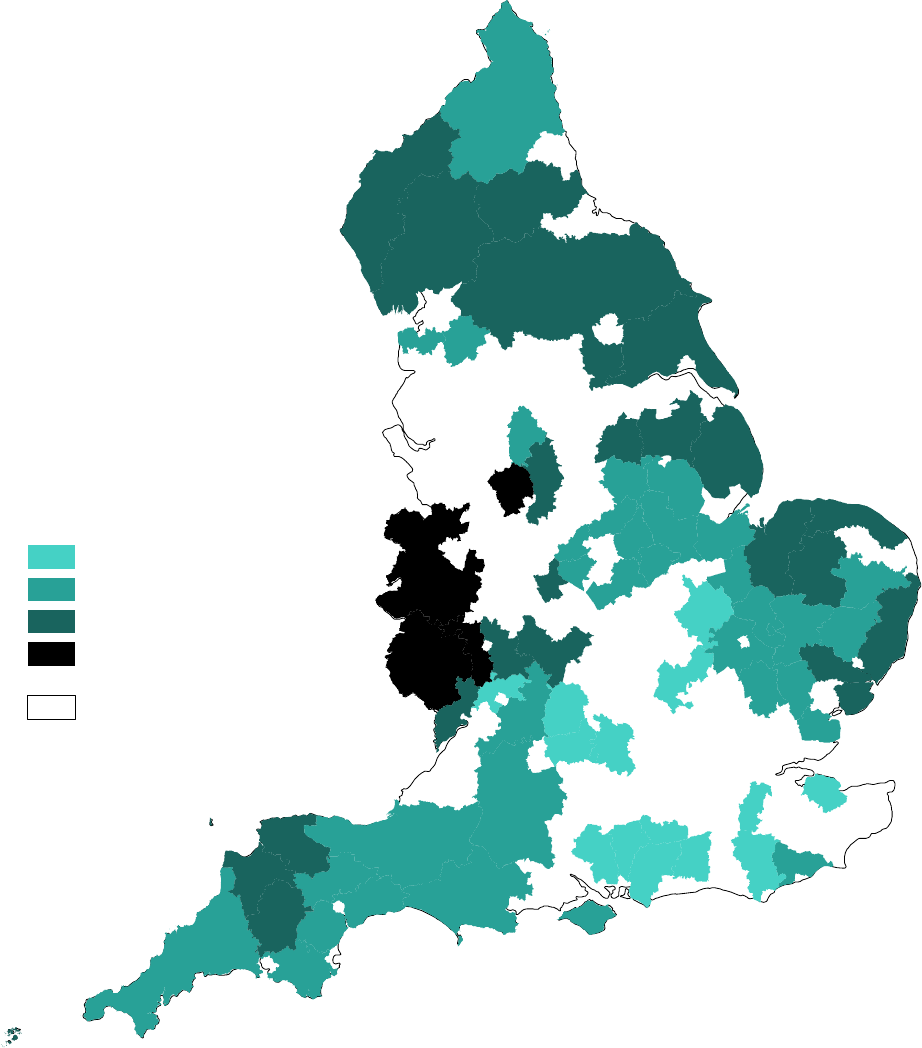
Digest of Rural England: 8 – Energy
18
Figure A-4: Map of the proportion (%) of households in Rural areas that are fuel poor
according to the LILEE definition in 2021
The darker the shading the higher the proportion of households that are fuel poor. White areas on
the map and Predominantly Urban or Urban with Significant Rural areas. This map uses Local
Authority boundaries applicable from 1 April 2023. At the time of producing this update DESNZ
have not released any more recent sub-regional fuel poverty data, therefore this map has not been
revised. (Note A-15, Note A-16)
P r o p o r t i o n o f h o u s e h o l d s c l a s s e d
a s f u e l p o o
r
i n R u r a l a r e a s
P r e d o m i n a n t l y U r b a n , o r
U r b a n w i t h S i g n i f i c a n t R u r a l
L e s s t h a n 1 0 %
1 0 % o r m o r e , b u t l e s s t h a n 1 4 %
1 4 % o r m o r e , b u t l e s s t h a n 1 8 %
1 8 % o r m o r e
© C r o w n C o p y r i g h t a n d d a t a b a s e r i g h t s 2 0 2 3
O r d n a n c e S u r v e y L i c e n c e N o . 1 0 0 0 2 2 8 6 1
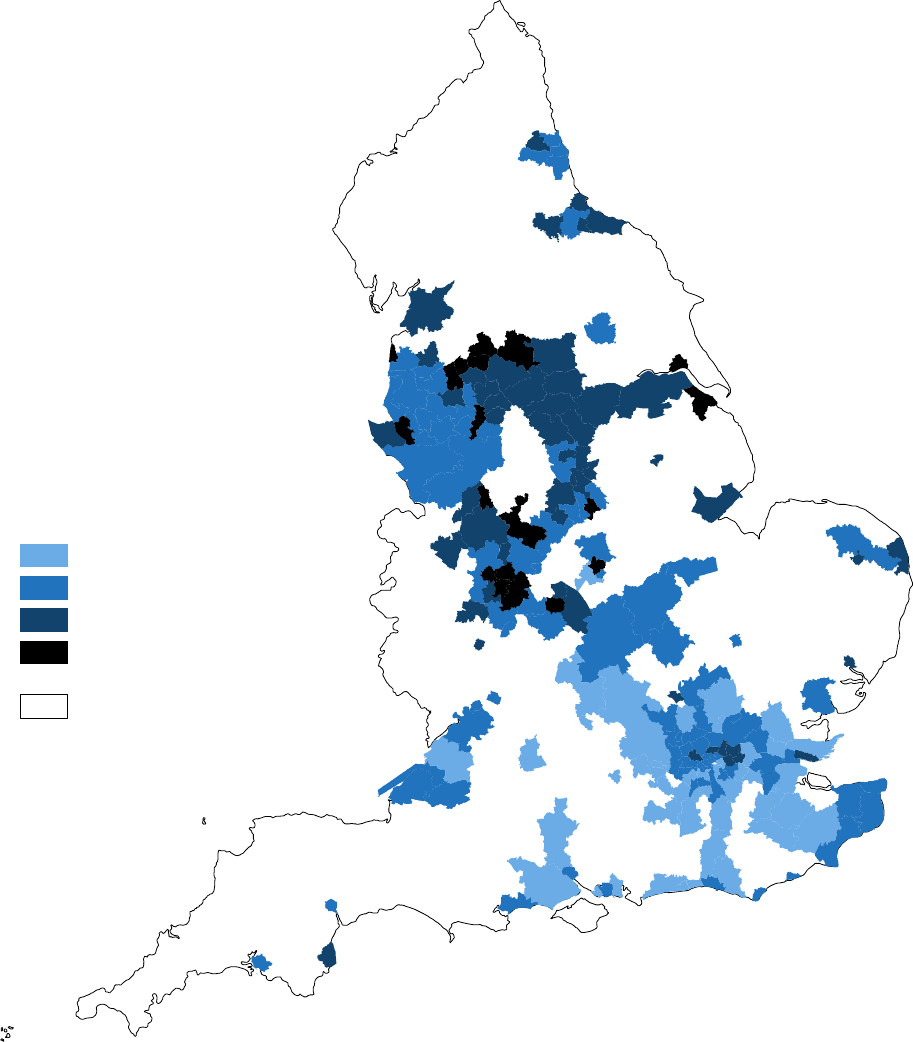
Digest of Rural England: 8 – Energy
19
Figure A-5: Map of the proportion (%) of households in Urban areas that are fuel poor
according to the LILEE definition in 2021
The darker the shading the higher the proportion of Urban households that are fuel poor. White
areas on the map are Predominantly Rural. This map uses Local Authority boundaries applicable
from 1 April 2023. At the time of producing this update DESNZ have not released any more recent
sub-regional fuel poverty data, therefore this map has not been revised. (Note A-15, Note A-16)
© C r o w n C o p y r i g h t a n d d a t a b a s e r i g h t s 2 0 2 3
O r d n a n c e S u r v e y L i c e n c e N o . 1 0 0 0 2 2 8 6 1
P r o p o r t i o n o f h o u s e h o l d s c l a s s e d
a s f
u
e l p o o
r
i n U r b a n a r e a s
L e s s t h a n 1 0 %
1 0 % o r m o r e , b u t l e s s t h a n 1 4 %
1 4 % o r m o r e , b u t l e s s t h a n 1 8 %
1 8 % o r m o r e
P r e d o m i n a n t l y R u r a l

Digest of Rural England: 8 – Energy
20
Notes
• DESNZ / BEIS changed their preferred fuel poor metric from Low Income High Costs (LIHC) to Low
Income Low Energy Efficiency (LILEE). Note A-5 explains how LILEE is calculated. In 2019 DESNZ /
BEIS produced both estimates, so both are shown on Figure A-3. The dashed line represents the
change of metric.
• In Sub-regional fuel poverty 2023 (2021 data)
published in April 2023 DESNZ published on the basis of
the Local Authorities that applied from 1 April 2023 despite the data being representative of 2021. This
means that unlike other analysis in the Digest,
Figure A-4 and Figure A-5 are on the basis of only 296
Local Authorities rather than the 309 detailed in Appendix 1: Defining Rural areas. At the time of
preparing the most recent update 2021 was the most recent sub-regional data available.
Fuel poverty gap
As explained in the “Defining fuel poverty” section, the fuel poverty gap (£) is an estimate of the
depth of fuel poverty, and it can be either the reduction in fuel costs or the increase in household
income needed for a household to not be in fuel poverty. Figure A-6 shows that over the period
2011 to 2023 the average fuel poverty gap (or depth of the fuel poverty) was greater in Rural areas
than in Urban areas in every year over this 13-year period. The change of methodology does not
affect this conclusion, but the average difference between the Rural and Urban fuel poverty gaps
was bigger for the years covered by LIHC (average difference between Rural and Urban gaps of
£278) than for the period from 2019 onwards under LILEE (average difference between Rural and
Urban gaps of £174). In England, the average fuel poverty gap for households that were fuel poor
in 2023 was £417, this is an increase compared to 2022 when it was £325.
DESNZ have revised their estimates of the fuel poverty gap in 2022 for Rural areas downwards.
Their initial estimate published in 2023 showed that households in Rural areas had an average fuel
poverty gap of £677 in 2022. In the February 2024 release they showed that households in Rural
areas had an average fuel poverty gap of £432 in 2022 – almost £250 less that the initial release.
By contrast DESNZ have revised the average fuel poverty gap for households in Urban areas
upwards to £302. This means that in 2022 the fuel poverty gap was £130 (or over 40%) deeper in
Rural areas than in Urban areas. The fuel poverty gap for fuel poor households in Rural Villages,
Hamlets and Isolated Dwellings in 2022 was a large contributor to this revision because it was
revised down from £956 to £569. There is a table showing fuel poverty figures by RUC category in
Energy data tables
.
In 2023 the average fuel poverty gap for households in Rural areas was £568, this is £186 more
than the average fuel poverty gap of £382 in Urban areas. So, in 2023 fuel poverty was almost
50% deeper in Rural areas than in Urban areas. The fuel poverty gap for fuel poor households in
Rural Villages, Hamlets and Isolated Dwellings in 2023 was £778.
The average fuel poverty gap in 2023 in Rural areas was £136 more than it was in 2022 (32%
higher), whereas for Urban areas it was only £80 more than in 2022 (26% higher). When the
comparison is made to 2019 (the first year under LILEE) we see that the average fuel poverty gap
for Rural households has increased from £413 to £568, which is an increase of £155 (or 38%). By
contrast for Urban households the fuel poverty gap has more than doubled, increasing from £180
in 2019 to £382 in 2023.
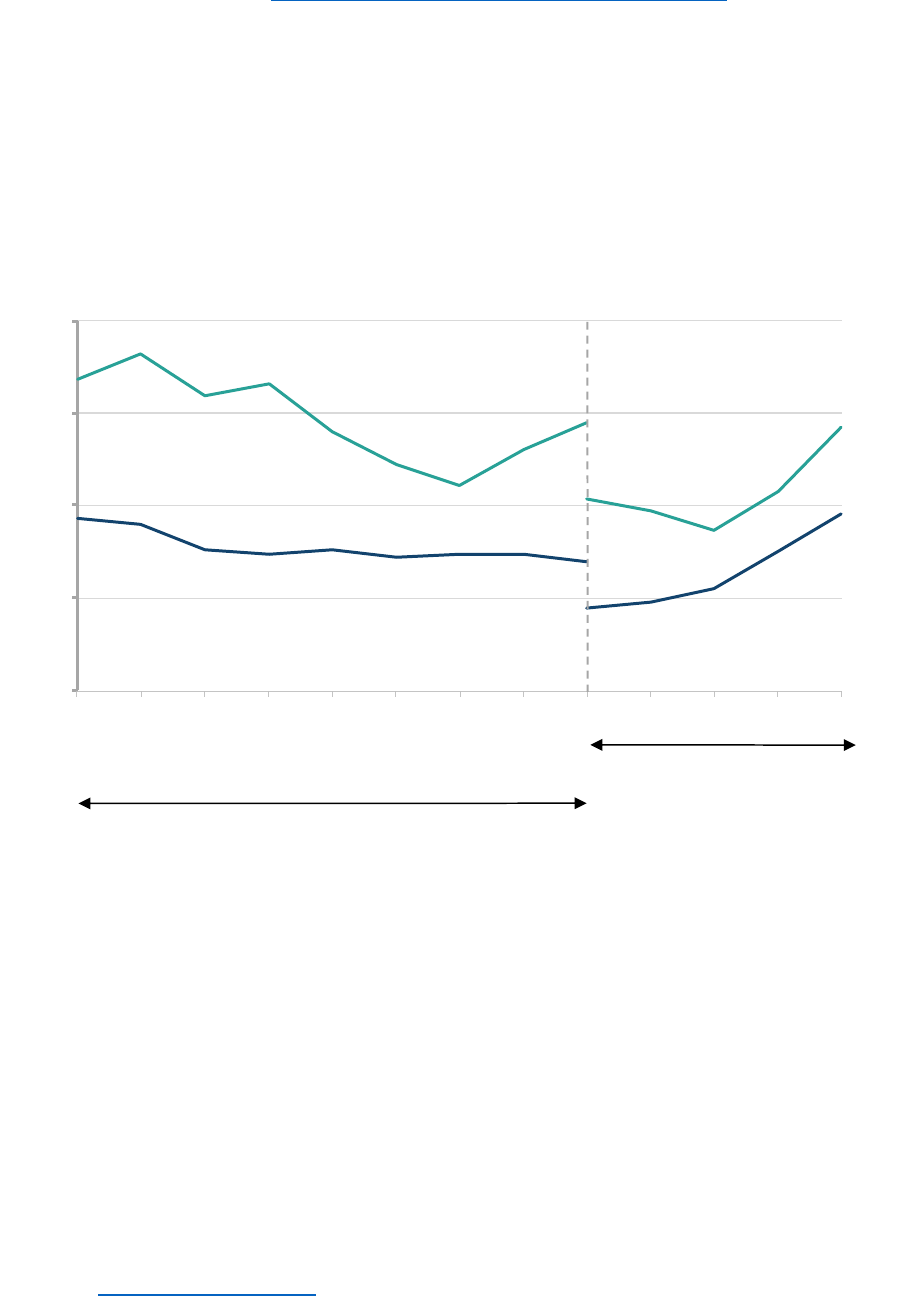
Digest of Rural England: 8 – Energy
21
The increasing depth of fuel poverty is a response to the rising energy costs in recent years. The
fact that the depth of the fuel poverty in Rural areas has risen more than in Urban areas over the
last 12 months is likely to be as a consequence of houses in Rural areas being typically larger, and
often older, than Urban ones (Statistical Digest of Rural England:2 – Housing
). These two factors
make them less energy efficient (sections B and C) and therefore more costly to heat (Section D).
In other words, the more units of energy you use to heat your home the more you are affected by
the increased cost of each of those energy units.
Figure A-6: Line chart showing the average fuel poverty gap (£) in Rural and Urban areas
(2011 to 2023).
Low Income High Costs (LIHC) was the preferred metric from 2011 to 2018 (Note A-2). From 2019
onwards Low Income Low Energy Efficiency (LILEE) became the preferred metric (Note A-5). The
series break for the change in methodology is shown by a dashed vertical line
Using the previous LIHC metric the average fuel poverty gap for Urban households decreased
between 2011 and 2019, while for Rural households the gap also decreased between 2012 and
2017, but the Rural fuel poverty gap then deepened between 2017 and 2019 (Figure A-6).
The Fuel Poverty Energy Efficiency Rating (FPEER) is a measure of the energy efficiency of a
property (Note A-4). As shown on Figure A-7, in 2023 Rural households with the poorest FPEER
rating of F or G had an average fuel poverty gap of over £1,800, which is similar to the average
fuel poverty gap for Urban households of the same energy rating. In the revised 2022 figures the
average fuel poverty gap for those Rural households in homes with the poorest FPEER rating of F
or G was £1,300. For further context in 2019, the average fuel poverty gap for those households
living in these houses with the poorest energy efficiency rating was £1,200 in Rural areas and £860
in Urban areas. 290,000 Rural households still lived in the least energy efficient homes in 2023; the
62,000 of those who are in fuel poverty have seen the depth of their fuel poverty increase
substantially in a very short time period because energy costs have risen rapidly.
In the latest Fuel Poverty Statistics DESNZ consider fuel poverty by property characteristics (
Note
A-9). DESNZ reported that the fuel poverty gap was largest for converted flats (£597) and
£0
£200
£400
£600
£800
2011 2012 2013 2014 2015 2016 2017 2018 2019 2020 2021 2022 2023
LIHC m etric
LILEE metric
Rural
Urban
Methodological changeAverage fuel poverty gap
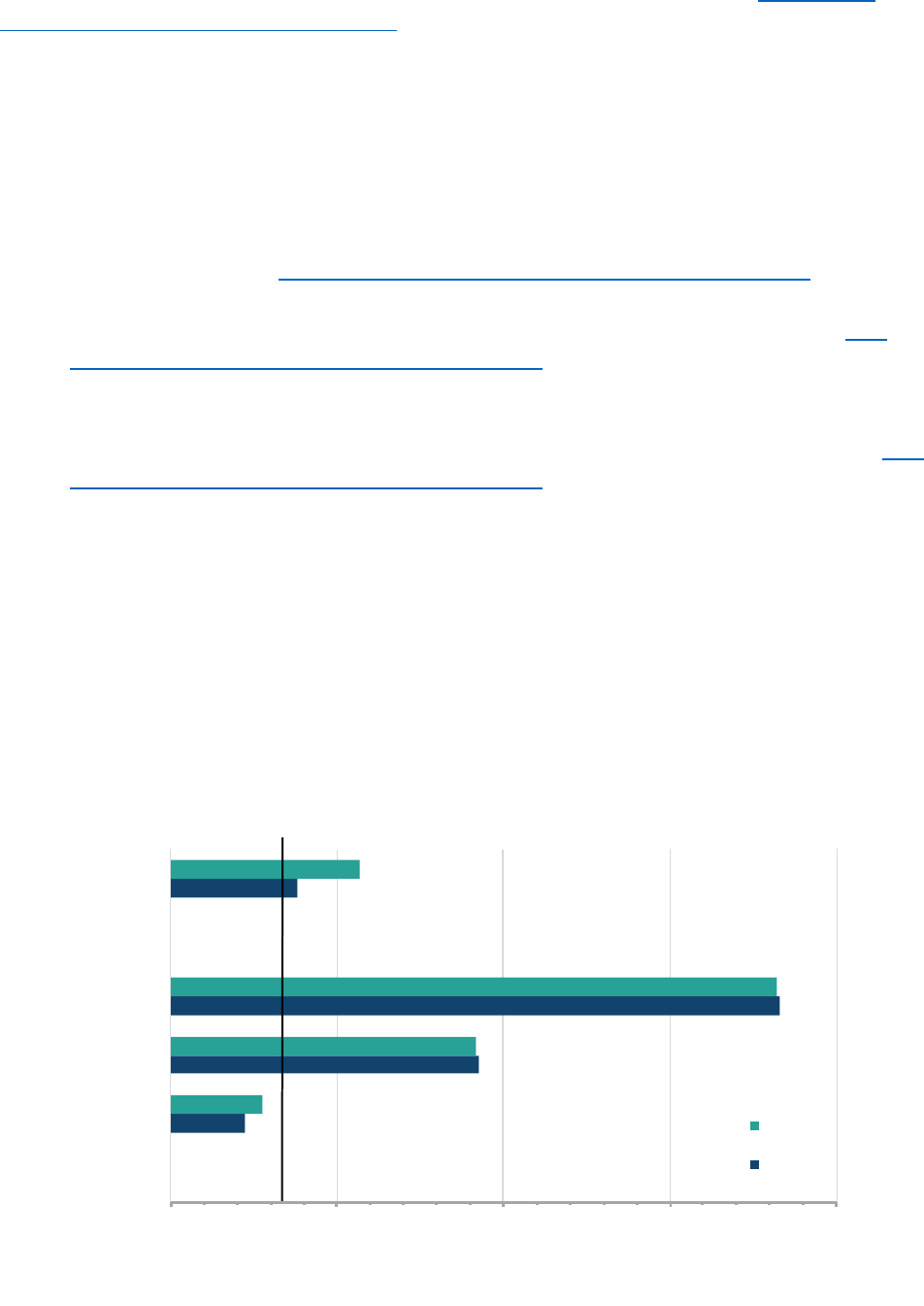
Digest of Rural England: 8 – Energy
22
households living in converted flats were more likely to be in fuel poverty than households in any
other property type. The average fuel poverty gap for households in detached properties was the
only other one that exceeded £500. Comparing an end terrace to a mid-terrace (
Fuel poverty
detailed tables 2024 (2023 data) - Table 7) shows that 3.3% fewer households in a mid-terrace are
in fuel poverty than for households in an end terrace and when the households are fuel poor the
average depth of the fuel poverty is £127 less for a mid-terrace than an end terrace. This matters
in a rural context because the average urban terrace is 50% longer than the average rural terrace,
so there are proportionally fewer mid terraced properties in rural areas (
Note A-6).
DESNZ also report that:
• the average depth of fuel poverty is higher for households in properties with solid walls than
for those in homes with cavity walls, even if the solid walls have been insulated and the
cavity walls have not (Fuel poverty detailed tables 2024 (2023 data) - Table 15
);
• the larger the floor area the higher the average fuel poverty gap for fuel poor residents, with
the value reaching £554 for households in properties with floor areas over 110m
2
(Fuel
poverty detailed tables 2024 (2023 data) - Table 9); and
• the depth of fuel poverty is much higher for households in pre-1919 properties (£575) than
for households in properties built after this date, but it is not correct to assume that the
newer the property the lower the average fuel poverty gap for any fuel poor residents (
Fuel
poverty detailed tables 2024 (2023 data) - Table 8).
All 3 of these property characteristics (solid walls, bigger and older properties) are more prevalent
in Rural areas than Urban areas. For example, there are over 1 million pre-1919 homes in rural
areas and they account for 28% of rural residential properties compared to only 18% of urban
residential properties (Note A-6).
Figure A-7: Bar chart showing average fuel poverty gap (£) in Rural and Urban areas in 2023
according to Fuel Poverty Energy Efficiency Rating (FPEER) band
(Note A-2, Note A-4, Note A-5)
The legend is presented in the same order as the clusters of bars.
0 500 1,000 1,500 2,000
A/B/C
D
E
F/G
All
Average fuel poverty gap (£)
FPEER band
Rural
Urban
Average fuel poverty gap in England (£417)

Digest of Rural England: 8 – Energy
23
Notes
• DESNZ / BEIS changed their preferred fuel poor metric from Low Income High Costs (LIHC) to Low
Income Low Energy Efficiency (LILEE). Note A-5 explains how LILEE is calculated. In 2019 DESNZ /
BEIS produced both estimates, so both are shown on Figure A-6. The dashed line represents the
change of metric.
• On Figure A-7 the black vertical line represents the average fuel poverty gap for all households in fuel
poverty. Only households living in a dwelling with an FPEER of band D-G (Note A-4 and Figure A-1) are
categorised as ‘Low Energy Efficiency’ and are therefore at risk of being in fuel poverty depending on the
household income.
• The average fuel poverty gap by Fuel Poverty Energy Efficiency Rating (FPEER) band data published by
DESNZ / BEIS combines FPEER band F & G and FPEER bands A, B & C into merged categories as
used on Figure A-7. It is not possible to produce a Rural-Urban Classification chart with separate
estimates for bands F & G.
Fuel types used for central heating
An Energy Performance Certificate (EPC) provides information on the energy efficiency of a
building. Since 2007, an EPC is required when a building is constructed, sold or let (Note A-11).
The ONS use information from EPCs for their Energy Efficiency of Housing publication (Note A-
12). There is a March 2023 dataset covering information on the main fuel type or method of
heating used in central heating of domestic properties.
Figure A-8 shows that the most common way of heating a home was through mains gas central
heating. In Predominantly Urban areas 83% of domestic properties were using mains gas, but in
Predominantly Rural areas the proportion of homes using mains gas was only 72%. In both
Predominantly Rural and Predominantly Urban areas around 1 in 10 homes (10% in Predominantly
Rural and 11% in Predominantly Urban areas) were using electric heating. In the Annual fuel
poverty statistics report: 2024, Figure 3.9 showed that households using electricity for their heating
had the highest likelihood of fuel poverty (24.5%, compared to 11.7% for households using gas)
because of their high fuel expenditure and their lower median household income.
Figure A-8 also shows that community heating schemes were more common in Predominantly
Urban areas (5% of homes) than in Predominantly Rural areas (1% of homes). From Figure A-8, it
is clear that oil played a greater part in the heating fuel picture in Predominantly Rural areas (10%
of homes) than in Predominantly Urban areas (0.4% of homes).
As Figure A-9 shows the more Rural an area the higher the proportion of homes that used oil-
based heating systems. In Mainly Rural areas, 12% of homes were heated with oil and in Largely
Rural areas 7% of homes were heated with oil. Even in Urban with Significant Rural areas 4% of
homes had an oil-based heating system. In an Urban with Significant Rural Local Authority 26% to
49% of the population live in Rural parts of the Authority (including Rural Hub Towns). It is likely to
be the homes of these people that contribute to this 4% of homes using oil in Urban with Significant
Rural areas.
The most recent Fuel Poverty Statistics
showed that there was 166 thousand households using oil
that were fuel poor (Fuel poverty detailed tables 2024 (2023 data) - Table 13). These households
account for 5.2% of all fuel poor households and their average fuel poverty gap is £597.This is
double the average fuel poverty gap for fuel poor households who heat their home with gas.
Worksheet AD in the Energy data tables includes a Local Authority breakdown of the proportion of
properties using oil as their main fuel type. Eight Predominantly Rural Local Authorities had more
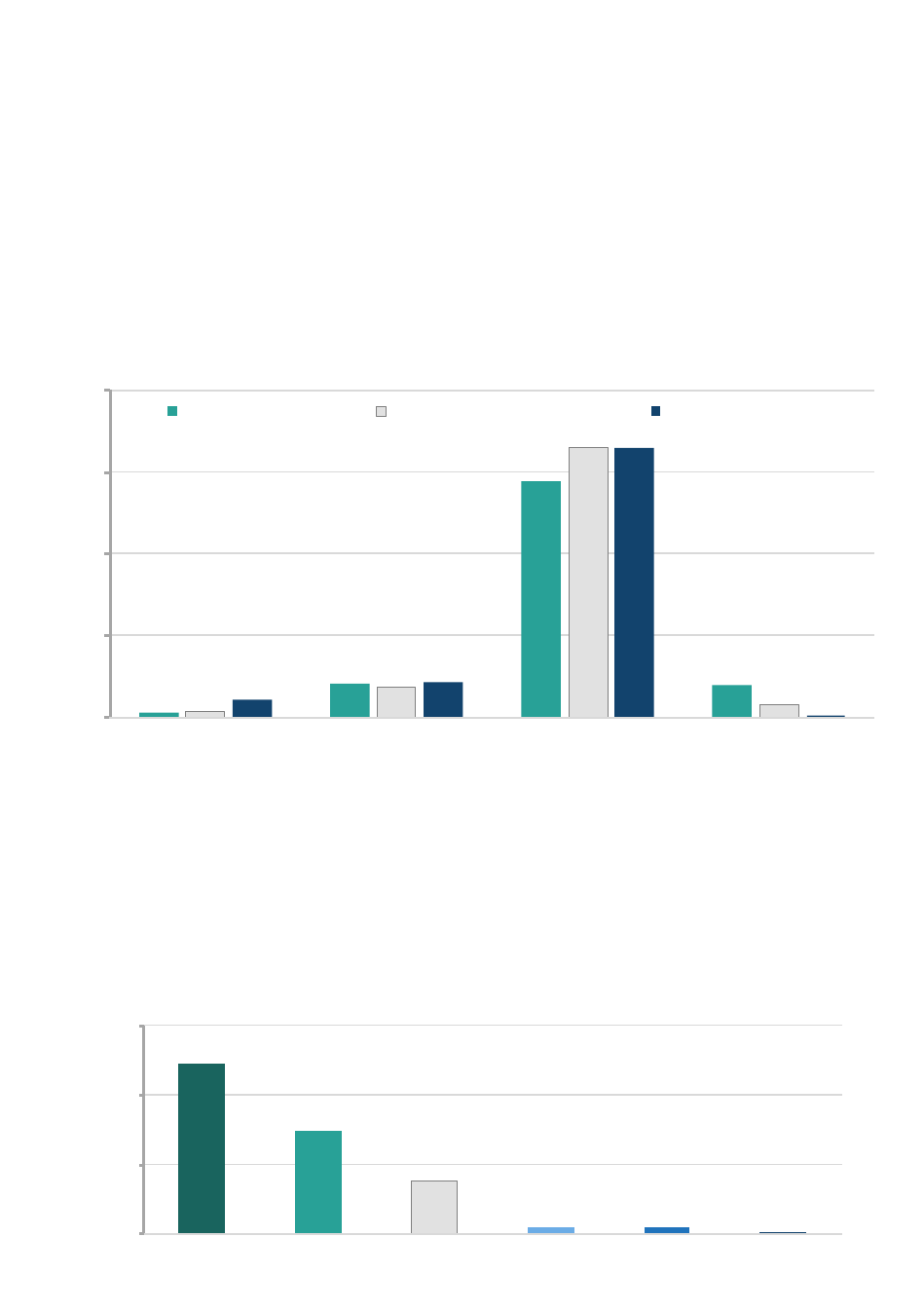
Digest of Rural England: 8 – Energy
24
than 20% of the dwellings use oil as their main fuel type. Five of these eight where in East Anglia;
the remaining ones were Eden (which is now part of Westmorland and Furness), Rydale (which is
now part of the larger North Yorkshire Local Authority) and Torridge in Devon (Note A-16). These
data are not shown in map form because of the strong correlation with the proportion of off-grid
properties shown in Figure A-12.
Figure A-8: Bar chart showing the percentage of domestic properties by main fuel type or
method of heating used in central heating by Local Authority Rural-Urban Classification,
2023
This analysis is based on Energy Performance Certificate (EPC) information up to March 2023.
(Note A-12, Note A-17). The legend is presented in the same order and orientation as the cluster of
columns.
Figure A-9: Bar chart showing the percentage of domestic properties using Oil fuelled
central heating by Local Authority Rural-Urban Classification, 2023
This analysis is based on Energy Performance Certificate (EPC) information up to March 2023.
(Note A-12, Note A-17).
0%
25%
50%
75%
100%
Community heating
scheme
Electricity Mains gas Oil
Predominantly Rural Urban with Significant Rural Predominantly Urban
Proportion of homes
0%
5%
10%
15%
Mainly Rural Largely Rural Urban with
Significant
Rural
Urban with
City and Town
Urban with
Minor
Conurbation
Urban with
Major
Conurbation
Proportion of homes using oil
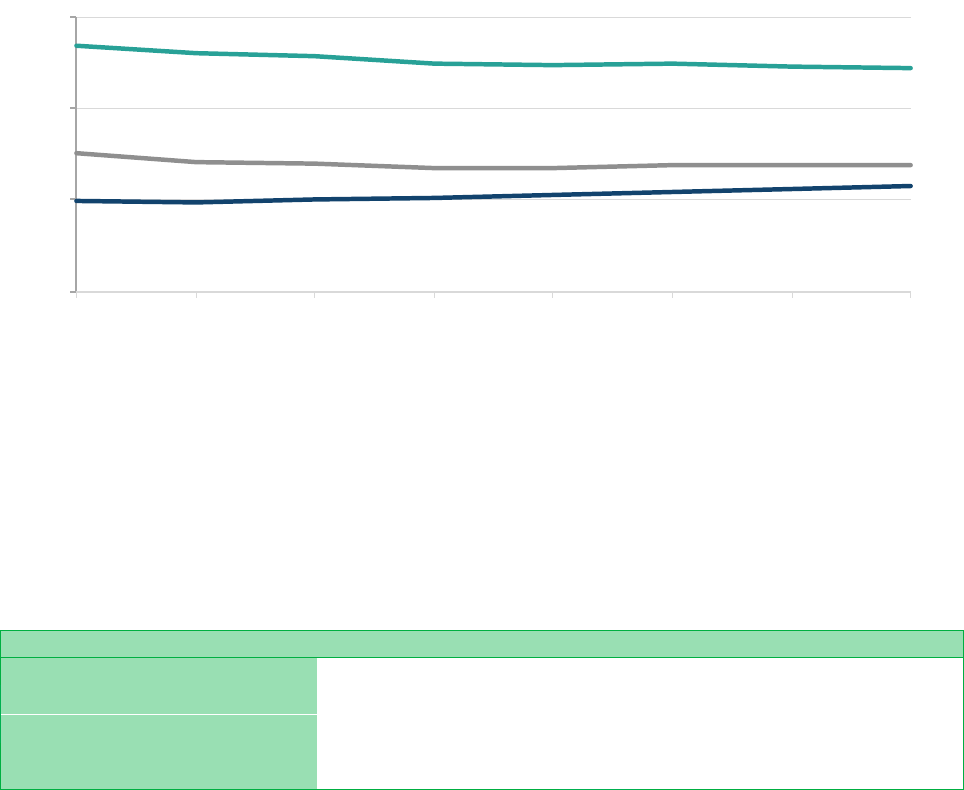
Digest of Rural England: 8 – Energy
25
Off the gas grid properties
As explained in the previously section, not all households heat their home through central heating
with a gas boiler. In 2022 an estimated 3.7 million households did not have a gas network
connection, which is 15% of the households in England (Note A-13). In Predominantly Rural areas
one in four properties (24.5%) were off the gas grid in 2022 (Figure A-10). This compares to 11.5%
in Predominantly Urban areas. The proportion of off-grid properties in Predominantly Rural areas
had fallen by 2.4 percentage points over the period 2015 to 2022, whilst for Predominantly Urban
areas it rose by 1.6 percentage point over the same period. The value for Predominantly Rural
changed by less than 0.1 percentage points between 2021 and 2022.
Figure A-10: Line chart showing the percentage of properties without mains gas supply by
broad Local Authority Rural-Urban Classification (2015-2022) (Note A-13)
In absolute terms, one in four properties (25%) off the gas grid means that 1.4 million properties in
Predominantly Rural areas are off the gas grid. This figure has remained stable over the period
2015 to 202 1 (Table A-1). So, the fall in the proportion of off the grid properties in Predominantly
Rural areas is probably because the vast majority of new builds are built within the “larger rural
settlements” and come with a gas connection as part of the construction process.
Table A-1: Estimated number (in millions) of properties off the gas grid in England (2015 to
2022) by Local Authority Rural-Urban Classification (Note A-13)
2015
2016
2017
2018
2019
2020
2021
2022
Predominantly Rural
1.43
1.39
1.39
1.36
1.36
1.39
1.38
1.39
Urban with Significant Rural
0.46
0.44
0.44
0.43
0.44
0.45
0.45
0.46
Predominantly Urban
1.50
1.50
1.56
1.59
1.65
1.73
1.79
1.86
England 3.39 3.34 3.39 3.38 3.45 3.57 3.62 3.71
When DESNZ produced the latest subnational estimates of domestic properties not on the gas grid
(Note A-13), unfortunately for our purpose, these new data were produced using the 2023
boundaries (Note A-16) and values were recalculated for all years back to 2015. Note A-16
explains the local authorities that were merged to form ‘Cumberland’, ‘Westmorland and Furness’
and ‘North Yorkshire’
. As shown in Figure A-11 these have become three very large geographical
areas. The former authorities than compose Westmorland and Furness’ and ‘North Yorkshire’ had
quite different proportions of off-grid properties and not all of them were Predominantly Rural.
Merging the areas results in a loss of detail as to where off-grid properties are. For example, for the
0%
10%
20%
30%
2015
2016 2017 2018
2019 2020 2021 2022
Predominantly Rural
Urban
with Significant Rural
Predominantly Urban
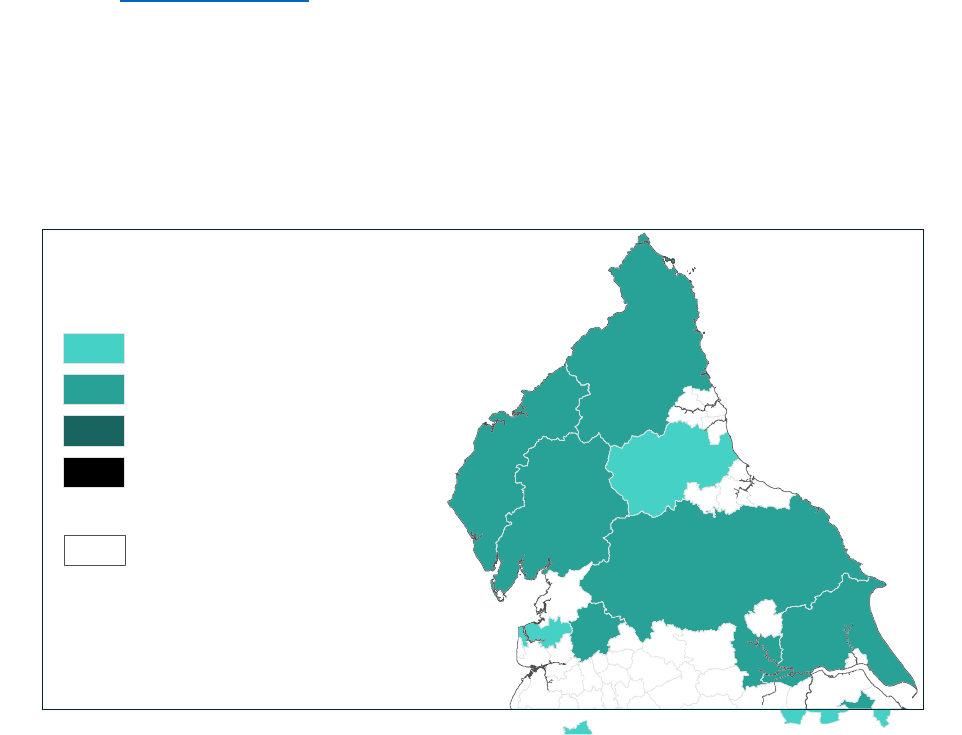
Digest of Rural England: 8 – Energy
26
new ‘Westmorland and Furness’ area in 2021 the proportion of off-grid properties in Mainly Rural
‘Eden’ and ‘South Lakeland’ was 57% and 22% respectively, but in Urban with Significant Rural
‘Barrow-in-Furness’ it was only 3% average. So, when these areas are merged together as the
Largely Rural ‘Westmorland and Furness’ the proportion of off-grid properties for 2021 became
25%. Given that the proportion of off-grid properties is not likely to change dramatically we have
decided to retain (and describe) a full map of 2021 data (Figure A-12) with its extra detail instead of
presenting a map for 2022 according to the revised boundaries. However, the 2022 data can be
found in the Energy data tables
.
Figure A-11: Map of the proportion of properties in Predominantly Rural areas of England
that are not on the gas grid in 2022 using the 2023 Local Authority boundaries (Note A-13,
Note A-16)
Local Authorities classed as Predominantly Urban or Urban with Significant Rural are shown as
white areas on the map. The 3 newly created authorities have been labelled on the map as follows:
C = Cumberland; W F = Westmorland and Furness; and N Y = North Yorkshire.
In 2021, there were three Predominantly Rural Local Authorities (Isles of Scilly, Eden, and Mid-
Suffolk) where it is estimated that at least half of the domestic properties were not on the gas grid –
see Figure A-12. A quarter of Predominantly Rural Local Authorities had at least 35% of domestic
properties off the gas grid in 2021. Most of the Local Authorities with a high proportion (greater
than 40%) of off the grid properties were located in three clusters: (1) much of Norfolk and parts of
Suffolk in the East of England; (2) Devon and Cornwall in the South West; and (3) a band in
northern England stretching from Penrith and the North Lakes south eastwards through the
Yorkshire Dales National Park and down to the North York Moors National Park (Figure A-12). For
comparison, West Berkshire was the only Urban with Significant Rural Local Authority where more
than 30% of domestic properties were off the gas grid in 2021.
A Predominantly Urban Local Authority means a Local Authority in which at least 75% of the
resident population live in Urban areas. So, it is likely that most of the domestic off the gas grid
properties within Predominantly Urban Local Authorities who are using fuels like oil and LPG are
within the “rural portion” of these authorities. However, there are also likely to be some properties
© Crown Copyright and database rights 2024
Ordn
ance Survey Licence No. 1000228
61
Proportion of properties not on
the gas g
rid in
Rural areas
Less than 10%
10% or more, but less than 25%
25% or more, but less than 40%
40% or more
Urban areas
N Y
W F
C
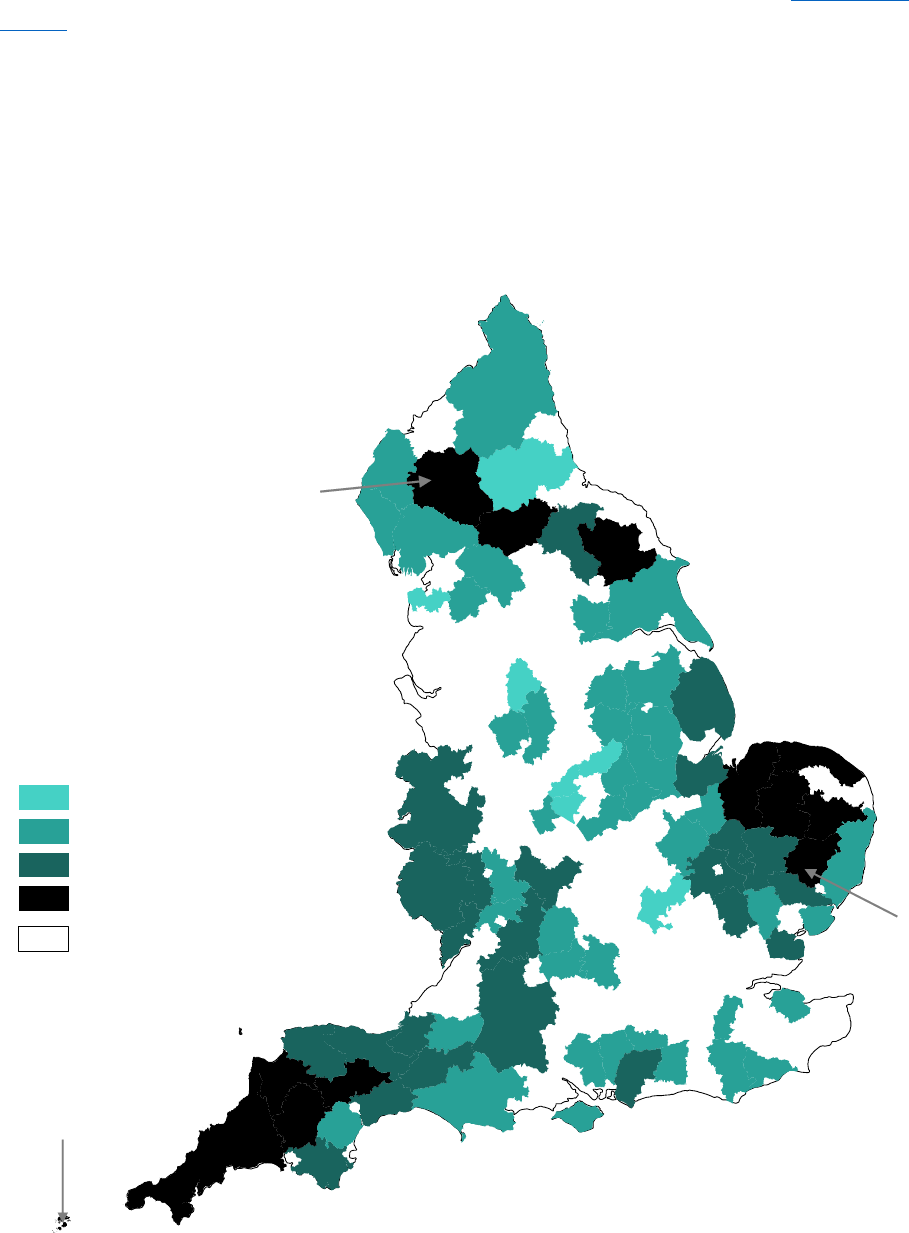
Digest of Rural England: 8 – Energy
27
in Predominantly Urban areas, especially flats and apartments, that are using modern and efficient
electric heating systems and are therefore not on the gas grid. As an example, the Manchester and
Salford areas have just over 20% of their properties off the gas grid, but this is because 25% and
29% of their properties respectively are heated by electricity not gas (Table AD2,
Energy data
tables). Since the off the gas grid estimates are more ambiguous for Predominantly Urban areas,
we have opted not to display them on a map.
Figure A-12: Map of the proportion of properties in Predominantly Rural areas that are not
on the gas grid in 2021 (Note A-13)
The locations of the 3 Predominantly Rural authorities with highest proportions of off the gas grid
properties are shown as annotations. Local Authorities classed as Predominantly Urban or Urban
with Significant Rural are shown as white areas on the map. This map uses Local Authorities prior
to the reorganisation in April 2023 (Note A-16). This map has not been revised in the 2024 update.
P r o p o r t i o n o f p r o p e r t i e s n o t
o n t h e g a s g r i d i n R u r a l a r e a s
L e s s t h a n 1 0 %
1 0 % o r m o r e , b u t l e s s t h a n 2 5 %
2 5 % o r m o r e , b u t l e s s t h a n 4 0 %
4 0 % o r m
o r
e
U r b a n a r e a s
I s l e s o f S c i l l y
1 0 0 %
E d e n
5 7 %
M i d - S u f f o l k
5 3 %
C r o w n C o p y r i g h t a n d d a t a b a s e r i g h t s 2 0 2 3
O r d n a n
c
e
S
u r v e y L i c
e
n c e N o . 1 0
0
0 2 2 8 6 1
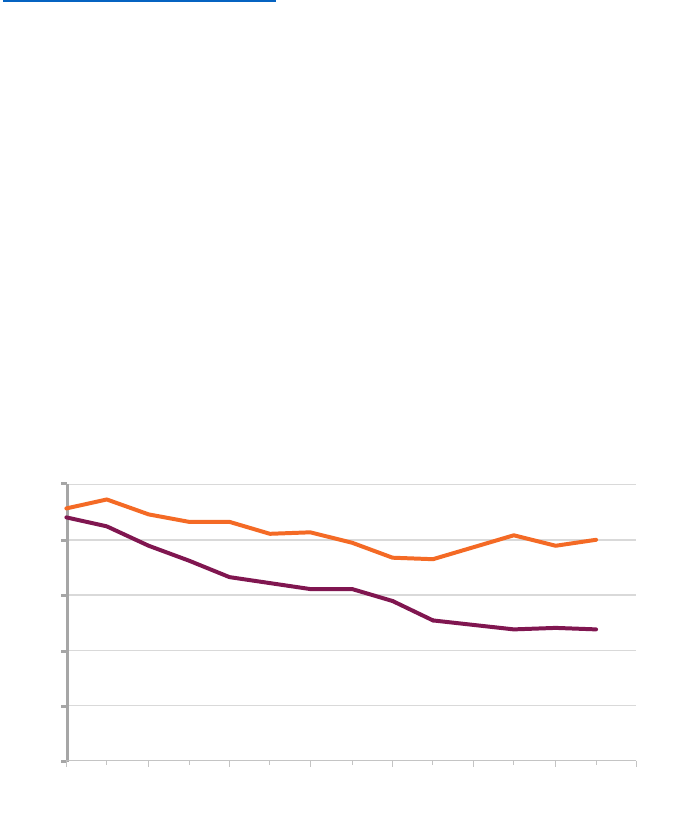
Digest of Rural England: 8 – Energy
28
In the DESNZ 2023 Fuel Poverty Statistics
publication, there is a set of long-term fuel poverty trend
tables. These have been back calculated to 2010 using the LILEE approach (Note A-8). One of
these tables considers fuel poverty according to whether or not the property is connected to the
gas grid.
Back in 2010 the proportion of fuel poor households was similar for on-grid (22%) and off-grid
(23%) properties. As Figure A-12 shows the proportion of on-grid households that are fuel poor has
declined at a much faster rate the proportion of off-grid households who are fuel poor. In fact, in
recent years the proportion of off-grid households that are fuel poor has been rising after falling to
18% in 2018 and 2019. In 2023, 20% of off-grid households were fuel poor compared to only 12%
of on-grid households.
Figure A-13: Line chart showing the proportion of on and off-grid households that are fuel
poor (2011 to 2023)
All figures are based on the Low Income Low Energy Efficiency (LILEE) approach (Note A-8).
As well as there being a greater proportion of off-grid households who are fuel poor, the depth of
the fuel poverty for those who are fuel poor is also greater when the household is off the grid rather
than on it (Figure A-14 – left-hand chart). Back in 2010 the average fuel poverty gap in real terms
(after accounting for inflation, Note A-8) was £346 for on-grid properties and £598 for off-grid
properties. As Figure C 11 (left-hand chart) shows the average fuel poverty gap for on-grid
properties dropped year-on-year every year between 2010 and 2020 before rising between 2021
and 2023. By contrast for off-grid properties the average fuel poverty rose during the first part of
the 2010s hitting £700 in 2014, before falling to £536 in 2020. In the last 2 years there has been a
dramatic increase in the average fuel poverty gap for off-grid households, with the figure rising to
£629 in 2022 and then to £801 in in 2023. For off-grid households the average fuel poverty gap
rose by £172 between 2022 and 2023, but for on-grid households the rise in the average fuel
poverty gap was only £38.
A fuel poverty depth ratio can be calculated between the average fuel poverty gap for two related
categories such as off and on-grid properties. Figure A-14 (right-hand chart) shows that in 2010 the
average fuel poverty for those who are fuel poor was 1.7 times deeper for off the grid households
than for those on the grid. This disparity has grown since 2010. Even before the 2022/2023 cost of
living crisis the depth of fuel poverty amongst off-grid households was 3 times that of on-grid
households over the period 2019 to 2021. Currently fuel poverty is 2.5 times deeper for off the grid
properties that for those on the grid.
0%
5%
10%
15%
20%
25%
2010 2012 2014 2016 2018 2020 2022 2024
Off grid
On grid
Proportion of households that are fuel poor
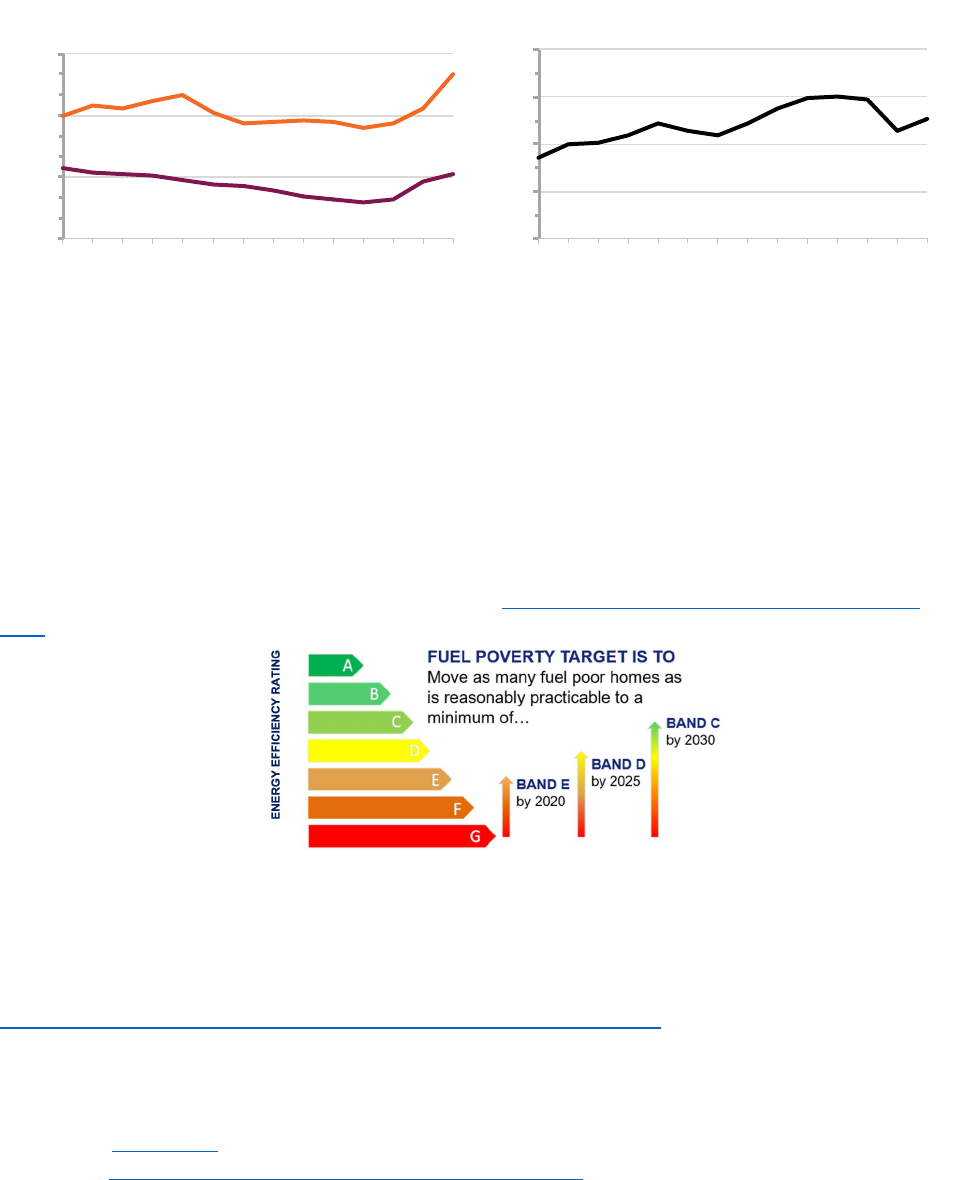
Digest of Rural England: 8 – Energy
29
Figure A-14: Line charts showing the average fuel poverty gap for those on and off-grid
households that are fuel poor (2011 to 2023) and a comparison of the depth of fuel poverty
in on and off-grid areas
The left-hand chart shows the average fuel poverty gap (£) for those on and off-grid households
that are fuel poor. This average fuel poverty gap is in ‘real terms’. The right-hand chart shows fuel
poverty depth ratio by comparing the average fuel poverty gaps from the left-hand chart. All figures
are based on the Low Income Low Energy Efficiency (LILEE) approach (Note A-8).
Fuel Poverty explanatory notes
• Note A-1
The statutory fuel poverty target was set in December 2014, binding successive Governments to the
following:
The fuel poverty target is to ensure that as many fuel poor homes as is reasonably
practicable achieve a minimum energy efficiency rating of Band C, by 2030.
This target was retained in Sustainable Warmth, the updated Fuel Poverty Strategy for England, published in
February 2021. This figure taken directly from the latest
Fuel Poverty statistics released on 28 February
2023 shows the 2030 target and the intermediate targets.
• Note A-2
The ‘Low Income High Costs’ (LIHC) defined a household as fuel poor if: (a) the amount they would need to
spend to keep their home at “an adequate standard of warmth” is above the national median level and (b) if
they spent that amount, their leftover income would be below the official poverty line. LIHC was the first
measure to introduce the concept of the fuel poverty gap. More information on LIHC can be found in the
Fuel poverty methodology handbook 2020: Low Income High Costs (LIHC)
(originally published by BEIS).
• Note A-3
Traditionally there has been a lag in the publication of the Fuel Poverty statics such that the publication came
more than a year after the data collection. For example, the data relating to Fuel Poverty in 2019 was
published in March 2021
.
In the latest Fuel Poverty statistics released on 15 February 2024, DESNZ gave headline figures as
projections for 2022. They are designed to represent the period between April 2022 and March 2024
inclusive. This is a significant change made for the 2023 annual report to provide more timely estimates of
£0
£300
£600
£900
2010 2013 2016 2019 2022
Off grid
On grid
Average fuel poverty gap
(£
)
0.0
1.0
2.0
3.0
4.0
2010 2013
2016 2019 2022
Fuel poverty depth ratio

Digest of Rural England: 8 – Energy
30
fuel poverty in detail. The 2023 projection is considered to be less uncertain than the 2024 projection since it
is based more on observed changes to energy efficiency installations, income changes and announced
energy prices.
• Note A-4
The Fuel Poverty Energy Efficiency Rating (FPEER) uses a modified version of the standard Energy
Efficiency Rating which takes into account policies that directly affect the cost of energy. In recent years this
has included the rebate provided by Warm Home Discount. The FPEER methodology deducts such rebates
from the overall modelled costs produced under the SAP system. The FPEER methodology generates a
rating between 1 and 100, which is then translated into an energy efficiency Band from G (lowest) to A
(highest) as follows:
Fuel poverty Energy
Efficiency Rating
Band
1 to 20
G
21 to 38
F
39 to 54
E
55 to 68
D
69 to 80
C
81 to 91
B
92 +
A
Note that the RPEER methodology rating will be higher than the standard rating if the household receives
additional support. The standard rating methodology is used in the Energy Performance Certificates sections
of this report (Sections B and C).
• Note A-5
Fuel poverty in England is currently measured using the Low Income Low Energy Efficiency (LILEE)
methodology. According to this methodology a household is fuel poor if:
o it is living in a property with an energy efficiency rating of band D, E, F or G as determined by the
most up-to-date Fuel Poverty Energy Efficiency Rating (FPEER) Methodology
- this is depicted by
the horizontal threshold in Figure A-1; and
o its disposable income (income after housing costs (AHC) and energy costs) would be below the
poverty line as depicted by the vertical sloping threshold in Figure A-1.
There are therefore three key elements (drivers) in determining whether a household is fuel poor: (1)
household income; (2) household energy efficiency; and (3) fuel prices. Increased energy efficiency, higher
incomes and lower energy prices would each have a positive impact on a fuel poor household. The LILEE
fuel poverty indicator sets an absolute energy efficiency threshold making it easier to identify the impact of
changes in energy efficiency. The relative nature of the income threshold means it is harder to see the
impact of changes in income and the contribution of prices since this requires an assessment of how
household incomes and fuel costs change relative to the median income.
It is important to note that LILEE is not based on actual fuel costs. The Government is interested in the
amount of energy households need to consume to have a warm, well-lit home, with hot water for everyday
use, and the running of appliances. Fuel poverty is therefore measured based on required fuel costs of the
energy efficiency of the home rather than actual spending. An equivalisation factor is applied to reflect the
different levels of energy required depending on the number of people living in the property.
The Income element of LILEE is defined as equivalised income after housing costs, tax and National
Insurance. Equivalisation reflects that households have different spending requirements depending on the
number and age of people living in the property.
Under the LILEE indicator there is no exact point on the income axis, for a given FPEER rating, where the
household would be classed as Low Income since this threshold is measured using income minus fuel costs.
The sloping dashed line Figure A-1 marks a line of best fit between households classed as Low Income and

Digest of Rural England: 8 – Energy
31
High Income and shows the impact of higher fuel costs in Low Energy Efficiency households. The variation
in fuel costs for a given FPEER is due to factors including property size, household size, occupancy pattern.
The depth of fuel poverty is measured by the fuel poverty gap. The fuel poverty gap is the reduction in fuel
costs needed for a household to not be in fuel poverty. This is either the change in required fuel costs
associated with increasing the energy efficiency of a fuel poor household to a Fuel Poverty Energy Efficiency
Rating (FPEER) of at least 69 (band C threshold) or reducing the costs sufficiently to meet the income
threshold.
More information on the Fuel Poverty Energy Efficiency Rating (FPEER) and Low Income Low Energy
Efficiency (LILEE) can be found in the Fuel Poverty Methodology Handbook
(originally published by BEIS).
• Note A-6
An analysis of housing stock by property age and type can be found in
Statistical Digest of Rural England:2 –
Housing.
This report contains information on the number and proportion of pre-1919 houses in rural and urban areas
as well as the number of (mid and end) terraced properties. This analysis is based on the English Housing
Survey (EHS) which does not define rurality according to the RUC, it uses a looser definition based on an in-
situ assessment (see the Husing report for more details). Therefore, where this data source has been used
in this section, we refer to rural and urban instead of Rural and Urban to denote that these are not using the
strict RUC definition.
• Note A-7
Energy Saving Trust blog March 2019: Why outside the grid does not mean outside of help
.
• Note A-8
After switching to the LILEE methodology DESNZ / BEIS back calculated fuel poverty figures to 2010 using
the LILEE approach to generate a consistent time series for a selection of variables. These
long-term fuel
poverty trend tables are updated annually as part of the Fuel Poverty Statistics publication. Table 5 of the
long-term trends publication contains a breakdown for properties on and off the gas grid. In this document all
the estimates of the fuel poverty gap are in ‘real terms’, which means that they take account of inflation. These
estimates were produced by DESNZ using the Gross Domestic Product (GDP) deflators consistent with the
Office for Budget Responsibility estimates November 2023.
• Note A-9
Annual fuel poverty statistics report 2024 (2022 and 2023 data)
sections 3.1.2 to 3.1.5 cover fuel poverty by
wall type, dwelling type, floor area and property age.
• Note A-10
Fuel poverty source data: DESNZ fuel poverty statistics:
www.gov.uk/government/collections/fuel-poverty-
statistics
• Note A-11
Energy Performance Certificate (EPC) are described in more detail in Section B Energy Performance
Certificates: average Energy Efficiency Score and Section C Energy Performance Certificates: achieving
energy efficiency category C.
• Note A-12
The Office for National Statistics (ONS) publish Energy Efficiency of Housing at Local Authority level on an
annual basis for financial years. This section uses data for the financial year ending March 2023.
The source data for this ONS publication is Department for Levelling up, Housing and Communities – Energy
Performance Certificate data on Open Data Communities and Valuation Office Agency - Property Attributes
data (https://epc.opendatacommunities.org/
).
There was 22 Local Authorities where the proportion of properties using oil was supressed in the source data
and they were therefore excluded from our analysis. All of them were Predominantly Urban Local Authorities
and the Local Authorities excluded can be determined from worksheet AD in the Energy data tables
.

Digest of Rural England: 8 – Energy
32
• Note A-13
DESNZ produce subnational estimates of domestic properties not on the gas grid, Great Britain. In their latest
publication the data is for 2015 – 2022 (
https://www.gov.uk/government/statistics/sub-national-estimates-of-
households-not-connected-to-the-gas-network). Unfortunately, for our purpose, this new data has been
produced using the 2023 boundaries (Note A-16) and recalculated for all years back to 2015. This is
unfortunate because the areas merged together in Cumbria and North Yorkshire have quite different
proportions of off grid properties and merging removes a lot of detail as to where the off-grid properties are.
• Note A-14
Tables showing the data behind Figure A-3, Figure A-6 and Figure A-7 are available in the
Energy data
tables.
• Note A-15
DESNZ produce sub-regional fuel poverty data as Experimental Statistics and their latest publication
released on 23 April 2023 was for 2021 data and uses the 2023 Local Authority boundaries. It is not
possible to update
Figure A-4 or Figure A-5 until DESNZ have published newer sub-regional level data.
The sub-regional Experimental Statistics complement the National Statistics on fuel poverty, by estimating
the number and proportion of fuel poor households at smaller geographical levels, for example, Local
Authority (LA) level. However the sub-regional statistics do not report on the average fuel poverty gap. This
latest publication is the third year that sub-regional breakdowns have been produced based on the LILEE
indicator.
They are Official Statistics, produced in compliance with the Code of Practice for Statistics
and will be
undergoing an evaluation process prior to being assessed as National Statistics.
• Note A-16
New Local Authorities came into operation in April 2023. These changes relate to 3 parts of England: (1)
North Yorkshire, (2) Cumbria and (3) Somerset. This reduced the total number of Local Authorities from 309
down to 296.
1. A new unitary authority called North Yorkshire replaced the 7 existing districts of Craven,
Hambleton, Harrogate, Richmondshire, Ryedale, Scarborough and Selby. We have provisionally
classified this single North Yorkshire UA as Predominantly Rural.
2. The 6 districts within Cumbria were abolished and replaced with 2 new unitary authorities.
Allerdale, Carlisle and Copeland have been merged to form Cumberland and Barrow-in-Furness,
Eden and South Lakeland have been merged to form Westmorland and Furness. We have
provisionally classified Cumberland and Westmorland and Furness as Predominantly Rural.
3. The districts of Mendip, Sedgemoor, Somerset West and Taunton, and South Somerset have been
merged to form a new unitary authority known as Somerset. We have provisionally classified this
single Somerset UA as Predominantly Rural.
Note that the fuel type analysis based on the Energy Efficiency of Housing
publication uses the pre April
2023 boundaries.
• Note A-17
There is no mains gas on the Scilly Isles.
Digest of Rural England: 8 – Energy
33
B. Energy Performance Certificates: average Energy
Efficiency Score
Energy efficiency of homes is improving and whether the property is a house or a flat and
the age of the property are far more important factors in determining its energy efficiency
than its level of rurality.
Summary
An Energy Performance Certificate (EPC) provides information on the energy efficiency of a
building. Since 2007, an EPC is required when a building is constructed, sold or let; the higher the
energy efficiency score the more efficient the building. Low Income Households can only be in fuel
poverty if the Fuel Poverty Energy Efficiency Rating of their home is band D or below (an Energy
Efficiency Score less than 69).
In 2023 the average Energy Efficiency Score differed little between homes in Predominantly Rural
areas (66.8) and homes in Predominantly Urban areas (67.5). Both scores are equivalent to an
Energy Efficiency Rating (EER) band D.
On average, older dwellings have a lower average efficiency rating in both Predominantly Rural
and Predominantly Urban areas. In 2023, pre-1930 properties in Predominantly Rural areas had an
average median Energy Efficiency Score of 54.2, whilst modern homes (2012 onwards) in
Predominantly Rural areas had an average Energy Efficiency Score of 83.5. Pre-1930s properties
in Predominantly Rural areas have an average Energy Efficiency Rating one band lower than for
pre 1930s properties in Predominantly Urban areas.
In 2023 flats and maisonettes had the highest average median energy efficiency score of all
domestic property types and scored virtually the same in both Predominantly Rural (73.0) and
Predominantly Urban (72.9) areas. Flats and maisonettes had an average Energy Efficiency Rating
one band higher than terraced, detached and semi-detached properties. In Predominantly Rural
areas on average a new detached property had an Energy Efficiency Score 23 points higher than
the average for existing detached properties.
In 2023 in both Predominantly Rural and Predominantly Urban areas, in terms of tenue, the lowest
average Energy Efficiency Score was for owner occupied properties and the highest was for social
rented properties. The private rental sector had the biggest difference in average Energy Efficiency
Scores between Predominantly Rural (63.8) and Predominantly Urban areas (66.2).
Half of the Predominantly Rural Local Authorities had average Energy Efficiency Scores that were
within 1 point of the median Energy Efficiency Score of 67. Half of Predominantly Rural Local
Authorities had an average Energy Efficiency Score of 55 or less for pre-1930s properties but only
7 of 175 Predominantly Urban Local Authorities (about 5%) had an average Energy Efficiency
Score of 55 or less for pre-1930s properties.

Digest of Rural England: 8 – Energy
34
Energy Performance Certificates and ratings
An Energy Performance Certificate (EPC) provides information on the energy efficiency of a
building. Since 2007, an EPC is required when a building is constructed, sold or let. The Energy
Efficiency Score shows the energy efficiency of a building at the time of its EPC assessment. The
higher the score, the more energy efficient a building is. An Energy Efficiency Rating band from A
to G can also be used to interpret this score, where A is very energy efficient, and G is very energy
inefficient (Table B-1). Households can only be in fuel poverty if the Energy Efficiency Rating of the
home, as defined by the latest Fuel Poverty Energy Efficiency methodology, is band D or below
(Note B-2, Note B-3). Note B-5 contains more details about EPCs.
Table B-1: Lookup table to aid interpretation of Interpreting energy efficiency scores
Energy Efficiency Score
Energy Efficiency Rating band
More than 91 A
81 to 91 B
69 to 80 C
55 to 68 D
39 to 54 E
21 to 38 F
1 to 20 G
This data does not reflect all dwellings in England, because not every dwelling has an EPC. Table
4a of Median energy efficiency score, England and Wales
shows the percentage of dwellings
covered by an Energy Performance Certificate since records began, in England and Wales, as at
31 March 2023. Overall, in England around two-thirds of domestic properties are covered by EPCs.
In general, the coverage is higher for:
• for newer properties (95% coverage of post 2012 properties) than older ones;
• rented properties than owner occupied; and
• flats and maisonettes (83% coverage) than houses (60% coverage for detached
properties).
Average energy efficiency
The ONS publish Energy Efficiency of Housing on an annual basis (see Note B-4 and Note B-5
).
The most recent edition was published in November 2023.
There is little difference between the average Energy Efficiency Score of homes in Predominantly
Rural areas (66.8 in 2023) and homes in Predominantly Urban areas (67.5 in 2023). In both
Predominantly Rural and Predominantly Urban areas this average Energy Efficiency Score
equates to an Energy Efficiency Rating of D. In both Predominantly Rural and Predominantly
Urban areas the average energy efficiency increased marginally year-on-year between 2021 and
2023 (Figure B-1). In Predominantly Rural areas the change has been slightly larger over this 2
year period than in Predominantly Urban areas. The average Energy Efficiency Score has
increased by 2.1 (3%) in Predominantly Rural areas and in Predominantly Urban areas it increased
by 1.3 (2%).
Homes in Mainly Rural areas have an average Energy Efficiency Rating that is slightly lower than
for homes in Largely Rural areas (Figure B-2), so the more rural an area the lower the average
Energy Efficiency Rating. The average Energy Efficiency Rating increased year-on-year between
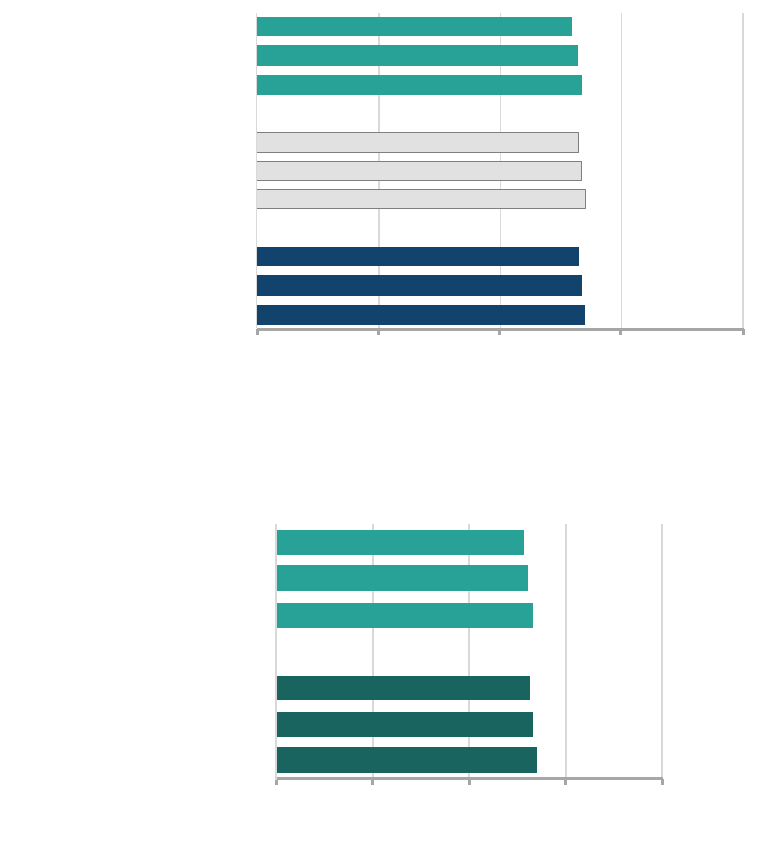
Digest of Rural England: 8 – Energy
35
2021 and 2023 in both Mainly Rural and Largely Rural areas. This increase was marginally larger
in Largely Rural areas (3.4%) than in Mainly Rural areas (3.1%)
Considering only the average hides information because there are several factors that can
influence the Energy Efficiency Rating of homes. Two of them are the housing type and housing
age. Subsequent sections examine these two factors.
Figure B-1: Bar chart showing average Energy Efficiency Score by Local Authority Rural-
Urban Classification in 2021, 2022 and 2023 (Note B-4)
Figure B-2: Bar chart showing average Energy Efficiency Score for Rural areas by Rural-
Urban Classification in 2021, 2022 and 2023 (Note B-4)
Average energy efficiency by housing age
On average, older dwellings had a lower average efficiency rating in both Predominantly Rural and
Predominantly Urban areas (Figure B-3).
For pre-1930 properties in Predominantly Rural areas the average median Energy Efficiency Score
in 2023 was 54.2, which equates to an average Energy Efficiency Rating of E. For properties in
Predominantly Rural areas built between 1930 and 1982 the average Energy Efficiency Score
equated to a rating of D. For 2023 the average Energy Efficiency Score for homes built between
1983 and 2011 was just within the band for an average Energy Efficiency Rating of C and for
0 25 50
75
100
2021
2022
2023
2021
2022
2023
2021
2022
2023
Average Energy Efficiency Score
Predominantly
Rural
Urban with
Significant
Rural
Predominantly
Urban
0 25 50 75 100
Mainly Rural, 2021
Mainly Rural, 2022
Mainly Rural
, 2023
Largely Rural, 2021
Largely Rural
, 2022
Largely Rural, 2023
Average Energy Efficiency Score
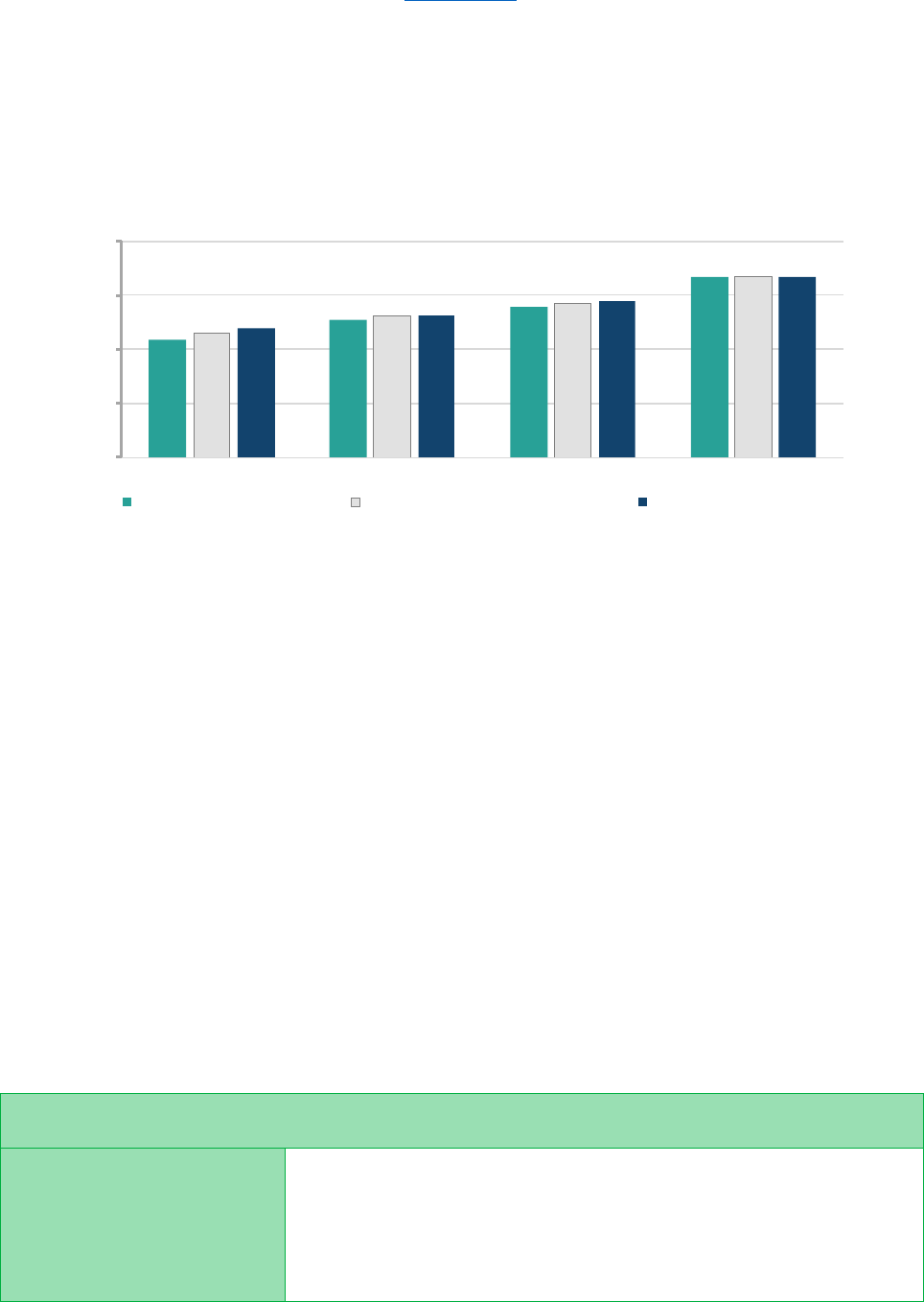
Digest of Rural England: 8 – Energy
36
modern homes (2012 onwards) the average Energy Efficiency Score of 83.5 in Predominantly
Rural areas equated to a rating of B. In the March 2021
dataset the ONS used different property
age bands and it was possible to distinguish between pre-1900 and 1900 to 1929 homes. For pre-
1900 homes in Predominantly Rural areas the 2021 median Energy Efficiency Rating was only
47.6 (and this compares to 55.6 in Predominantly Urban areas).
Figure B-3: Bar chart showing average Energy Efficiency Score by property age band and
Local Authority Rural Urban Classification in 2023 (Note B-4)
The legend is presented in the same order and orientation as the cluster of columns.
The Rural-Urban Energy Efficiency Rating Gap (Rural-Urban EER Gap) is shown in Table B-2 and
it is the difference between the average Energy Efficiency Ratings in Predominantly Urban and
Predominantly Rural areas - effectively the difference in the column heights on Figure B-3. For
properties built in the last 10 years the Rural-Urban EER Gap was only 0.1 indicating that there
was very little difference in the median Energy Efficiency Score for modern buildings in
Predominantly Rural and Predominantly Urban areas. For pre-1930 properties the Rural-Urban
EER Gap was 5.7 energy efficiency points. This figure is big enough to make the average Energy
Efficiency Rating in old homes in Predominantly Urban areas (rating D) one band higher than the
average for old homes in Predominantly Rural areas (rating E).
For properties of all ages the average Energy Efficiency Score increased between 2022 and 2023
in both Predominantly Rural and Predominantly Urban areas, but the Rural-Urban EER Gap
changed little from 2022.
Table B-2: The Energy Efficiency Rating (EER) in Rural and Urban areas (including London)
and the Rural-Urban Energy Efficiency Rating Gap (EER Gap) by property age band in 2023
(Note B-4)
Rural-Urban (including London) EER Gap is the difference between the average EER in
Predominantly Urban (including London) and Predominantly Rural areas.
Property age Pre-1930 1930 to 1982 1983 to 2011 2012 onwards
Predominantly Rural EER 54.2 63.8 69.9 83.5
Predominantly Urban
(including London) EER
59.9 65.7 72.5 83.6
Rural-Urban (including
London) EER Gap
5.7 1.9 2.6 0.1
0
25
50
75
100
Pre-1930 1930 to
1982 1983 to 2011
2012 onwards
Predominantly Rural Urban with Significant Rural Predominantly Urban
Energy Efficiency Score
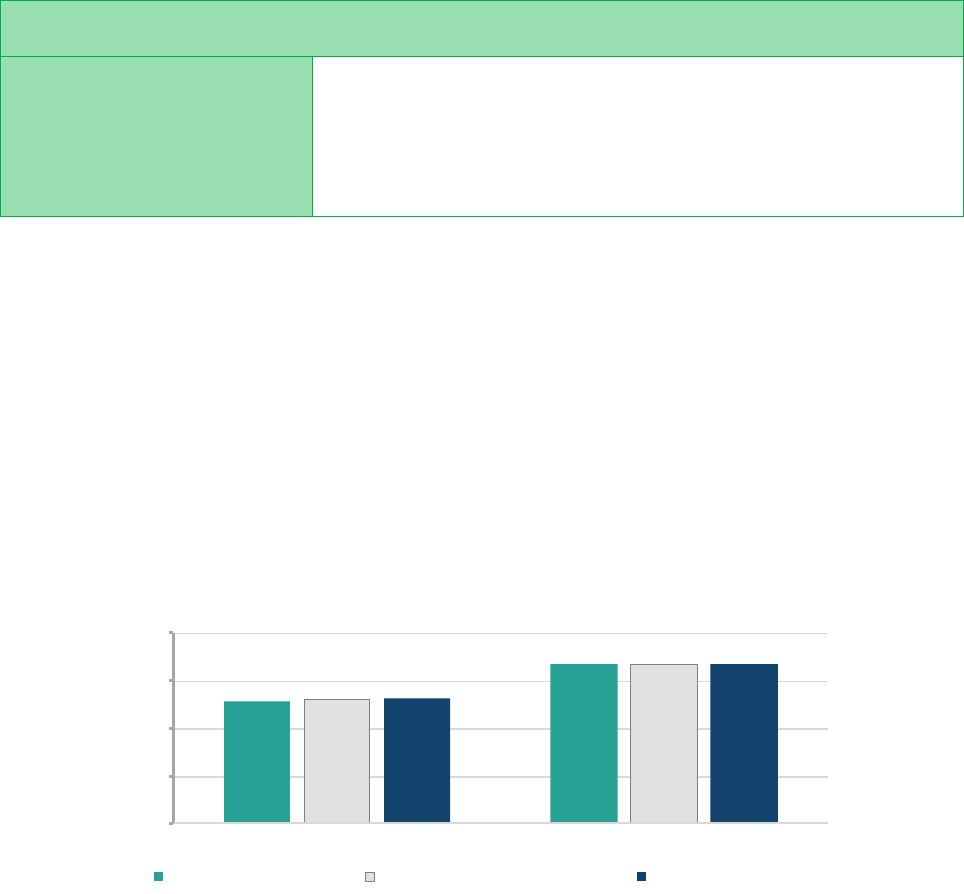
Digest of Rural England: 8 – Energy
37
For all property age bands, the average Energy Efficiency Score was higher in London than in
Predominantly Urban (excluding London) and this difference was biggest for pre-1930 and 1983 to
2011 properties (See Table GA2b in the supplementary tables - Note B-1). The impact of this is
that the is Rural-Urban (excluding London) EER Gap (Table B-3) was smaller than the Rural-Urban
(including London) EER Gap for all property age bands.
Table B-3: The Energy Efficiency Rating (EER) in Rural and Urban areas (excluding London)
and the Rural-Urban Energy Efficiency Rating Gap (EER Gap) by property age band in 2023
(Note B-4)
Rural-Urban (excluding London) EER Gap is the difference between the average EER in
Predominantly Urban areas outside of London and Predominantly Rural areas.
Property age Pre-1930 1930 to 1982 1983 to 2011 2012 onwards
Predominantly Rural EER 54.2 63.8 69.9 83.5
Predominantly Urban (excluding
London) EER
59.2 65.5 71.8 83.4
Rural-Urban (excluding London)
EER Gap
5.0 1.8 1.9 -0.1
To simplify the picture, we can split properties into new dwellings and existing dwellings. Any
property that has undergone a conversion to change its use is considered to be a new property
from an EPC perspective (Note B-6). As expected, new dwellings had a higher Energy Efficiency
Score than existing dwellings (Figure B-4) and there was no difference between the scores for
Predominantly Rural and Predominantly Urban areas (both had an average score of 83.5). The
average Energy Efficiency Score for existing buildings was 64.2 in Predominantly Rural areas and
65.9 in Predominantly Urban areas.
Figure B-4: Bar chart showing average Energy Efficiency Score for existing dwellings and
new dwellings by property age band and Local Authority Rural Urban Classification in 2023
(Note B-4)
The legend is presented in the same order and orientation as the cluster of columns.
Average energy efficiency by housing type
Flats and maisonettes had the highest average median Energy Efficiency Score (Figure B-4) of all
domestic property types and score virtually the same in both Predominantly Rural (73.0) and
Predominantly Urban (72.9) areas. This equated to an Energy Efficiency Rating of C. Terraced
housing had the second highest average median Energy Efficiency Score in both Predominantly
0
25
50
75
100
Existing dwellings New dwellings
Predominantly Rural Urban with Significant Rural Predominantly Urban
Energy Efficiency Score
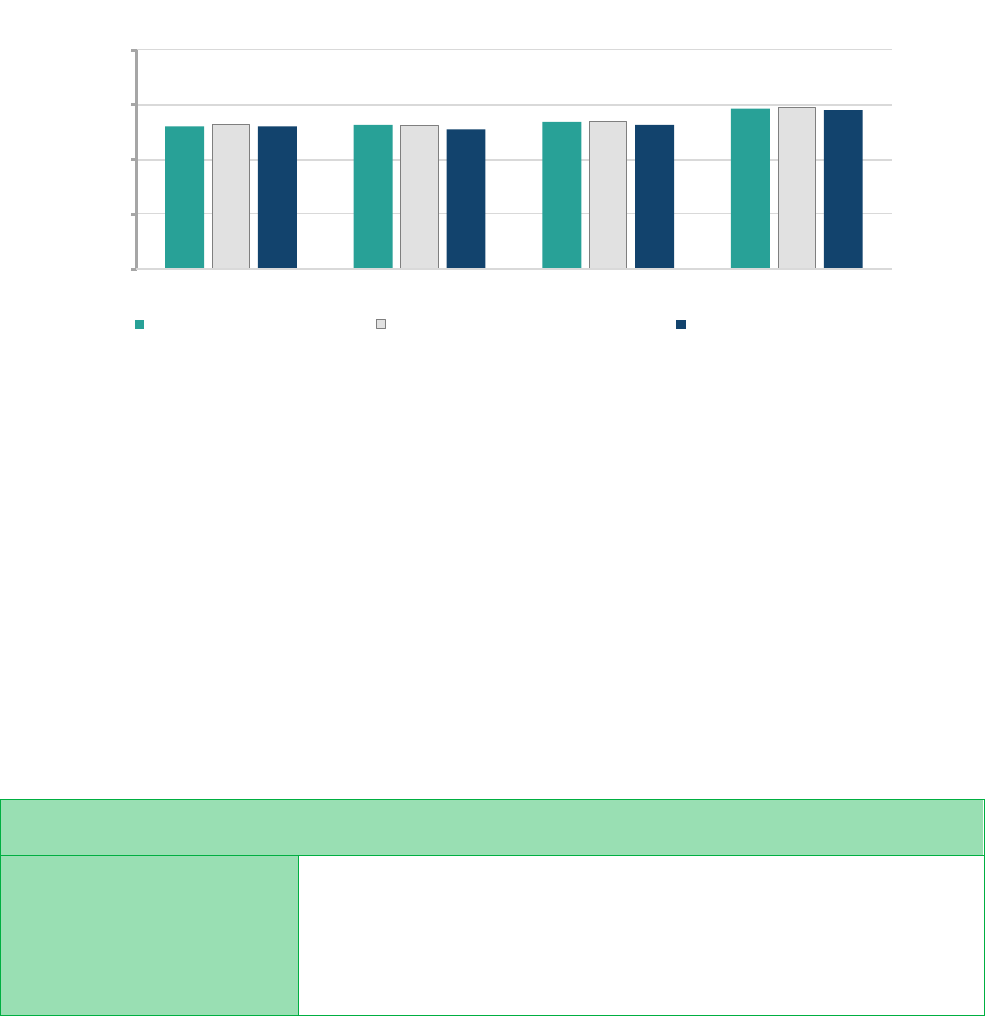
Digest of Rural England: 8 – Energy
38
Rural and Predominantly Urban areas, but their overall average Energy Efficiency Rating was still
D, as it was for Detached and Semi-detached premises.
Figure B-5: Bar chart showing average Energy Efficiency Score by property type and Local
Authority Rural-Urban Classification in 2023 (Note B-4, Note B-7)
The legend is presented in the same order and orientation as the cluster of columns.
The Rural-Urban EER Gap by property type is shown in Table B-4. The Rural-Urban EER Gap is
negative for all property types except detached indicating that on average the Energy Efficiency
Score of homes in Predominantly Rural areas is only lower than in Predominantly Urban areas for
detached properties. For all property types in both Predominantly Rural and Predominantly Urban
areas the average Energy Efficiency Score increased between 2021 and 2022. The largest
increase was for detached properties which increased by 1.4 points in Predominantly Rural areas
and 1.0 points in Predominantly Urban areas. By contrast the improvement for Terraced houses
and Flats and maisonettes was only 0.6 points
Table B-4: The Energy Efficiency Rating (EER) in Rural and Urban areas (including London)
and the Rural-Urban Energy Efficiency Rating Gap (EER Gap) by property type in 2022 (Note
B-4, Note B-7)
Rural-Urban (including London) EER Gap is the difference between the average EER in
Predominantly Urban (including London) and Predominantly Rural areas.
Property type Detached Semi-detached Terraced Flats and maisonettes
Predominantly Rural (EER) 64.9 65.8 67.3 73.0
Predominantly Urban
(including London) EER
65.1 64.0 65.5 72.9
Rural-Urban (including
London) EER Gap
0.2 -1.7 -1.8 -0.2
The average energy efficiency rating in Local Authorities in London was lower than the average
Energy Efficiency Rating in Predominantly Urban Local Authorities outside of London across all
property types (See Table GA3b in the supplementary tables - Note B-1). The difference was
largest for Detached and Semi-detached properties. So, the Rural-Urban (excluding London) EER
Gap was smaller for Semi-detached and Terraced properties, but larger for Detached properties
(Table B-5).
0
25
50
75
100
Detached
Semi-detached Terraced
Flats and maisonettes
Predominantly Rural Urban with Significant Rural
Predominantly Urban
Energy Efficiency Score
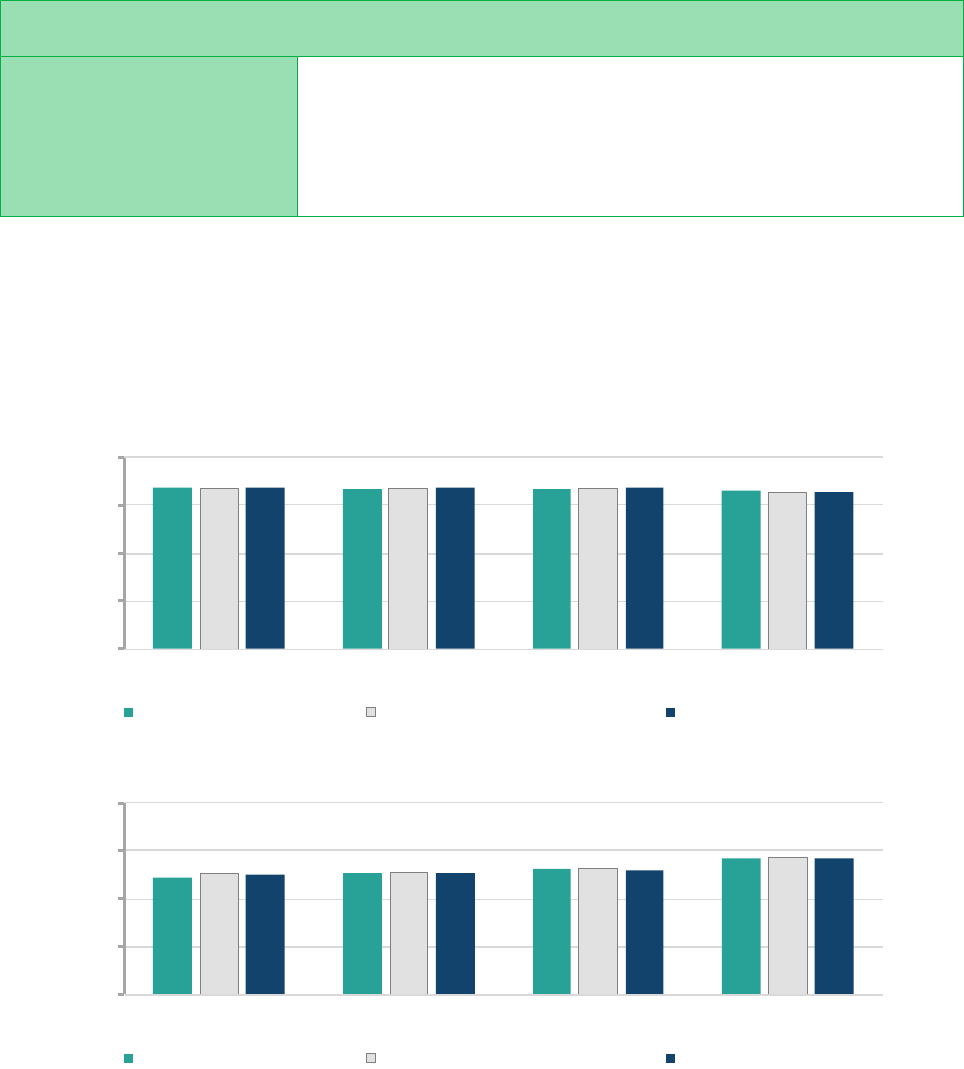
Digest of Rural England: 8 – Energy
39
It is possible to consider new and existing dwellings (Note B-6) by property type separately. For
new properties the average Energy Efficiency Score was over 80 (rating band B) for all property
types in both Predominantly Rural and Predominantly Urban areas (Figure B-6 – top chart). The
average scores for Predominantly Rural and Predominantly Urban areas differed by, at most, 0.7
points.
Table B-5: The Energy Efficiency Rating (EER) in Rural and Urban areas (excluding London)
and the Rural-Urban Energy Efficiency Rating Gap (EER Gap) by property type in 2023 (Note
B-4, Note B-7)
Rural-Urban (excluding London) EER Gap is the difference between the average EER in
Predominantly Urban areas outside of London and Predominantly Rural areas.
Property type Detached Semi-detached Terraced Flats and maisonettes
Predominantly Rural EER 64.9 65.8 67.3 73.0
Predominantly Urban
(excluding London) EER
66.2 65.0 65.9 72.9
Rural-Urban (excluding
London) EER Gap
1.3 -0.7 -1.4 -0.1
Figure B-6: Bar chart showing average Energy Efficiency Score for new (top chart) and
existing (bottom chart) properties by property type and Local Authority Rural-Urban
Classification in 2023 (Note B-4, Note B-6, Note B-7)
The legend is presented in the same order and orientation as the cluster of columns.
0
25
50
75
100
Detached Semi-detached Terraced Flats and maisonettes
Predominantly Rural Urban with Significant Rural Predominantly Urban
Energy Efficiency Score
New
0
25
50
75
100
Detached Semi-detached Terraced Flats and maisonettes
Predominantly Rural Urban with Significant Rural Predominantly Urban
Energy Efficiency Score
Exis�ng

Digest of Rural England: 8 – Energy
40
For existing properties (Figure B-6 – bottom chart), Flats and maisonettes had the highest Energy
Efficiency Score in both Predominantly Rural and Predominantly Urban areas (both were 71.2).
The lowest average energy efficiency scores were for existing Detached properties at 61.3 in
Predominantly Rural areas and 62.7 in Predominantly Urban areas. This Rural-Urban EER gap of
1.4 was the largest amongst the four property types. For existing semi-detached and terraced
properties, the average energy efficiency score was marginally higher in Predominantly Rural
areas than Predominantly Urban areas.
As seen in Figure B-6, rurality is a much less important factor in the average Energy Efficiency
Score than whether or not the building is new or existing (Note B-6). As Table B-6 shows in
Predominantly Rural areas on average a new detached property had an Energy Efficiency Score
23 points higher than the average for an existing property. In rating terms this is a difference of a D
rating to a B rating. The same rating difference was also seen for Semi-detached and Terraced
properties, but the absolute change in the average energy efficiency score was smaller. The
greater average Energy Efficiency Scores for Flats and maisonettes means that there is a smaller
difference (C rating to a B rating) with an 11 points higher rating score for new properties
compared to existing properties.
Table B-6: The difference in the average Energy Efficiency Scores for new and existing
properties by property type and Local Authority Rural-Urban Classification in 2023 (Note B-
4, Note B-6, Note B-7)
Rural-Urban Classification Detached Semi-detached Terraced Flats and maisonettes
Predominantly Rural 22.6 20.2 18.2 11.2
Urban with Significant Rural 21.0 19.9 18.0 9.7
Predominantly Urban 21.4 21.2 19.6 10.6
Average energy efficiency by tenure
The ONS dataset also includes Energy Efficiency Ratings for Owner Occupied and rented
properties. In all areas, Owner Occupied properties tend to have the lowest average Energy
Efficiency Score and Social Rented properties tend to have the highest Energy Efficiency Rating
(Figure B-7). For Social Rented properties the average Energy Efficiency Score equates to a C
rating in both Predominantly Urban and Predominantly Rural areas, whilst for Owner Occupied and
Private Rented the average score equates to a D rating. The scores for all 3 tenure types were
marginally higher in 2023 than they were in 2022, but the year-on-year improvement was greater
for Owner Occupied and Private Rented properties than for Social Rented properties.
The Rural-Urban EER Gap for the private rented sector is more than double the size of the Rural-
Urban EER Gap for owner occupied or socially rented houses (Figure B-8). For Private rented
properties the average Energy Efficiency Score is 63.8 in Predominantly Rural areas and 66.2 in
Predominantly Urban areas; leading to a Rural-Urban EER Gap of 2.5. For comparison with
Owner-Occupied properties the Rural-Urban EER Gap is 1.2.
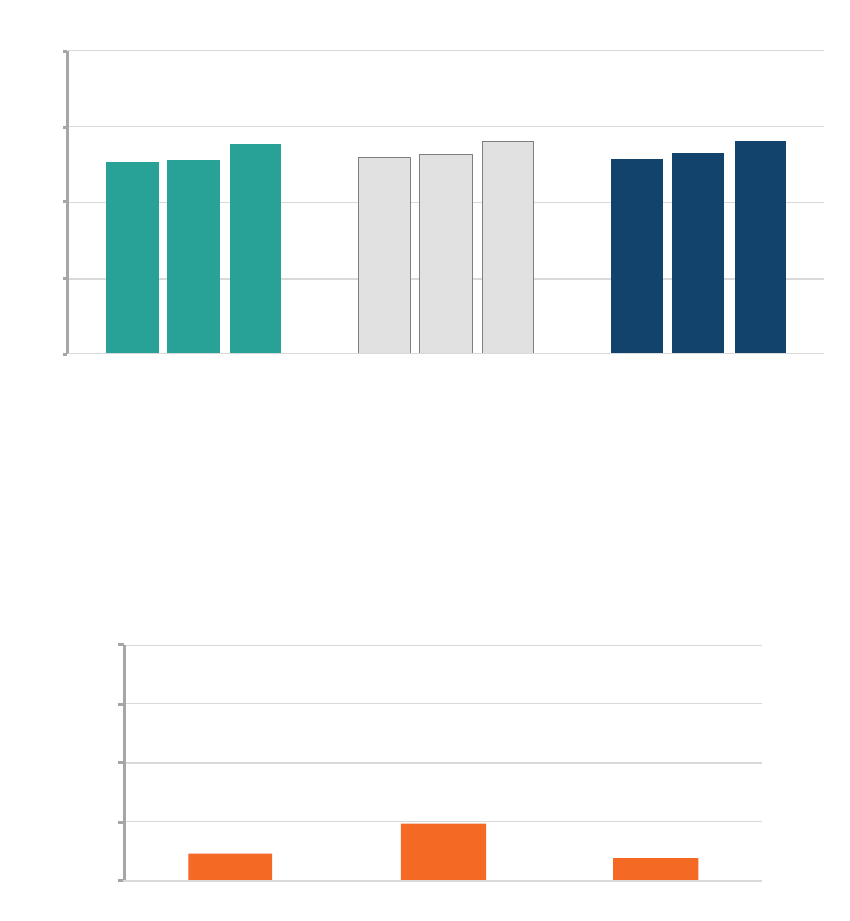
Digest of Rural England: 8 – Energy
41
Figure B-7: Bar chart showing average Energy Efficiency Score by property tenure and
Local Authority Rural Urban Classification in 2023 (Note B-4, Note B-8)
The clusters of columns are ordered as follows for each RUC category: Owner Occupied (O-O),
Private Rent (PR) and Social Rent (SR)
Figure B-8: Bar chart showing the Rural-Urban Energy Efficiency Rating Gap (EERG) by
tenure in 2023 (Note B-4, Note B-8)
Average energy efficiency distributions
Considering just the averages across Predominantly Rural and Predominantly Urban masks the
detail and prevents the identification of Local Authorities where the average Energy Efficiency
score is particularly low or particularly high. Considering Predominantly Rural areas first, the data
showed that for all dwellings the lower quartile Energy Efficiency Score was 65.8 and the upper
quartile Energy Efficiency Score was 68. In other words, for half of the Predominantly Rural Local
Authorities the difference in the average Energy Efficiency Score is small and they were clustered
within 1 point of the median Energy Efficiency Score of 67. The Isles of Scilly appeared as a clear
outlier as the Predominantly Rural Local Authority with the lowest average Energy Efficiency Score
(Table B-7). Potentially this is an artefact of a small sample size because a property will only get an
EPC when it is traded or constructed. The next lowest scores were for Eden and North Norfolk
O-O
O-O
O-O
PR
PR
PR
SR
SR
SR
0
25
50
75
100
Predominantly Rural
Urban with Significant Rural
Predominantly Urban
Energy Efficiency Score
O-O = Owner Occupied PR = Private Rent SR = Social Rent
0.0
2.5
5.0
7.5
10.0
Owner-occupied
Private rent
Social rent
Rural-Urban Energy Efficiency gap

Digest of Rural England: 8 – Energy
42
followed by another 5 Local Authorities that scored 64. It is worth noting that Eden is the
Predominantly Rural Local Authority on the English mainland with the highest proportion of off-grid
properties (Figure A-11). At the other end of the scale (Table B-8) West Oxfordshire and the Vale
of White Horse had the highest average Energy Efficiency Scores in Predominantly Rural areas
(71) followed by a cluster of 8 Local Authorities that all scored 70.
In Predominantly Urban areas there was a marginally greater spread either side of the median (67)
with a lower quartile score of 66 and an upper quartile score of 69. The Predominantly Urban Local
Authority with the highest score was Tower Hamlets (78). Having the regenerated London
Docklands area and a high proportion of flats within the Local Authority probably contributed to this
high score. Overall, there was 30 Predominantly Urban areas with an average Energy Efficiency
Score of at least 70. At the other end of the scale the lowest scoring Predominantly Urban area
was Pendle with 61.
Table B-7: The 3 Predominantly Rural
areas with the lowest average Energy
Efficiency Scores (EES) in 2023 (Note B-4)
Predominantly Rural area Average EES
Isles of Scilly
47
North Norfolk
63
Eden
63
Table B-8: The 2 Predominantly Rural
areas with the highest average Energy
Efficiency Scores (EES) in 2023 (Note
B-4)
Predominantly Rural area Average EES
West Oxfordshire
71
Vale of White Horse
71
Previous sections determined that average Energy Efficiency was lowest for old properties and for
detached properties therefore the distributions for these two subgroups were analysed.
Considering first the pre-1930s houses, in Predominantly Rural areas the average energy
efficiency score was less than 50 in 5 Local Authorities (Table B-9) and only 2 Local Authorities
achieved a score of at least 60 (Table B-10). This means that even for the Local Authorities with
the highest scores the average energy efficiency rating is still a D for pre-1930s properties. Half of
Predominantly Rural Local Authorities had an average Energy Efficiency Score of 55 or less but
only 8 of 175 Predominantly Urban Local Authorities (about 5%) had an average Energy Efficiency
Score of 55 or less and minimum score in Predominantly Urban areas was 54 (Table B-11).
Table B-9: The 5 Predominantly Rural
areas with average Energy Efficiency
Scores (EES) less than 50 for Pre-1930s
properties in 2023 (Note B-4)
Predominantly Rural area Average EES
Isles of Scilly
36
Richmondshire
46
Eden
46
Ryedale
49
Herefordshire
49
Table B-10: The 2 Predominantly Rural
areas with average Energy Efficiency
Scores (EES) of at least 60 for Pre-
1930s properties in 2023 (Note B-4)
Predominantly Rural area Average EES
High Peak
60
County Durham
60
For pre-1930s properties in Predominantly Urban areas the median Energy Efficiency Score was
60 – the same as the highest score in Predominantly Rural areas. 92 of the 175 Predominantly
Urban Local Authorities (53%) had an average Energy Efficiency Score for its pre 1930s properties
of at least 60. The top 4 Predominantly Urban areas (all within London) on average scored at least
66 for pre-1930s properties (Table B-12).

Digest of Rural England: 8 – Energy
43
Table B-11: The 2 Predominantly Urban
areas with average Energy Efficiency
Scores (EES) less than 55 for Pre-1930s
properties in 2023 (Note B-4)
Predominantly Urban
area
Average EES
Bradford
54
Redditch
54
Table B-12: The 4 Predominantly Urban
areas with average Energy Efficiency
Scores (EES) of at least 66 for Pre-1930s
properties in 2023 (Note B-4)
Predominantly Urban area Average EES
Camden
66
Kensington and Chelsea
66
Westminster
67
City of London
69
For Detached properties in Predominantly Rural areas the average Energy Efficiency Scores were
largely between 60 (Eden, West Devon) and 70 (7 different areas), with the Scilly Isles a clear
outlier with a score of 40 (Table B-13). The range of average Energy Efficiency Scores for
detached properties is wider in Predominantly Urban areas than it was for Predominantly Rural
areas and stretches from 55 (Lambeth, Lewisham) to 79 (Newcastle upon Tyne). Overall, 17
Predominantly Urban areas scored less than 60 for the average Energy Efficiency of Detached
properties, and all bar one of these (Southend) was a London Borough. So, there are 17
Predominantly Urban areas where on average Detached properties were less energy efficient than
in the least energy efficient Predominantly Rural area on mainland England. The 10 Predominantly
Urban areas with lowest scores are in Table B-14. At the other end of the spectrum there were 13
Predominantly Urban areas where the average Energy Efficiency Score was at least 70, and 7 of
these 13 were in the North East with a further 3 in the North West.
Overall, looking at these distributions for selected characteristics has shown that the characteristics
of the property are more important for determining its energy efficiency than where it is
geographically. For example, in Predominantly Rural areas the lowest scoring areas for the energy
efficiency of flats still score as high as the highest scoring Predominantly Rural areas for Detached
and Semi-detached properties. Similarly, the lowest scoring Predominantly Rural areas overall still
score higher than the highest scoring areas for pre-1930s properties.
Table B-13: The 8 Predominantly Rural
areas with the lowest average Energy
Efficiency Scores (EES) for Detached
properties in 2023 (Note B-4)
Predominantly Rural area Average EES
Isles of Scilly
40
Eden
60
West Devon
60
Richmondshire
61
North Norfolk
61
Herefordshire
61
Cornwall
61
East Lindsey
61
Table B-14: The 10 Predominantly Urban
areas with lowest average Energy
Efficiency Scores (EES) for Detached
properties in 2023 (Note B-4)
Predominantly Urban area Average EES
Lewisham
55
Lambeth
55
Westminster
57
Waltham Forest
58
Brent
58
Richmond upon Thames
58
Camden
58
Ealing
58
Kingston upon Thames
58
Kensington and Chelsea
58

Digest of Rural England: 8 – Energy
44
EPCs: average Energy Efficiency Score explanatory notes
• Note B-1
Tables showing the data in Section B are available in the Energy data tables
.
• Note B-2
Fuel poverty or being fuel poor is where a household is living in a property with a Fuel Poverty Energy
Efficiency Rating (FPEER) of band D or below in a home that cannot be kept warm at reasonable cost
without bringing their residual income (after housing and energy costs) below the poverty threshold. As
explained in Section A Fuel poverty, Fuel Poverty in England is defined using the Low Income Low Energy
Efficiency approach.
Figure 2.2 in the Annual fuel poverty statistics report: 2023
graphically displays how fuel poor households
are defined.
• Note B-3
The FPEER uses a modified version of the standard Energy Efficiency Rating which considers policies that
directly affect the cost of energy. In recent years this has included the rebate provided by Warm Home
Discount. The FPEER methodology deducts such rebates from the overall modelled costs produced under
the Standard Assessment Procedure (SAP) system. This gives an energy efficiency rating (again from 1-
100), which will be higher than the standard rating if the household receives additional support. This modified
rating is also translated to a band (A to G) on the same bases as the original system displayed in Table G-1.
The document Fuel poverty methodology handbook 2023: Low Income Low Energy Efficiency (LILEE)
gives
further details.
• Note B-4
The Office for National Statistics (ONS) publish Energy Efficiency of Housing
at Local Authority level on an
annual basis for financial years. This section primarily uses the Median energy efficiency score, England and
Wales dataset for the financial year ending
March 2023. Where 2021 or 2022 data has been used it is
available from the dataset called Energy efficiency of Housing, England and Wales, local authority districts.
The source data for this ONS publication is Department for Levelling up, Housing and Communities – Energy
Performance Certificate data on Open Data Communities and Valuation Office Agency - Property Attributes
data (https://epc.opendatacommunities.org/
).
• Note B-5
An Energy Performance Certificate (EPC) provides information on the energy efficiency of a building. Since
2007, an EPC is required when a building is constructed, sold or let and it is valid for 10 years. There can be
multiple EPC lodgements for the same dwelling, but only the latest lodgement is analysed to avoid double
counting dwellings. Analysis includes the latest EPC lodgements for a 10 year period, from Q2 2013 to Q1
2023. So this data does not reflect all dwellings in England, because not every dwelling has an EPC.
EPCs are based on data about a building’s energy features (like the building materials used, heating
systems and insulation, for example), which are collected by an accredited energy assessor and are entered
into a government-approved software to generate the EPC.
The median energy efficiency scores are calculated based on the energy efficiency scores at the time the
EPC lodgement was assessed. This means that these statistics do not necessarily reflect energy efficiency
improvements as the majority of alterations don’t require a new EPC to be generated.
• Note B-6
Statistics for new properties were generated using data from new dwelling EPC records, which include new
builds, conversions and change of use. Statistics for existing properties were generated using the latest
EPC lodgement available for a property, within the existing dwellings records. An existing dwelling may have
undergone several EPC assessments for different reasons (for example, due to a marketed sale, for a green
deal assessment, or following the implementation of the changes suggested in a green deal assessment).
New and existing dwellings are assessed using slightly different methodologies.
• Note B-7
Digest of Rural England: 8 – Energy
45
ONS break down houses (including bungalows and park homes) into Detached, Semi-detached and
Terraced property types and group flats and maisonettes together as the final property type.
• Note B-8
Tenure is more likely to change over time in comparison to other housing variables. The tenure is that given
at the time of the EPC assessment. It is less likely to have tenure data for newly-built dwellings because they
have just been constructed and do not yet have a tenure.
Digest of Rural England: 8 – Energy
46
C. Energy Performance Certificates: achieving energy
efficiency category C
For all pre-2012 properties proportionally fewer reach an Energy Performance Certificate
(EPC) rating of C or better in Predominantly Rural areas than in Predominantly Urban areas.
Summary
An Energy Performance Certificate (EPC) provides information on the energy efficiency of a
building. Since 2007, an EPC is required when a building is constructed, sold or let; the higher the
Energy Efficiency Score the more efficient the building. Low Income Households can only be in fuel
poverty if the Fuel Poverty Energy Efficiency Rating of their home is band D or below.
In 2023 in Predominantly Rural areas, 44.8% of the domestic properties had an EPC rating of C or
better, whilst in Predominantly Urban areas it was 46.3% of properties. The corresponding values
in 2021 were 38.9% and 42.1%. The gap has therefore narrowed between properties in
Predominantly Rural and Predominantly Urban areas over this two-year period. The Vale of White
Horse was the Predominantly Rural area with the highest proportion of properties with an EPC
rating of at least C, 58.9%, and at the other end of the scale the Staffordshire Moorlands (27.5%)
was the Predominantly Rural area with lowest proportion of category C and above domestic
properties on the English mainland.
With the exception of the post-2011 properties, there is a smaller proportion of properties in
Predominantly Rural areas with an EPC rating of at least C than in Predominantly Urban areas. For
pre-1930 properties in Predominantly Rural areas only 10.4% of them had an EPC rating of C or
better compared to 16.5% of pre-1930 properties in Predominantly Urban areas. There were only 6
Predominantly Rural areas where more than 15% of the pre-1930 properties were at least category
C for their energy efficiency, whereas in Predominantly Urban areas there were six areas where
more than 35% of the pre-1930 properties were at least category C for their energy efficiency.
In 2023, 68% of Flats and maisonettes in Predominantly Rural areas had an EPC rating of C or
better compared to 40% of Detached of Semi-detached properties. The values for Predominantly
Urban areas were similar for Detached and Flats and maisonettes, but eight percentage points
lower for Semi-detached and Terraced properties. In terms of tenure, in 2023 the Social rented
sector offered the highest proportion of domestic properties with an Energy Efficiency Rating of at
least category C in both Predominantly Rural (56%) and Predominantly Urban areas (62%). The
Owner-occupied sector offered the lowest proportion of domestic properties.

Digest of Rural England: 8 – Energy
47
Minimum energy efficiency of Category C and the link to fuel poverty
Fuel Poverty is discussed in detail in A Fuel poverty including a full explanation of how fuel poverty
is defined alongside statistics showing the proportion of fuel poor households and the depth of their
fuel poverty (known as the fuel poverty gap). The key thing is that there are two aspects that define
whether a household can be fuel poor: (1) the household income and (2) the energy efficiency of
their home.
Low Income Households can only be in fuel poverty if the Fuel Poverty Energy Efficiency Rating
(FPEER) of their home is band D or below (Note C-1). Section B explains how Energy Efficiency
Scores map to Energy Efficiency Ratings using Table B-1.
The 2014 fuel poverty target for England set an objective to ensure that as many fuel poor
households as reasonably practicable achieved a minimum Fuel Poverty Energy Efficiency Rating
(FPEER) of band C by 2030 (Note C-2). It is therefore useful to consider what proportion of homes
already have an Energy Efficiency Rating of at least 69 (the minimum for Category C) and whether
there is any difference in the proportions between Rural and Urban areas. In other words, the
properties that have energy efficiencies high enough that fuel poverty cannot be a consideration for
the people living in them and therefore are people not requiring any additional policy interventions
(Note C-3).
Section C primarily uses the Energy Performance Certificate (EPC) Band C or above, England and
Wales dataset for the financial year ending March 2023 (Note C-4). As was explained in
Energy
Performance Certificates and ratings this dataset does not offer coverage of all English dwellings.
Progress towards achieving all homes having a minimum energy
efficiency of Category C
In 2023 in Predominantly Rural areas 44.8% of the domestic properties had an EPC rating of C or
better, whilst in Predominantly Urban areas it was 46.3% of properties (Figure C-1). These values
have increased from 38.9% and 42.1% respectively in 2021. In addition to year-on-year
improvements, the proportion of domestic properties with an EPC rating of C or better has risen
faster in Predominantly Rural areas than in Predominantly Urban areas. The gap between
Predominantly Rural and Predominantly Urban areas was 3.2 percentage in 2021 and in 2023 it
was down to 1.5 percentage points; but there are still more domestic properties that are below an
EPC rating of C than are above it in both Predominantly Rural and Predominantly Urban areas.
The Vale of White Horse was the Predominantly Rural area with the highest proportion of
properties with an EPC rating of at least C, 58.9%, and there were ten Predominantly Rural Local
Authorities with at least 55% of their domestic properties at category C or above (Note C-5). At the
other end of the scale four Predominantly Rural areas had less than 35% of their domestic
properties at category C or above. The Staffordshire Moorlands (27.5%) was the Predominantly
Rural area with lowest proportion of domestic properties in category C and above (of all authorities
excluding the Isles of Scilly). For comparison there were ten Predominantly Urban areas where
less than 35% of the domestic properties were at least category C and the lowest was Pendle
(24.5%). At the upper end of the distribution, the ten Predominantly Urban areas with the highest
proportion of category C and above properties all had at least 61.2% of their properties at category
C or above.
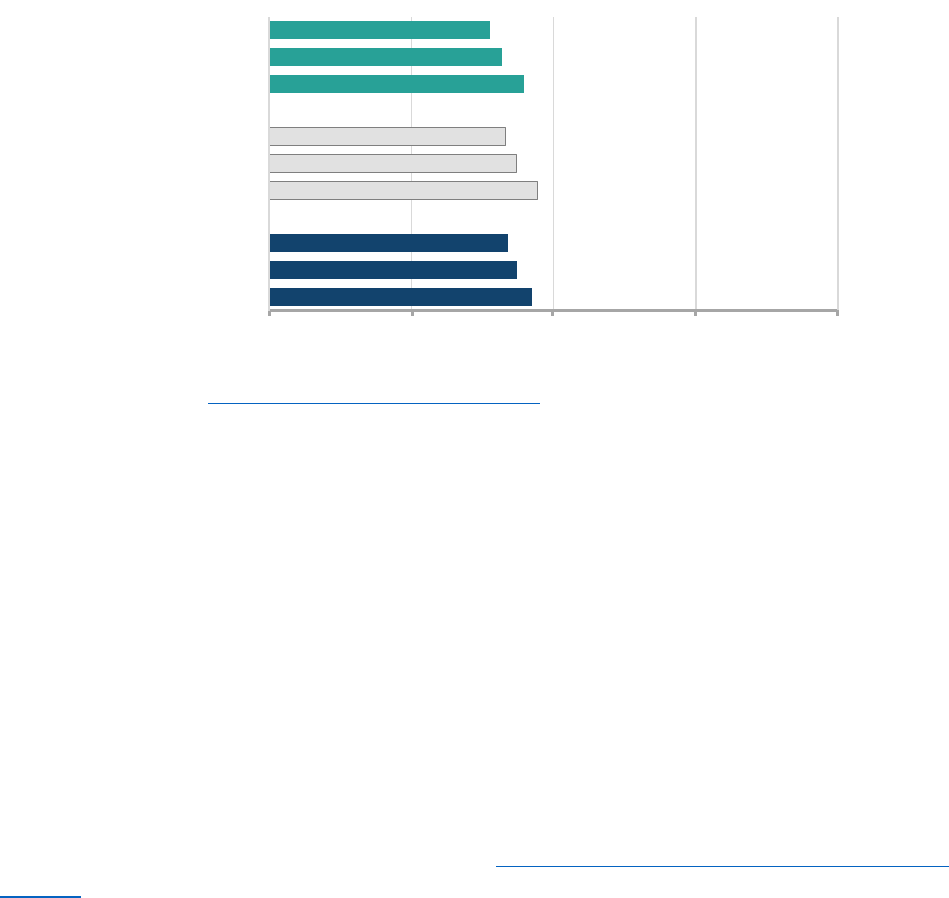
Digest of Rural England: 8 – Energy
48
Figure C-1: A horizontal bar chart showing the percentage of domestic properties with
Energy Performance Certificate (EPC) ratings of C or better by Local Authority Rural-Urban
Classification in 2021, 2022 and 2023 (Note C-4)
Worksheet HB in the energy supplementary data tables
contains tables showing the percentage of
domestic properties with Energy Performance Certificate (EPC) ratings of C or better for every
Local Authority.
Proportion of Category C properties by property age
In Section C it was shown that the average Energy Efficiency Score was lower for older properties,
and therefore it should be expected that the newer the property the higher the proportion of homes
with an EPC rating of at least C. This is demonstrated on Figure C-2. With the exception of newer
properties (2012 onwards), there was a smaller proportion of domestic properties in Predominantly
Rural areas with an EPC rating of at least C than in Predominantly Urban areas in 2023 (Figure
C-2, left-hand side). The gap between the estimates was biggest for properties built between1983
to 2011 (where the difference was 12 percentage points).
For pre-1930 properties in Predominantly Rural areas only 10.4% had an EPC rating of at least C
in 2023 compared to 16.5% in Predominantly Urban areas. There are over a million pre-1930
domestic properties in Predominantly Rural areas (
Table A-3, Statistical Digest of Rural England -
Housing). The Energy Efficiency Rating of 90% of the pre-1930 homes in Predominantly Rural
areas is low enough that any lower income occupants could be at risk of descending into fuel
poverty due to rising fuel costs or significant changes in household circumstances that further
reduce their household income. For domestic properties built between 1930 and 1982, 29.1% of
them in Predominantly Rural areas had an EPC rating of C or better in 2023 compared to 36.4% in
Predominantly Urban areas. Predominantly Rural areas lagged behind Predominantly Urban areas
for 1983 to 2011 homes with 58% of them having an EPC rating of C and above compared to
70.4% of those in Predominantly Urban areas.
Within Rural areas, the more Rural the area the lower the proportion of domestic properties with an
EPC rating of C and above. For properties built prior to 2012, the proportion of properties that are
at least category C was three to four percentage points lower in Mainly Rural areas than in Largely
Rural areas (Figure C-2, right-hand side). Overall, 46.2% of domestic properties in Largely Rural
areas had an EPC rating of at least C compared to 43.5% in Mainly Rural areas. In both cases this
is an increase on six percentage points on 2021 when 40.0% of properties in Largely Rural areas
had an EPC rating of C and above compared to 37.9% in Mainly Rural areas.
0% 25% 50%
75% 100%
2021
2022
2023
2021
2022
2023
2021
2022
2023
Predominantly
Rural
Urban with
Significant
Rural
Predominantly
Urban
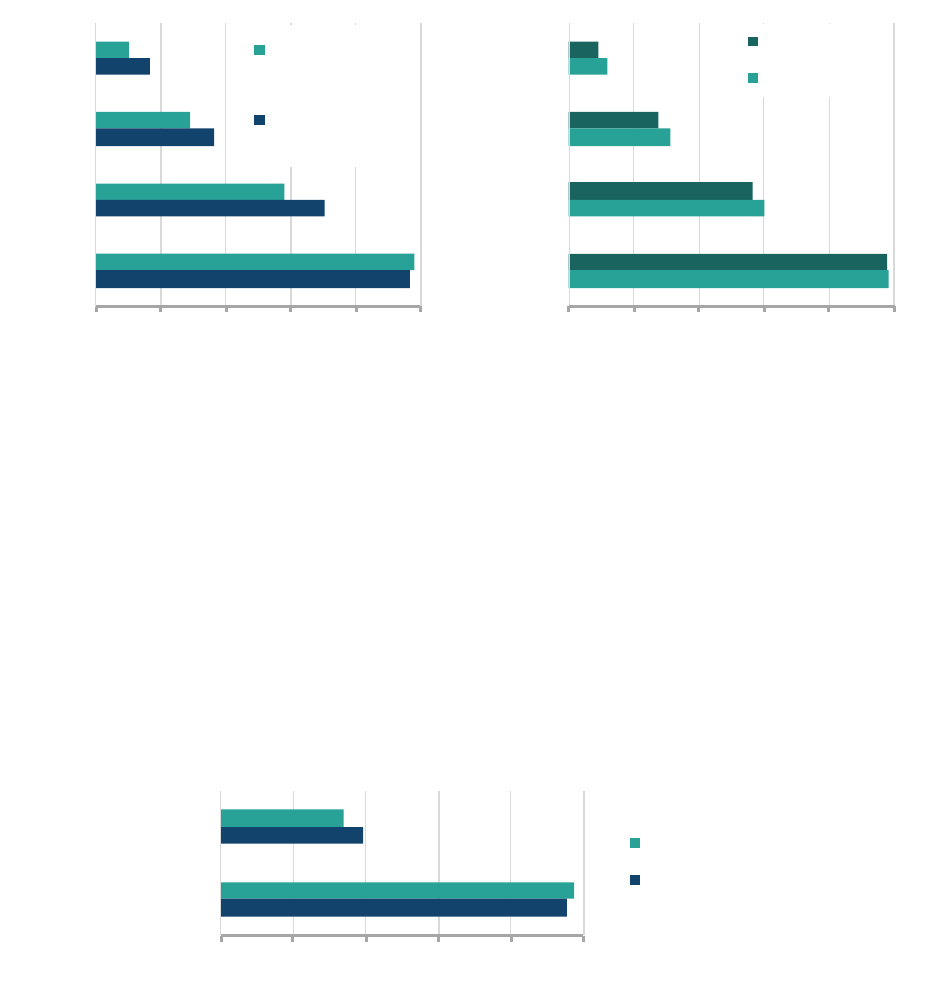
Digest of Rural England: 8 – Energy
49
Figure C-2: Horizontal bar charts showing the percentage of domestic properties with
Energy Performance Certificate (EPC) ratings of C or better by property age and Rural-
Urban Classification in 2023 (Note C-4)
The left-hand chart shows the comparison between Rural and Urban areas and the right-hand
chart shows the comparison within Rural areas. On both charts, the legend is presented in the
same order and orientation as the cluster of bars.
Splitting domestic properties into new dwellings and existing dwellings simplifies the picture (Figure
C-3). Any property that has undergone a conversion to change its use is considered to be a new
property from an EPC perspective (Note C-6). Almost all new dwellings are energy efficiency
category C or better, including on average 97.5% in Predominantly Rural areas in 2023. This is
slightly higher than the 95.2% for Predominantly Urban areas. The reverse was true for existing
dwellings. For Predominantly Rural areas 33.7% of existing dwellings had an Energy Efficiency
Rating of at least category C compared to 39.1% of existing dwellings in Predominantly Urban
areas – a difference of five percentage points.
Figure C-3: A horizontal bar chart showing the percentage of domestic properties with
Energy Performance Certificate (EPC) ratings of C for new and existing dwellings by Rural-
Urban Classification in 2023 (Note C-4, Note C-6)
The legend is presented in the same order and orientation as the cluster of bars.
In three-quarters of Predominantly Rural areas less than 11.7% of the of the pre-1930 domestic
properties had an Energy Efficiency Rating of at least category C. By contrast in three-quarters
Predominantly Urban areas more than 11.8% of the pre-1930 domestic properties had an Energy
Efficiency Rating of at least category C. In Predominantly Rural areas there were five areas where
less than 6.5% of the pre-1930 properties were at least category C for their energy efficiency
(Table C-1). At the other end of the spectrum for Predominantly Rural areas there were six areas
where more than 15% of the pre-1930 properties were at least category C for their energy
efficiency (Table C-2). In Predominantly Urban areas there were three areas where less than 6.5%
0% 20% 40% 60% 80% 100%
Pre-
1930
1930
to 1982
1983
to 2011
2012
onwards
Predominantly
Rural
Predominantly
Urban
0% 20% 40% 60% 80% 100%
Pre-
1930
1930
to 1982
1983
to 2011
2012
onwards
Mainly Rural
Largely Rural
0% 20% 40% 60% 80% 100%
Existing
dwellings
New
dwellings
Predominantly Rural
Predominantly Urban
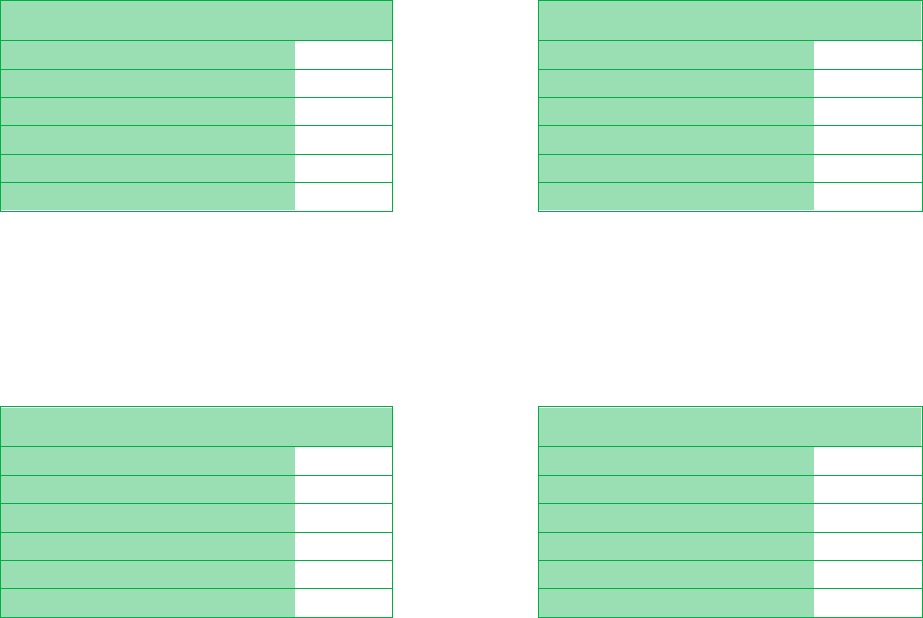
Digest of Rural England: 8 – Energy
50
of the pre-1930 properties were at least category C for their energy efficiency (Table C-3). Bradford
had only 6% of its pre-1930 properties with an Energy Efficiency Rating of at least C – the lowest
of any Local Authority. At the upper end of the Predominantly Urban distribution, there were six
areas where more than 35% of the pre-1930 properties were at least category C for their energy
efficiency (Table C-4). All six of these areas were London boroughs. The only area outside of
London which had more that 30% of its pre-1930 properties with an energy efficiency of at least
category C was Newcastle upon Tyne (30.2%). County Durham had the highest proportion of
category C and above pre-1930 domestic properties amongst Predominantly Rural areas (17.3%)
but there were 61 Predominantly Urban Local Authorities whose proportion of pre-1930 properties
with an energy efficiency of at least category C was more than 17.3%.
Table C-1: The 6 Predominantly Rural
areas with the lowest proportion of pre-
1930 properties with an Energy Efficiency
Rating of at least C in 2023 (
Note C-4)
Predominantly Rural area %
Cotswold
6.2
Eden
6.2
Maldon
6.3
Mid Suffolk
6.5
King's Lynn and West Norfolk
6.5
North Kesteven
6.7
Table C-2: The 6 Predominantly Rural
areas with the highest proportion of pre-
1930 properties with an Energy Efficiency
Rating of at least C in 2023 (
Note C-4)
Predominantly Rural area %
Teignbridge
15.1
East Suffolk
15.4
Northumberland
15.7
Rother
15.7
High Peak
16.7
County Durham
17.3
Table C-3: The 6 Predominantly Urban
areas with the lowest proportion of pre-
1930 properties with an Energy Efficiency
Rating of at least C in 2023 (
Note C-4)
Predominantly Urban area %
Bradford
6.0
Redditch
6.2
Hartlepool
6.4
Calderdale
6.8
Castle Point
7.0
Milton Keynes
7.7
Table C-4: The 6 Predominantly Urban
areas with the highest proportion of pre-
1930 properties with an Energy Efficiency
Rating of at least C in 2023 (
Note C-4)
Predominantly Urban area %
Hammersmith and Fulham
35.5
Islington
35.5
Camden
37.9
Kensington and Chelsea
38.6
Westminster
42.0
City of London
50.5
Moving on to the 1930 to 1982 domestic properties, a quarter of Predominantly Rural areas had
less than 26% of properties from this period with an energy efficiency of at least category C. Only a
quarter of Predominantly Rural areas had more than 33% of 1930 to 1982 properties with an
energy efficiency of at least category C. There were six Predominantly Rural areas where less than
19.5% of the 1930 to 1982 domestic properties had an energy efficiency of at least category C
(Table C-5). The only Predominantly Rural area where more than 40% of the 1930 to 1982
properties was at least category C for energy efficiency was Winchester, and the top six all had at
least 36% of 1930 to 1982 domestic properties with an energy efficiency of at least category C
(Table C-6).
Half of the Predominantly Urban areas had at least 35.5% of the 1930 to 1982 domestic properties
with an energy efficiency of at least category C. The only Predominantly Urban area where less

Digest of Rural England: 8 – Energy
51
than 20% of the 1930 to 1982 properties had an energy efficiency of at least category C was
Castle Point (Table C-7). Salford was the only Predominantly Urban areas where at least 55% of
the 1930 to 1982 properties had an energy efficiency of at least category C outside of London
(Table C-8). Only 11 Predominantly Rural areas had at least 35% of the 1930 to 1982 domestic
properties at category C or above; whereas in Predominantly Urban areas 84 local authorities had
at least 35% of the 1930 to 1982 properties at category C or above.
Table C-5: The 6 Predominantly Rural
areas with the lowest proportion of 1930 to
1982 properties with an Energy Efficiency
Rating of at least C in 2023 (
Note C-4)
Predominantly Rural area %
Isles of Scilly
15.5
South Holland
18.0
Ryedale
18.6
Staffordshire Moorlands
19.2
North Norfolk
19.4
Maldon
19.5
Table C-6: The 6 Predominantly Rural areas
with the highest proportion of 1930 to 1982
properties with an Energy Efficiency Rating
of at least C in 2023 (
Note C-4)
Predominantly Rural area %
Northumberland
36.0
Stratford-on-Avon
36.5
East Hampshire
36.7
County Durham
37.4
South Somerset
37.9
Winchester
40.2
Table C-7: The 6 Predominantly Urban
areas with the lowest proportion of 1930 to
1982 properties with an Energy Efficiency
Rating of at least C in 2023 (
Note C-4)
Predominantly Urban area %
Castle Point
16.8
Rochford
20.4
Fylde
21.1
Blackpool
22.8
Blaby
24.0
Havering
24.2
Table C-8: The 6 Predominantly Urban
areas with the highest proportion of 1930 to
1982 properties with an Energy Efficiency
Rating of at least C in 2023 (
Note C-4)
Predominantly Urban area %
Tower Hamlets
55.9
Hackney
55.9
Salford
56.2
Wandsworth
56.2
Newham
59.0
Westminster
59.1
There is only one Predominantly Urban area (Blaby, 49.9%) where less than half of the 1983 to
2011 domestic properties were at least category C for energy efficiency. However, in Predominantly
Rural areas, the six areas with the lowest proportion of 1983 to 2011 properties with an Energy
Efficiency Rating of at least C all had less than 49%. At the other end of the scale there were 11 (of
84) Predominantly Rural areas where more than 65% of the 1983 to 2011 properties had an energy
efficiency of at least category C. Most of these areas were in the South. By contrast 121 (of 175)
Predominantly Urban areas had more than 65% of their 1983 to 2011 domestic properties with an
energy efficiency of at least category C. In other words, 13% of Predominantly Rural areas had
almost two-thirds of their 1983 to 2011 domestic properties at energy efficiency category C and
above, compared to 70% of Predominantly Urban areas having almost two thirds of their 1983 to
2011 domestic properties at energy efficiency category C and above.
Worksheet HB in the energy supplementary data tables
contains tables showing the percentage of
domestic properties with Energy Performance Certificate (EPC) ratings of C or better for every Local
Authority.
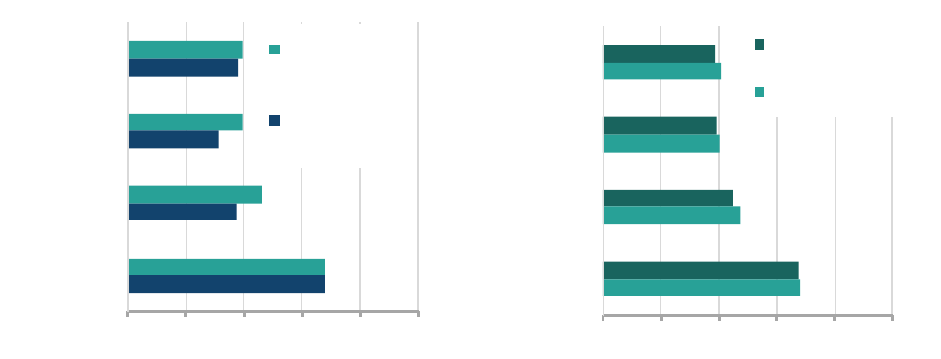
Digest of Rural England: 8 – Energy
52
Proportion of category C properties by property type and tenure
Section C showed that, on average, flats and maisonettes had a higher average Energy Efficiency
Score and consequently in 2023 there were proportionally more Flats and maisonettes with an
EPC rating of at least C than for any other domestic property type (Figure C-4, left-hand chart).
For Semi-detached and Terraced properties, the proportion of properties that are at least category
C is higher in Predominantly Rural areas than in Predominantly Urban areas by eight percentage
points. While for the other two property types the proportions were similar. In Predominantly Rural
areas the proportion of properties with an Energy Efficiency Rating of at least category C by
property type is as follows: Detached, 40%; Semi-detached, 40%; Terraced, 46%; and Flats and
maisonettes, 68%.
For Detached and Terraced properties, the proportion of properties with an EPC rating of at least C
is two to three percentage points greater in Largely Rural areas than in Mainly Rural areas (Figure
C-4, right-hand chart). For Flats and Semi-detached there is little difference in the proportion of
properties with an EPC rating of at least C.
Figure C-4: Horizontal bar charts showing the percentage of domestic properties with
Energy Performance Certificate (EPC) ratings of C or better by property type and Rural-
Urban Classification in 2023 (Note C-4, Note C-7)
The left-hand chart shows the comparison between Rural and Urban areas and the right-hand
chart shows the comparison within Rural areas. On both charts, the legend is presented in the
same order and orientation as the cluster of bars.
In terms of tenure, in 2023 the Social rented sector offered the highest proportion of domestic
properties with an Energy Efficiency Rating of at least category C in both Predominantly Rural and
Predominantly Urban areas (Figure C-5, left-hand chart). In Predominantly Rural areas, more than
half of the Social rented sector properties had an EPC rating of at least C. Whereas for Owner-
occupied properties just under a third (32.4%) had an Energy Efficiency Rating of at least category
C in 2023. For both the Private and the Social rented sectors there was a lower proportion of
properties with an EPC rating of at least C in Predominantly Rural areas than in Predominantly
Urban areas (Figure C-5, left-hand chart). For both rental categories the proportion of properties
with an EPC rating of at least C is six to seven percentage points lower in Predominantly Rural
areas. For owner occupied properties, the proportion with an EPC rating of at least C is also lower
in Predominantly Rural areas than in Predominantly Urban areas but the difference (two
percentage points) is smaller than for the rental sector. Within Rural areas there was a lower
0% 20% 40%
60% 80% 100
%
Detached
Semi-
detached
Terraced
Flats and
maisonettes
Predominantly
Rural
Predominantly
Urban
0% 20% 40% 60% 80% 100%
Detached
Semi-
detached
Terraced
Flats and
maisonettes
Mainly Rural
Largely Rural
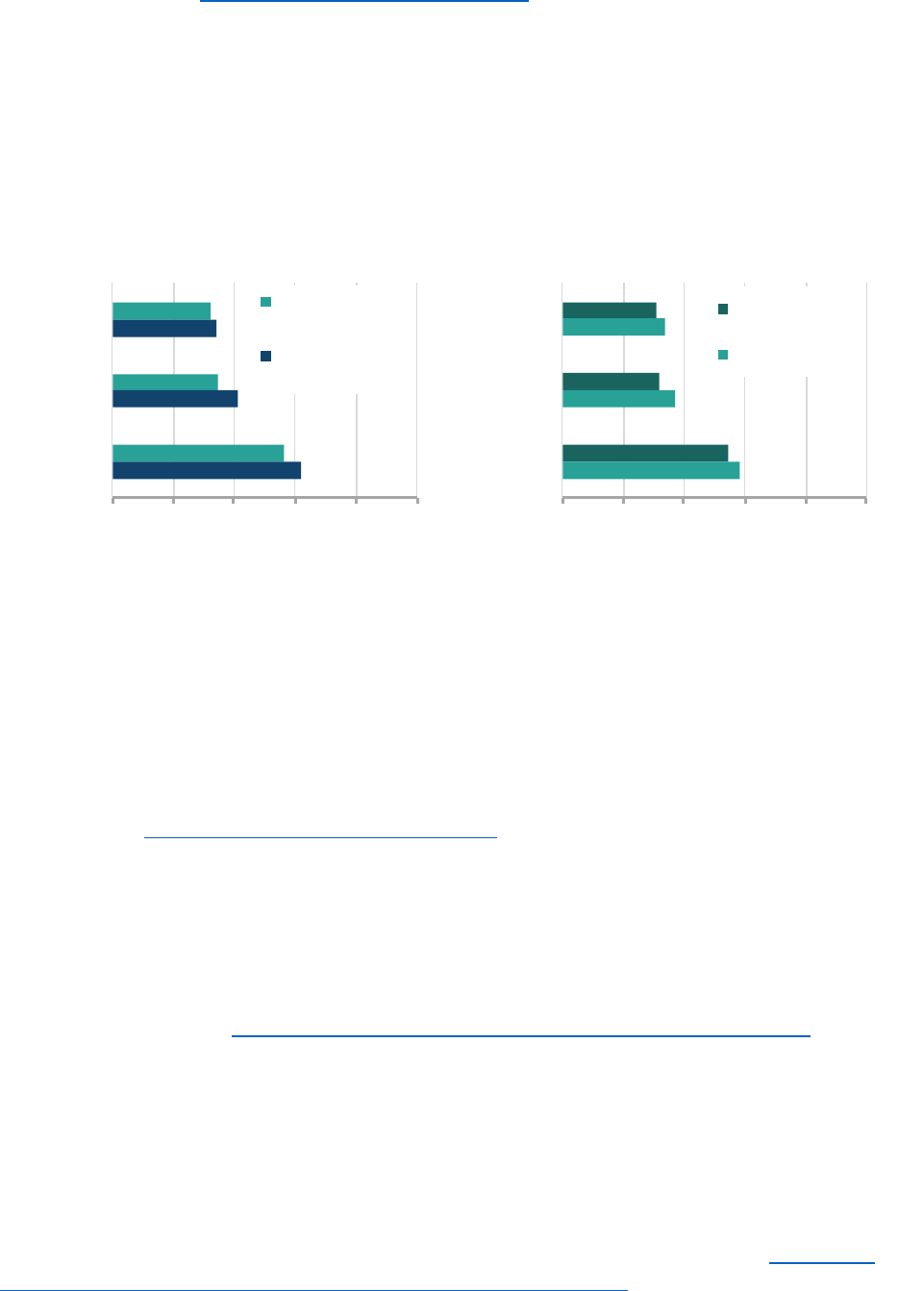
Digest of Rural England: 8 – Energy
53
proportion of properties with an EPC rating of at least C in Mainly Rural areas than in Largely Rural
areas for both the rented sector and owner-occupied properties (Figure C-5, right-hand chart).
Worksheet HB in the housing supplementary data tables
c
ontains tables showing the percentage
of domestic properties with Energy Performance Certificate (EPC) ratings of C or better by property
type and by tenure for every Local Authority.
Figure C
-5: Horizontal bar chart showing the percentage of domestic properties with Energy
Performance Certificate (EPC) ratings of C or better by tenure and Rural Urban
Classification in 2023 (Note C-4)
The left-hand chart shows the comparison between Rural and Urban areas and the right-hand
chart shows the comparison within Rural areas. On both charts, the legend is presented in the
same order and orientation as the cluster of bars.
EPCs: achieving energy efficiency Category C explanatory notes
• Note C-1
Fuel poverty or being fuel poor is where a household is living in a property with a Fuel Poverty Energy
Efficiency Rating (FPEER) of band D or below in a home that cannot be kept warm at reasonable cost
without bringing their residual income (after housing and energy costs) below the poverty threshold. As
explained in Section A
Fuel poverty, Fuel poverty in England is defined using the Low Income Low Energy
Efficiency approach.
Figure 2.2 in the Annual fuel poverty statistics report: 2023
gr
aphically displays how fuel poor households
are defined.
• N
ote C-2
The statutory fuel poverty target was set in December 2014, binding successive Governments to the
following:
The fuel poverty target is to ensure that as many fuel poor homes as is reasonably practicable achieve a
minimum Energy Efficiency Rating of Band C, by 2030.
This target was retained in Sustainable Warmth, the updated Fuel Poverty Strategy for England, published in
February 2021. There is also an interim “target” in relation to band D and 2025.
• N
ote C-3
The FPEER uses a modified version of the standard Energy Efficiency Rating which considers policies that
directly affect the cost of energy. In recent years this has included the rebate provided by Warm Home
Discount. The FPEER methodology deducts such rebates from the overall modelled costs produced under
the SAP system. This gives an Energy Efficiency Rating (again from 1-100), which will be higher than the
standard rating if the household receives additional support. This modified rating is also translated to a band
(A to G) on the same bases as the original system displayed in
Table B-1. The document Fuel poverty
methodology handbook 2023: Low Income Low Energy Efficiency (LILEE) gives further details.
0% 20% 40% 60% 80% 100%
Owner-
occupied
P ri vat e
rent
Social
rent
Predominantly
Rural
Predominantly
Urban
0% 20%
40% 60
% 80% 100%
Owner-
occupied
P ri vat e
rent
Social
rent
Mainly Rural
Largely Rural

Digest of Rural England: 8 – Energy
54
• Note C-4
The Office for National Statistics (ONS) publish Energy Efficiency of Housing
at Local Authority level on an
annual basis for financial years. This section primarily uses the Energy Performance Certificate (EPC) Band
C or above, England and Wales dataset for the financial year ending
March 2023. Where 2021 or 2022 data
has been used it is available from the dataset called Energy efficiency of Housing, England and Wales, local
authority districts.
The source data for this ONS publication is Department for Levelling up, Housing and Communities – Energy
Performance Certificate data on Open Data Communities and Valuation Office Agency - Property Attributes
data (https://epc.opendatacommunities.org/
).
• Note C-5
Tables showing the data in Section C are available in the energy supplementary tables
.
• Note C-6
Statistics for new properties were generated using data from new dwelling EPC records, which include new
builds, conversions and change of use. Statistics for existing properties were generated using the latest
EPC lodgement available for a property, within the existing dwellings records. An existing dwelling may have
undergone several EPC assessments for different reasons (for example, due to a marketed sale, for a green
deal assessment, or following the implementation of the changes suggested in a green deal assessment).
New and existing dwellings are assessed using slightly different methodologies.
• Note C-7
ONS break down houses (including bungalows and park homes) into Detached, Semi-detached and
Terraced property types and group flats and maisonettes together as the final property type.
Digest of Rural England: 8 – Energy
55
D. Energy Costs
The lower energy efficiency of older and / or detached houses means that their modelled
energy costs are higher than new properties or flats in both Rural and Urban areas.
Summary
Since 2007, an Energy Performance Certificate (EPC) is required when a building is constructed,
sold, or let. Standardised costs are generated as part of the EPC process. This analysis uses
these standardised cost and not actual real world costs data from energy suppliers. Data
presented here are for 2021 and does not reflect subsequent changes in energy costs.
In 2021 dwellings in Predominantly Rural areas were estimated to have an average median energy
cost of £815 per year. This was £95 per year more than the £725 for dwellings in Predominantly
Urban areas. In Predominantly Rural areas, the estimated average median energy cost was £430
per year for new properties and more than double that for existing properties (£900 per year).
Flats and maisonettes had the lowest modelled energy costs in both Predominantly Rural (£470
per year) and Predominantly Urban (£480 per year) areas. Detached housing had the highest
estimated energy costs at £1,085 per year in Predominantly Rural areas and £1,100 per year in
Predominantly Urban areas.
For Owner-occupied and private rented properties, the average median energy cost was £110 per
week higher in Predominantly Rural areas than in Predominantly Urban areas in 2021. In
Predominantly Rural areas an Owner-occupied home was modelled to cost £975 per year
compared to £865 in a Predominantly Urban area. For Social rented properties the cost was £615
per year in Predominantly Rural areas and £570 in Predominantly Rural areas – a difference of
only £45 per year.

Digest of Rural England: 8 – Energy
56
Theoretical rather than actual energy costs
Since 2007, an Energy Performance Certificate (EPC) is required when a building is constructed,
sold or let (Note D-1). The ONS use information from EPCs for their Energy Efficiency of Housing
publication (Note D-2). In the March 2021 dataset, the ONS also included information on the
median estimated energy cost for domestic properties.
As part of the EPC data the estimated energy cost (sum of estimated lighting, heating and hot
water costs) are generated. These are based on standardised assumptions about how residents
will use the property (such as number of occupants, heating patterns and lighting and hot water
usage). This is to make properties directly comparable to each other for prospective buyers or
tenants, so it does not reflect how residents actually use the property.
This analysis is therefore based upon these standardised costs not actual real world costs
data from energy suppliers. The source data used for this analysis precedes increased
energy costs that started to take effect in late 2021.
Energy cost: New versus existing properties
The ONS data includes energy cost estimates for new and existing properties. Statistics for new
properties were generated using data from new dwelling EPC records, which include new builds,
conversions and change of use. Statistics for existing properties were generated using the latest
EPC lodgement available for a property, within the existing dwellings records.
Dwellings in Predominantly Rural Local Authorities were estimated to have an average median
energy cost of £815 per year (Table D-1). This was £95 per year more than the estimated average
median energy cost for dwellings in Predominantly Urban Local Authorities.
Table D-1: Estimated average median energy cost (£ per year) for dwellings in England split
by the Local Authority Rural-Urban Classification as of March 2021 (Note D-6)
Based on standardised assumptions about how residents will use the property rather than actual
usage costs.
2021
Predominantly Rural
£815
Urban with Significant Rural
£765
Predominantly Urban
£720
England
£750
Newer properties are typically more energy efficient than older ones (Figure B-5). Therefore, the
estimated average median energy cost for new dwellings was much lower than for existing
properties (Figure D-1). This was the case in both Rural and Urban areas. In Predominantly Rural
areas, the estimated average median energy cost for new properties was less than half of the cost
for existing properties.
The estimated average median energy cost was higher in Predominantly Rural areas than in
Predominantly Urban areas for both new properties and existing properties. For new properties the
estimated average median energy cost in Predominantly Rural areas was £430 per year and for
existing properties it was £900 per year. This makes the estimated average median energy cost in
Predominantly Rural areas 11% more than in Predominantly Urban areas for new properties and
16% more for existing properties.
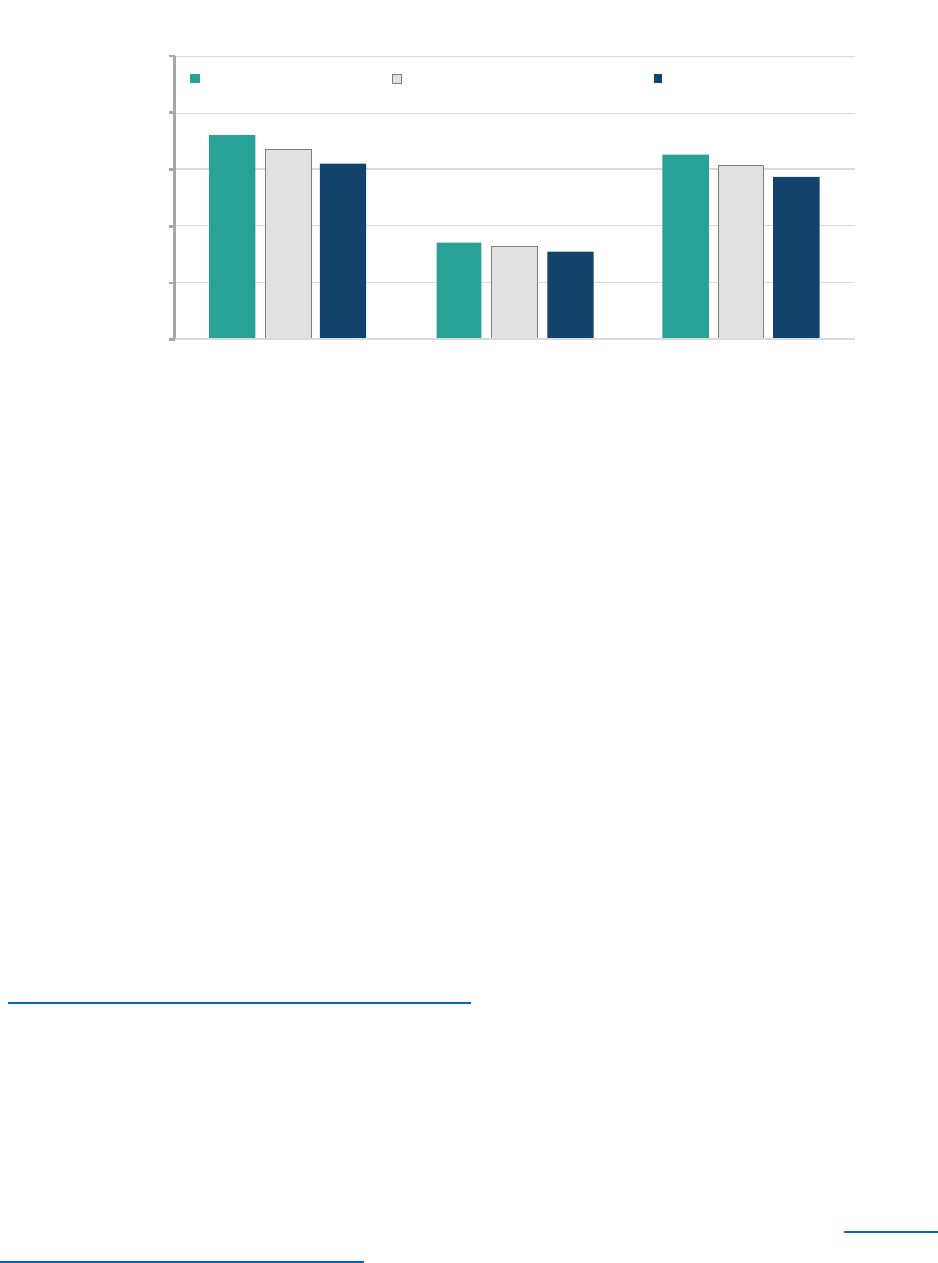
Digest of Rural England: 8 – Energy
57
Figure D-1: Bar chart showing the estimated average median energy cost (£ per year) for
new, existing and all dwellings in England split by broad Local Authority Rural-Urban
Classification as of March 2021 (Note D-1, Note D-2, Note D-3)
The legend is presented in the same order as the clusters of columns.
Energy cost: Housing type
Flats and maisonettes are typically more energy efficient than other property types (Table B-4); so,
they end up with the lowest modelled energy costs across the four main dwelling types (Figure
D-2). In 2021 the estimated energy cost for Flats and maisonettes varied little between
Predominantly Rural (£470 per year) and Predominantly Urban (£480 per year) areas. Detached
housing has the highest estimated energy costs. The estimated cost was marginally lower in
Predominantly Rural areas (£1,085 per year) than in Predominantly Urban areas (£1,100 per year).
The higher energy cost for Detached properties was a reflection of these properties often being
bigger and typically having more occupants, rather than Detached houses being less energy
efficient. Energy costs for Semi-detached and Terraced houses in Predominantly Rural areas were
estimated to be £100 per year and £75 per year cheaper than Semi-detached and Terraced
houses (respectively) in Predominantly Urban areas.
It might seem counter intuitive that estimated average energy costs were lower in Predominantly
Rural areas for each of the four housing types and yet the average energy costs across all
dwellings were higher in Predominantly Rural areas. However in 2020, Flats made up only 7% of
the Rural housing stock compared to 26% of the Urban housing stock; whilst Detached properties
made up 49% of the Rural housing stock compared to only 16% of the Urban housing stock
(Statistical Digest of Rural England: 2 –Housing
).
In generating the overall Rural and Urban estimates in Table D-1, this analysis used source data
that was the median energy cost for properties within each Local Authority. The median is the
middle value when the dataset is ordered sequentially. When this is done for an Urban area, the
cost is likely to be representative of the cost associated with a Terraced house since Flats and
Terraced homes combined account for more than 50% of the Urban housing stock and a typical
Terraced property has a higher theoretical energy cost than a typical Flat. Whereas in a Rural
area, where around three in four properties were Detached or Semi-detached in 2020 (Statistical
Digest of Rural England: 2 –Housing), this median value is more likely to be representative of the
cost associated with a Semi-detached house. Thus, when looking at England level average median
£0
£250
£500
£750
£1,000
£1,250
Existing dwellings
New dwellings All dwellings
Predominantly Rural
Urban with Significant Rural Predominantly Urban
Cost per year
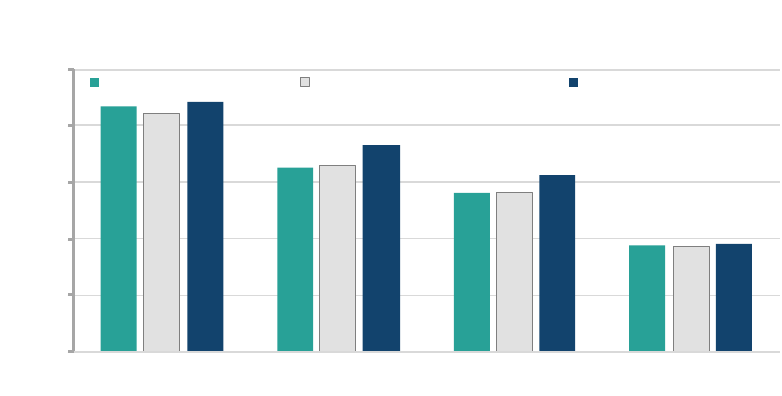
Digest of Rural England: 8 – Energy
58
energy cost estimates for Rural and Urban areas the average cost was higher overall for Rural
areas despite the energy costs in Rural areas being lower for each of the housing types when
analysed separately.
Figure D-2: Bar chart showing the estimated average median energy cost (£ per year) for
different property types split by broad Local Authority Rural-Urban Classification as of
March 2021 (Note D-1, Note D-2, Note D-4)
The legend is presented in the same order as the clusters of columns.
Energy cost: Housing tenure
Irrespective of whether the property was Owner-occupied or rented the average median energy
cost was higher in Predominantly Rural areas than in Predominantly Urban areas in 2021 (Figure
D-3). For both Owner-occupied and Privately rented properties the average median energy cost
was £110 per year more in Predominantly Rural areas than in Predominantly Urban areas. For
Social rented properties the gap was much smaller, the average median energy cost for a social
rent property was only £45 per year more in a Predominantly Rural area than in a Predominantly
Urban area.
In all 3 broad Rural-Urban categories, Social rented properties had the lowest average median
energy cost and Owner-occupied had the highest in 2021 (Figure D-3). In Predominantly Rural
areas the average median energy cost for Owner-occupied properties was £360 more than for
Social rent properties. When analysed in Statistical Digest of Rural England: 2 –Housing, Social
rent properties had a higher average energy efficiency rating than other property types and are
often smaller than Owner-occupied properties; so, they end up with the lowest modelled energy
costs. A rental agreement will have a minimum term, which can be as little as 6 months. Some but
not all agreements will be extended beyond this initial period. This means that the turnover of
occupants can be greater in rental properties than in owner occupied properties. Thus, a Private
rental property is likely to have had more EPC assessments than an Owner-occupied property
meaning that home improvements have more chance of being captured within the EPC data.
These then reduce the projected energy costs for the improved properties.
£0
£250
£500
£750
£1,000
£1,250
Detached Semi-detached Terraced
Flats and maisonettes
Predominantly Rural
Urban with Significant Rural
Predominantly Urban
cost per year
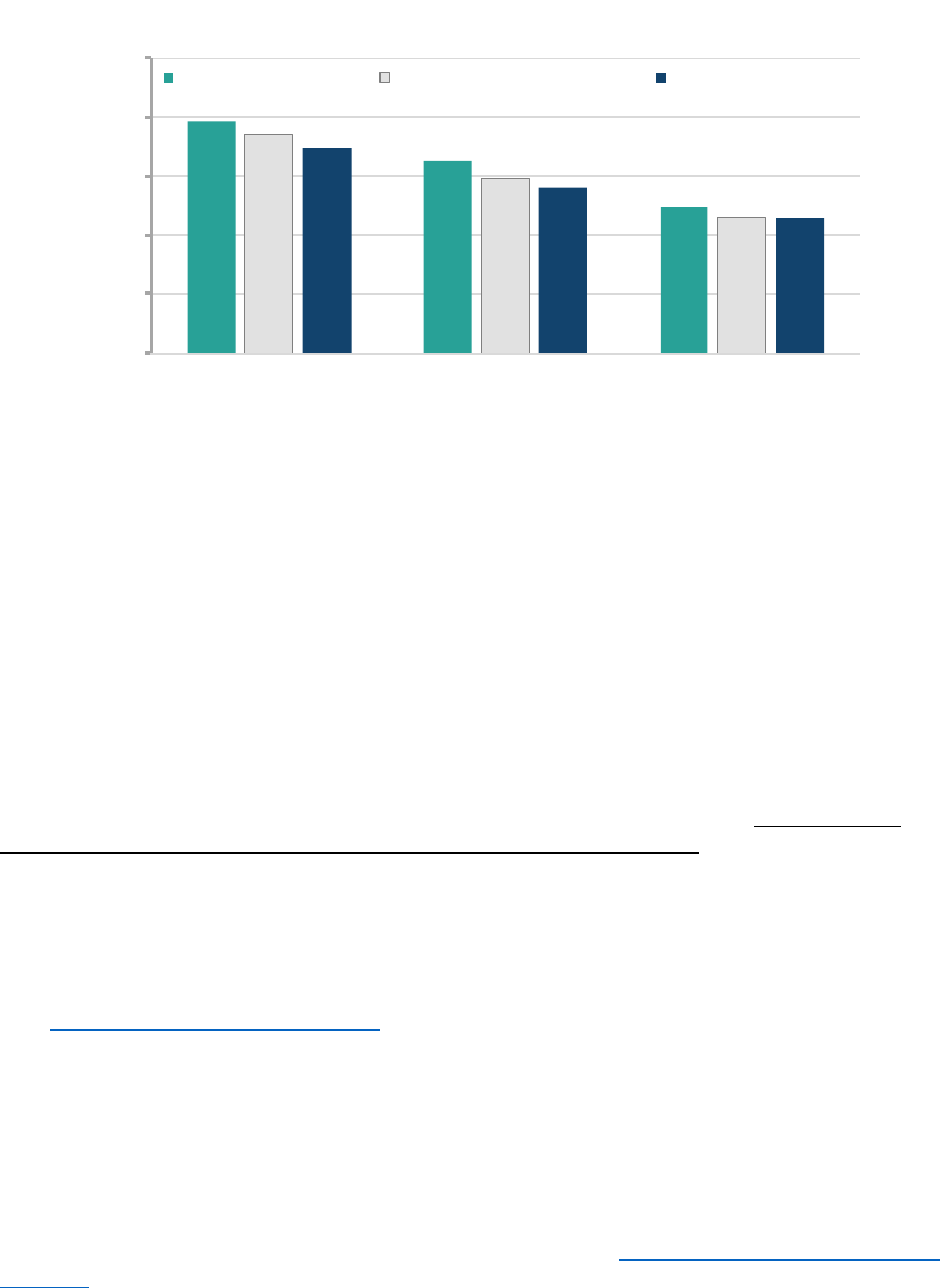
Digest of Rural England: 8 – Energy
59
Figure D-3: Bar chart showing the estimated average median energy cost (£ per year) for
property tenures split by broad Local Authority Rural-Urban Classification as of March 2021
(Note D-1, Note D-2)
The legend is presented in the same order as the clusters of columns.
Energy Costs explanatory notes
• Note D-1
An Energy Performance Certificate (EPC) provides information on the energy efficiency of a building. Since
2007, an EPC is required when a building is constructed, sold or let and it is valid for 10 years. There can be
multiple EPC lodgements for the same dwelling, but only the latest lodgement is analysed to avoid double
counting dwellings.
EPCs are based on data about a building’s energy features (for example the building materials used, heating
systems and insulation), which are collected by an accredited energy assessor and are entered into a
government-approved software to generate the EPC.
The median energy efficiency scores are calculated based on the energy efficiency scores at the time the
EPC lodgement was assessed. This means that these statistics do not necessarily reflect energy efficiency
improvements as the majority of alterations don’t require a new EPC to be generated. Energy costs will
therefore also be reflective of the point at which the EPC assessment was made.
Energy Performance Certificate (EPC) are described in more detail in Energy Performance Certificates and
ratings within section B.
• Note D-2
The source data for this ONS publication is Department for Levelling up, Housing and Communities – Energy
Performance Certificate data on Open Data Communities and Valuation Office Agency - Property Attributes
data (https://epc.opendatacommunities.org/
).
• Note D-3
The category “New dwellings” includes: new builds, conversions and change of use properties.
• Note D-4
ONS break down houses (including bungalows and park homes) into Detached, Semi-detached, and
Terraced property types, and group Flats and maisonettes together as the final property type.
• Note D-5
An analysis of housing stock by property age and type can be found in
Statistical Digest of Rural England: 2
–Housing.
£0
£250
£500
£750
£1,000
£1,250
Owner
-occupied Private rent Social rent
Predominantly Rural Urban with Significant Rural Predominantly Urban
Cost per year
Digest of Rural England: 8 – Energy
61
E. Energy Consumption
Average domestic electricity consumption is higher in Predominantly Rural areas than
Predominantly Urban areas but the reverse is true for domestic gas consumption.
Summary
The Department for Energy Security and Net Zero produce local authority level gas and energy
consumption data based on meter level data. A third party collects and aggregates the data from
gas and electricity suppliers. Consumption will be affected by a number of factors including
differences in the sizes and types of properties and premises in rural and urban areas.
Rural domestic electricity consumption is higher than Urban domestic consumption. In 2021, the
average median domestic electricity consumption was 3,000 kWh per meter in Predominantly
Rural areas and 2,700 kWh per meter in Predominantly Urban areas. When compared to
consumption in 2015, the 2021 average median domestic electricity consumption was 500 kWh per
meter lower in Predominantly Rural areas and 400 kWh per meter lower in Predominantly Urban
areas. In 2021, the average median non-domestic electricity consumption was similar in
Predominantly Rural areas and Predominantly Urban areas and stood at 7,000 kWh per meter. In
2015, the average median non-domestic electricity consumption was 8,300 kWh per meter in
Predominantly Rural areas and 8,900 kWh per meter in Predominantly Urban areas.
In 2021 in Predominantly Rural areas average median domestic gas consumption was 11,100 kWh
per meter, a drop of 910 kWh per meter (7.6%) from the previous year. In Predominantly Urban
areas it was 11,500 kWh per meter, a drop of 770 kWh per meter (6.3%). Since 2017 domestic gas
consumption has been lower in Predominantly Rural areas than in Predominantly Urban areas. It is
also possible to look at average median gas consumption for non-domestic premises. In 2021 it
stood at 142,000 kWh per non-domestic meter in Predominantly Rural areas and 150,000 kWh per
non-domestic meter in Predominantly Urban areas.
Note that the gas data is weather corrected to allow for comparisons over time.

Digest of Rural England: 8 – Energy
62
Energy consumption data
The Department for Energy Security & Net Zero produce National Statistics on gas and electricity
consumption annually.
Sub-national electricity consumption data is available for all of the Local Authorities in Great Britain
for the period 2005 to 2021 in their most recent publication from December 2022. The electricity
figures are based on meter level electricity consumption data provided by data aggregators (who
compile this data on behalf of electricity suppliers).
Sub-national gas consumption data is available for all of the Local Authorities in Great Britain for
the period 2005 to 2021 in their most recent publication from December 2022. These figures are
based on meter level gas consumption data provided by Xoserve (who compile meter level data
from gas shippers, who in turn receive the data from gas suppliers). Xoserve provide annualised
estimates of consumption for all gas meters. These estimates are weather-corrected to enable
better comparisons over time (
Note E-5).
Energy consumption: Electricity
Electricity data is divided between domestic and non-domestic categories according to the meter’s
profile class (Note E-4). Here we address domestic consumption first followed by non-domestic
consumption.
The proportion of total domestic electricity consumption assigned to Predominantly Rural Local
Authorities remained at 24% across the period 2015 to 2021 (Note E-1). Figure E-1 (left-hand
chart) shows that the average median domestic electricity consumption in Predominantly Rural
areas is higher than in Predominantly Urban areas. This reflects the larger properties in
Predominantly Rural areas. Over the period from 2015 to 2019 electricity consumption declined
year on year in both Predominantly Rural and Urban areas.
Figure E-1: Line charts showing the estimated average median electricity consumption
(kWh per meter) by broad Local Authority Rural-Urban Classification 2015 to 2021 (Note E-2)
The left-hand chart is for Domestic properties and the right-hand chart is for Non-domestic
properties. Note that the scale on the y-axis differs between the two charts.
2,000
2,500
3,000
3,
500
2015 2016 2017 2018 2019 2020 2021
Median consumption
(kWh per meter)
Rural
Urban
Domes�c
5,000
6,000
7,000
8,000
9,000
2015 2016 2017 2018 2019 2020 2021
Median consumption
(kWh per meter)
Urban
Rural
Non-domes�c
Digest of Rural England: 8 – Energy
63
In 2020 when COVID-19 pandemic hit the UK and people were forced to stay at home, median
electricity consumption went up in both Predominantly Rural and Predominantly Urban areas. For
Predominantly Rural areas the average median domestic electricity consumption went up by 110
kWh per meter, whilst for Predominantly Urban areas the absolute increase was smaller (80 kWh
per meter). In percentage terms this is a 3% increase in domestic electricity consumption in both
Predominantly Rural and Predominantly Urban areas. With the stay-at-home restrictions largely
removed the average median domestic electricity consumption reduced again in 2021 by 8% (250
kWh per meter) in Predominantly Rural areas and 7% (210 kWh per meter) in Predominantly
Urban areas.
In 2021, the average median domestic electricity consumption was 2,980 kWh per meter in
Predominantly Rural areas and 2,680 kWh per meter in Predominantly Urban areas. When
compared to consumption in 2015, the 2021 average median domestic electricity consumption was
480 kWh per meter lower in Predominantly Rural areas and 430 kWh per meter lower in
Predominantly Urban areas.
As shown on Figure E-1 (right-hand chart), average median non-domestic electricity consumption
was lower in Predominantly Rural areas than in Predominantly Urban areas between 2015 and
2019. In 2015, the average median non-domestic electricity consumption was 8,310 kWh per
meter in Predominantly Rural areas and 8,910 kWh per meter in Predominantly Urban areas. With
the exception of 2017, when there was a modest rise, the average median non-domestic electricity
consumption fell year on year between 2015 and 2019 in both Predominantly Rural and
Predominantly Urban areas, but it fell at a faster rate in Predominantly Urban areas. In 2019, the
average median non-domestic electricity consumption was 7,410 kWh per meter in Predominantly
Rural areas and 7,510 kWh per meter in Predominantly Urban areas. Average median non-
domestic electricity consumption was 11% lower in Predominantly Rural areas in 2019 than in
2015, whilst in Predominantly Urban areas it was 16% lower in 2019 than in 2015.
In 2020, when stay-at-home orders led to the closure of many non-domestic presences for a period
of time to combat the spread of COVID-19, the average median non-domestic electricity
consumption fell by 1,360 kWh per meter in Predominantly Rural areas and by 1,720 kWh per
meter in Predominantly Urban areas. In percentage terms this was a fall in consumption of 18% in
Predominantly Rural areas and a fall of 23% in Predominantly Urban areas relative to 2019
average median consumption levels. This sharper fall in Predominantly Urban areas led to a higher
average median non-domestic electricity consumption in Predominantly Rural areas (6,050 kWh
per meter) than in Predominantly Urban areas (5,780 kWh per meter). Whilst average median
non-domestic electricity consumption rose again in 2021, it only rose to 7,030 kWh per meter in
Predominantly Rural areas and 7,010 kWh per meter in Predominantly Urban areas. This 2021
average median non-domestic consumption was 380 kWh per meter lower than the 2019 average
median non-domestic consumption in Predominantly Rural areas; whilst in Predominantly Urban
areas the 2021 consumption was 490 kWh lower.
In 2021, the total non-domestic electricity consumption in Predominantly Rural Local Authorities
was 29,500 GWh (Note E-2), which is 2,000 GWh (6%) lower than in 2015 (Table E-1). In
Predominantly Urban Local Authorities the total non-domestic electricity consumption fell by 12,200
GWh (13%) over the same period and stood at 84,200 GWh in 2021. In 2015 Predominantly Rural
Local Authorities accounted for 21.1% of total non-domestic electricity consumption; in 2021 their
share had risen to 22.2%.
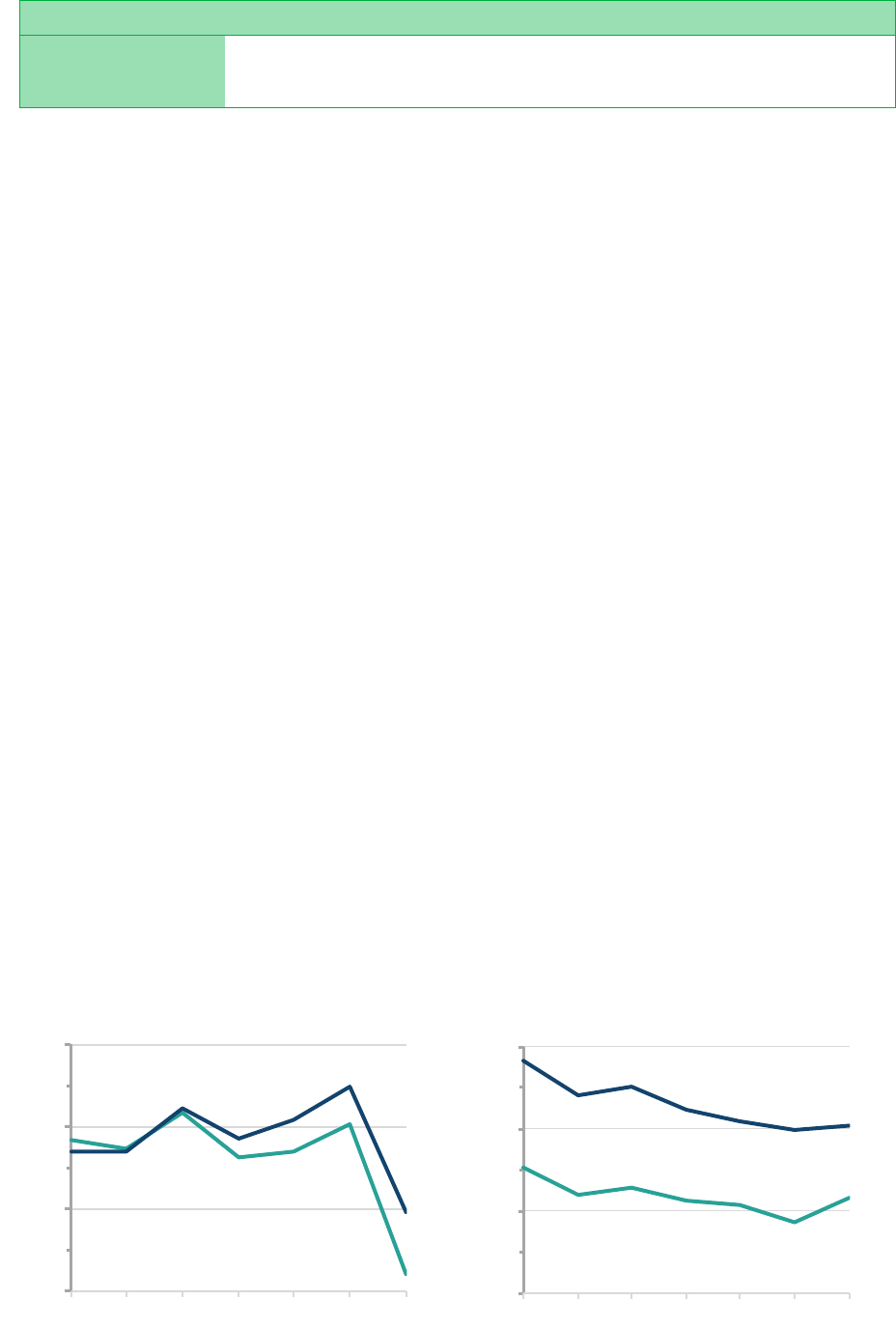
Digest of Rural England: 8 – Energy
64
Table E-1: Total non-domestic electricity consumption (GWh) in England split by the Local
Authority Rural-Urban Classification (2015 to 2021)
2015 2016 2017 2018 2019 2020 2021
Predominantly Rural
31,500
30,400
31,200
31,000
30,300
27,900
29,500
Predominantly Urban 96,400 93,200 93,800 93,600 91,300 80,100 84,200
Energy consumption: Gas
Gas data is divided between domestic and non-domestic categories according to the gas
consumption according to an industry standard cut-off value, thereby risking some small non-
domestic premises being miss-classified (Note E-8). Here we address domestic consumption first
followed by non-domestic consumption.
The proportion of total domestic gas consumption assigned to Predominantly Rural Local
Authorities remained around 18.5% across the period 2015 to 2021 (Note E-1). In the non-
domestic setting, over the same time period, Predominantly Rural Local Authorities accounted on
average for 21.2% of total non-domestic gas consumption.
Figure E-2 (left-hand chart) shows that the average median domestic gas consumption in was
similar in Predominantly Rural and Predominantly Urban areas between 2015 and 2017. But from
2018 onwards the average median domestic gas consumption was lower in Predominantly Rural
areas than in Predominantly Urban areas. In 2019, the average median domestic gas consumption
was 11,800 kWh per meter in Predominantly Rural areas and 12,000 kWh per meter in
Predominantly Urban areas. Between 2019 and 2020 this average median gas consumption rose
by 170 kWh per meter in Predominantly Rural areas and by 200 kWh per meter in Predominantly
Urban areas. The stay-at-home measures in spring 2020 used to combat the spread of COVID-19
will have contributed to this increased consumption. However, with households often starting to
reduce the amount they use their central heating as spring progresses, a larger contribution to this
increase probably came from the second wave of restrictions in November and December 2020.
Figure E-2: Line chart showing the estimated average median gas consumption (kWh per
meter) by broad Local Authority Rural-Urban Classification 2015 to 2021 (Note E-2, Note E-
6)
The left-hand chart is for Domestic properties and the right-hand chart is for Non-domestic
properties. Note that the scale on the y-axis differs between the two charts.
11,000
11,500
12,000
12,500
2015 2016 2017 2018 2019 2020 2021
Urban
Rural
Median consumption
(kWh per meter
)
Domestic
130,000
140,000
150,000
160,000
2015 2016 2017 2018 2019 2020 2021
Median consumption
(kWh per meter)
Urban
Rural
Non-domestic
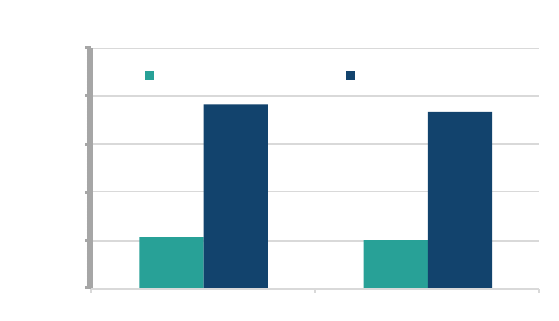
Digest of Rural England: 8 – Energy
65
Average median domestic gas consumption fell dramatically in 2021 in both Predominantly Rural
and Predominantly Urban areas. In Predominantly Rural areas it fell to 11,100 kWh per meter, a
drop of 910 kWh per meter (7.6%). Whilst in Predominantly Urban areas the drop was slightly
smaller at 770 kWh per meter (6.3%) and stood at 11,500 kWh per meter. This drop reflects a
customer reaction to rising energy prices and them being more selective about when to use their
central heating because of the rising cost of doing so.
As Figure E-3 shows, in 2020 the total domestic gas consumption was 53,200 GWh across the 84
Predominantly Rural Local Authorities, whilst in 2021 across the same 84 Local Authorities the
total consumption was 50,500 GWh. This is a 5% reduction in total consumption despite there
being an additional 55 thousand gas meters (consumers) contributing to this total consumption.
There was also a 5% reduction in total Predominantly Urban domestic gas consumption despite an
additional 63 thousand meters (consumers) in 2021. Indeed, in every Local Authority (Note E-3)
the total domestic gas consumption decreased between 2020 and 2021.
The average median non-domestic consumption is lower in Predominantly Rural areas than in
Predominantly Urban areas (Figure E-2 - right-hand chart). In 2015 the average median non-
domestic gas consumption was 145,300 kWh per meter in Predominantly Rural areas and 158,300
in Predominantly Urban areas. Between 2015 and 2020 the average median non-domestic gas
consumption in Predominantly Rural areas fell by 6,600 kWh per meter (4.6%). Over the same
period the average median non-domestic gas consumption in Predominantly Urban areas fell by
8,400 kWh per meter (5.3%).
The drop in median non-domestic gas consumption between 2019 and 2020 was twice as big in
Predominantly Rural areas as it was in Predominantly Urban areas (2,000 kWh per meter or 1.4%,
compared to 1,000 kWh per meter or 0.7%). Between 2020 and 2021, the average median non-
domestic gas consumption increased by 2,900 kWh per meter (2.1%) in Predominantly Rural areas
despite the increase in the cost of gas over this period. By contrast, the average median non-
domestic gas consumption increased by only 500 kWh per meter (0.3%) in Predominantly Urban
areas.
Figure E-3: Bar chart showing the estimated total domestic gas consumption (GWh) by
broad Local Authority Rural-Urban Classification 2020 and 2021 (Note E-2, Note E-6)
The legend is presented in the same order as the clusters of columns. The number of meters
contributing to this total consumption is greater in 2021 than in 2020.
0
50,000
100,000
150,000
200,000
250,000
2020 2021
Predominantly Rural Predominantly Urban
Total consumption (GWh
)

Digest of Rural England: 8 – Energy
66
Energy Consumption explanatory notes
• Note E-1
Tables showing additional data and the data behind the figures in this section are available in the
Energy
data tables.
• Note E-2
The figures for median electricity or gas consumption per meter point are presented in kilowatt hours (kWh).
The figures for total gas consumption are presented in gigawatt hours (GWh). 1GWh = 1 million kWh.
Median electricity consumption figures in the commentary have been rounded to the nearest 10 kWh per
meter. Annual median gas consumption figures have been rounded to 100 kWh per meter, while year to year
changes in gas consumption have been rounded to the nearest 10 kWh per meter.
• Note E-3
There is no mains gas on the Scilly Isles.
• Note E-4
Electricity consumption figures are based on meter level electricity consumption data provided by data
aggregators (who compile this data behalf of electricity suppliers).
Electricity data is divided between domestic and non-domestic categories according to the meter’s profile
class. Domestic consumption is based on Non-Half Hourly (NHH) meters with profiles 1 and 2 (these are the
standard domestic and economy 7 tariffs respectively). Non-domestic consumption is based on NHH meters
with profiles 3 to 8 and all Half Hourly meters. In addition, profile 1 and 2 meters are re-allocated to the non-
domestic sector if their annual consumption is greater than 100,000 kWh; or if their annual consumption is
greater than 50,000 kWh and the address information for meter suggests that it is non-domestic.
For more information about these electricity consumption statistics, see Section 3 of the BEIS / DESNZ
guidance note: Sub-national methodology and guidance 2023
• Note E-5
These estimates used in this analysis are weather-corrected. This means that the effect of differences in
weather conditions between years has been removed to provide more like for like comparisons over time. A
non-weather corrected version of these statistics is also published for the years 2015 and 2021 and can be
found at: Regional and local authority gas consumption statistics
• Note E-6
The gas consumption years used in this analysis are as follows:
Year Gas Year
2015
October 2014 – September 2015
2016
mid-July 2016 – mid-July 2017
2017
mid-June 2017 – mid-June 2018
2018
mid-May 2018 – mid-May 2019
2019
mid-May 2019 – mid-May 2020
2020
mid-May 2020 – mid-May 2021
2021
mid-May 2021 – mid-May 2022
• Note E-7
BEIS / DESNZ built a new processing system for producing the 2021 subnational gas consumption statistics
and revised their statistics for the years 2015 – 2020. This Defra analysis uses the revised numbers and has
been restricted to only including 2015 onwards to ensure we are using consistent data.
• Note E-8
BEIS / DESNZ gas consumption figures are based on meter level gas consumption data provided by
Xoserve (who compile meter level data from gas shippers, who in turn receive the data from gas suppliers).
Xoserve provide annualised estimates of consumption (AQs) for all gas meters. Xoserve provide the AQs on

Digest of Rural England: 8 – Energy
67
a weather corrected basis by a process which accounts for regional temperatures and wind speed and
incorporates trends.
The gas meters are classified as being domestic or non-domestic according to their (weather-corrected) gas
consumption. Those with an annual consumption less than the industry cut-off of 73,200 are classified as
domestic and the rest are classified as non-domestic. This means that some small industrial and commercial
consumers will be classified as domestic.
For more information about these gas consumption statistics, see Section 2 of the BEIS / DESNZ guidance
note: Sub-national methodology and guidance 2023
.
• Note E-9
Where a Local Authority area contains one or more major power station or other large industrial consumer
the consumption of these sites has not been included in the meter level gas consumption data due to
complexities in their billing arrangements
.

Digest of Rural England: 8 – Energy
68
Appendix 1: The 8 thematic reports that make
up the Statistical Digest of Rural England
(and the topics included within them)
1. Population
A. Population level and change
B. Population age profile
C. Ethnicity
D. Internal migration
E. Local Authority population data
2. Housing
A. Housing stock: age and type
B. Housing stock: additions
C. House prices
D. Housing stock: affordable housing
E. Second and empty homes
F. Homelessness
G. Land use change for housing
3. Health and Wellbeing
A. Life expectancy
B. Wellbeing
C. NHS Dentistry provision
D. General Practices
E. Childcare provision
F. Loneliness
G. Volunteering and charity
4. Communities and Households
A. Deprivation
B. Poverty due to low income
C. Household expenditure
D. Police recorded crime and outcomes
E. Crime surveys: local police and businesses
F. Feelings about the local neighbourhood
5. Connectivity and Accessibility
A. Broadband
B. Travel behaviours
C. Access to personal transport
D. Access to services
E. Home working
6. Education, Qualifications and Training
A. Secondary education attainment
B. School inspections
C. Free school meals
D. Alternative and specialist education provision
E. Progression to higher education
F. Apprenticeships and on-the-job training
G. Workforce education level
7. Rural Economic Bulletin
A. Employment
B. Earnings
C. Redundancies
D. Claimant count - Jobseeker’s Allowance
E. Output and productivity measured by Gross
Value Added (GVA)
F. Businesses - status, structure and
composition
G. Innovation and investment
8. Energy
A. Fuel poverty
B. Energy Performance Certificates: average
Energy Efficiency Score
C. Energy Performance Certificates: achieving
energy efficiency category C
D. Energy costs
E. Energy consumption
Each of the 8 themes also has their own set
of supplementary data tables that include
the larger source data that could not be
included in the presented document. The
chapter headings above are hyperlinked to
the home page for that specific digest
theme. The supplementary tables can be
accessed from these home pages.
There is a further document including the
individual Local Authority data tables, which
have been separated for ease of use.
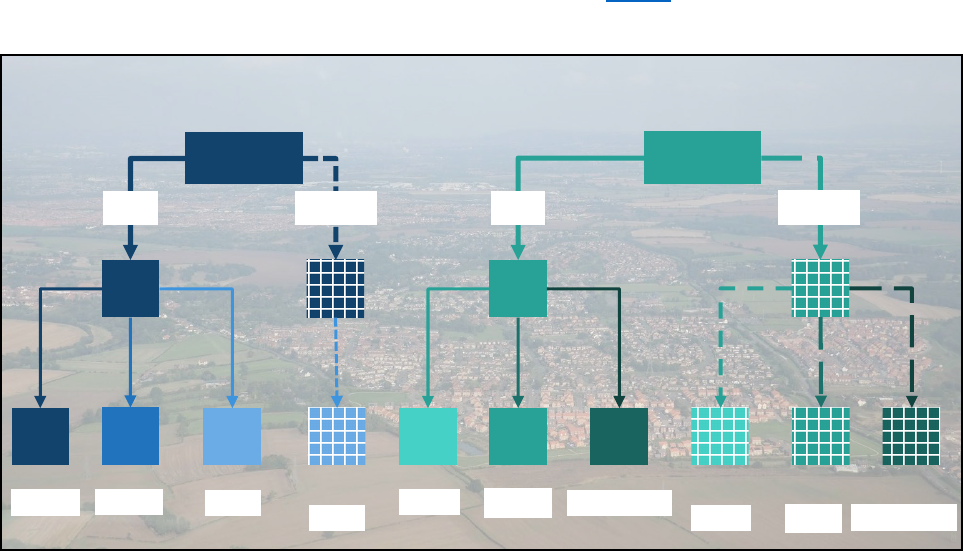
Digest of Rural England: 2 – Housing
69
Appendix 2: Defining Rural areas
Wherever possible, the Rural-Urban Classification is used to distinguish Rural and Urban areas.
The Classification defines areas as Rural if they fall outside of settlements with more than 10,000
resident population.
Census Output Areas are the smallest areas for which data are available from Censuses. These
Census Output Areas are assigned to one of four Urban or six Rural categories (Figure X-1) based
on dwelling densities. Those described as “in a sparse setting” reflect where the wider area is
sparsely populated (again based on dwelling densities). From Census Output Areas, other small
area geographies can be classified based on how they map to Census Output Areas (such as
Lower Super Output Areas (LSOAs), Wards, and postcodes – Note 1
).
Figure X-1: Classifying Rural and Urban areas for small geographical areas
A map showing the distribution of the Rural and Urban Census Output Areas is shown in Figure X-
2.
When data are not available at a small geographical scale, it may be possible to apply the Rural-
Urban Local Authority Classification or a similar classification for other larger geographies. This
classification categorises districts and unitary authorities on a six-point scale from Rural to Urban.
It is underpinned by Rural and Urban populations as defined by the Census Output Area
Classification. A map of the geographical distribution of the Rural and Urban Local Authorities is
shown in Figure X-3.
However, the Local Authority Classification also considers some Urban areas as Hub Towns (with
populations of between 10,000 and 30,000). These Hub Towns have met statistical criteria (based
on dwelling and business premise densities) to be considered hubs for services and businesses for
a wider rural hinterland and their populations are therefore classified as effectively Rural for the
purposes of determining the classification of the authority.
Urban
Rural
Minor
conurbation
City
& town
In a sparse
setting
City
& town
Town
& fringe
England
Not
sparse
Town
& fringe
Hamlets & isolated
dwellings
In a sparse
setting
Major
conurbation
Not
sparse
Hamlets & isolated
dwellings
Villages
Villages
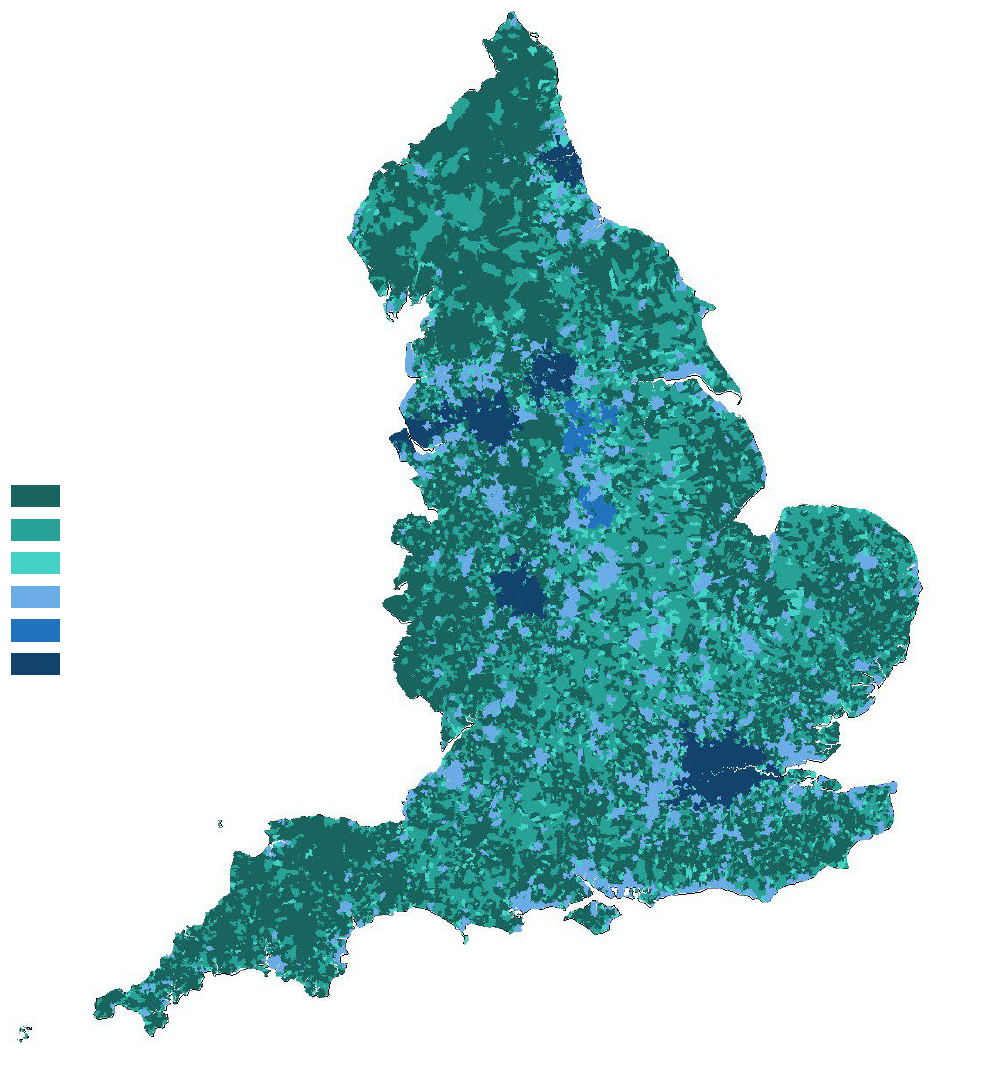
Digest of Rural England: 2 – Housing
70
Figure X-2: Map of the 2011 Rural-Urban Classification for Census Output Areas in England
2011 Rural-Urban Classification
Rural Hamlet and Isolated Dwelling
Rural Village
Rural Town and Fringe
Urban City and Town
Urban Minor Conurbation
Urban Major Conurbation
© Crown Copyright and database rights 2023
Ordnance Survey Licence No. 100022861
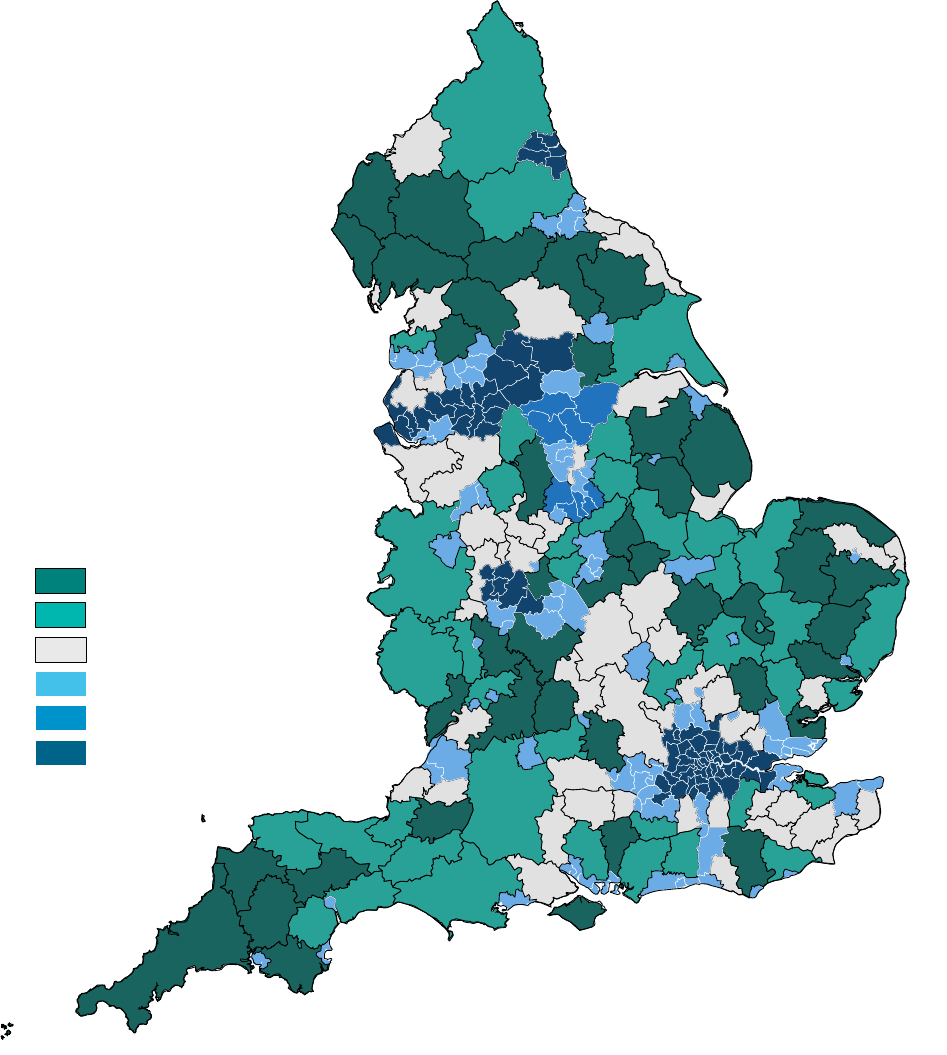
Digest of Rural England: 2 – Housing
71
Figure X-3: Map of the 2011 Rural-Urban Classification for Local Authority Districts and
Unitary Authorities in England
Under the classification, which is shown in Figure X-4, each Local Authority is assigned to one of
six categories on the basis of the percentage of the total resident population accounted for by the
combined Rural and Hub Town components of its population and its 'conurbation context'. The
Local Authority Classification categories are frequently aggregated to ‘Predominantly Rural’, ‘Urban
with Significant Rural’ and ‘Predominantly Urban’ as shown on Figure X-4.
L o c a l A u t h o r i t y
R u r a l - U r b a n C l a s s i f i c a t i o n
M a i n l y R u r a l
L a r g e l y R u r a l
U r b a n w i t h S i g n i f i c a n t R u r a l
U r b a n w i t h C i t y a n d T o w n
U r b a n w i t h M i n o r C o n u r b a t i o n
U r b a n w i t h M a j o r C o n u r b a t i o n
© C r o w n C o p y r i g h t a n
d
d a t a b a s
e
r i g h t s 2 0 2 3
O r d n a n c e S u r v e y L i c e n c e N o . 1 0 0 0 2 2 8 6 1

Digest of Rural England: 2 – Housing
72
Figure X-4: 2011 Rural-Urban Classification for Local Authority Districts and Unitary
Authorities in England
It should be noted that the Local Authority Rural-Urban Classification is based on populations and
settlement patterns, not on how much countryside there is. Authorities classified as Urban may
have wide areas of countryside and may have sizeable Rural populations. The classification has
been made according to the proportions of the population residing in Urban settlements and
outside Urban settlements. More information on the classifications can be found at: The Rural-
Urban Definition.
Defining Rural areas explanatory notes
• Note 1: Defining Super Output Areas and Wards
Census Output Areas (OAs) were created for publication of the results of the recent Censuses. They cover
around 125 households. In practice few datasets are produced at OA level. However, other larger
geographies can be built up from OAs. These include Lower Layer Super Output Areas (LSOAs) which
typically contain 5 OAs, so contain approximately 625 households or a population of approximately 1,500
and a minimum 1,000. Their Rural-Urban Classification is based on the majority category of OAs they
contain. Some other geographies, for example postcodes are classified based on the location of their central
point and the classification of respective OA.
• Note 2: Accessibility of Figure X-2
We accept that this map might not be accessible for all users, but it is difficult to develop a map containing
six colours that will provide enough contrast between all colours to enable every user to see them, especially
when the shaded areas are small. Separate maps (showing only three levels of shading) for Rural and Urban
areas are available on request from: rural.statistics@defra.gov.uk
Predominantly Rural
50% or more of the resident population lives
in rural areas or rural-related
hub towns
Mainly
Rural
80% or more
population rural
including hub towns
43 Authorities
Largely
Rural
50 to
79%
population rural
including hub towns
41
Authorities
Predominantly Urban
74% or more of the resident population lives in Urban areas
Urban with
City and
Town
Less than 26%
population rural
including hub towns
91 Authorities
Urban with
Minor
Conurbation
Less than 26%
population rural
including hub towns
9 Authorities
Urban with
Major
Conurbation
Less than 26%
population rural
including hub towns
75 Authorities
Urban with
Significant
Rural
26 to 49%
population rural
including hub towns
50 Authorities
More rural population More urban population
England

